Here we archive some of the older entries from SunInfo:
but here we show only those from 2018 onwards (Want
pre 2018?)
This is where we place the more recent older stories from the SunInfo page after they have been
removed from the main page because we do have to make room for more recent news. So, if you want to look for something you
once saw
on SunInfo which is not there now, here's the place to look - alongside
SunInfo Entry Archive 1.htm. Entries here
are removed when their topic is less immediate or relevant- so they will not
necessarily be in date order. They are frequently dated with their original dates of insertion
or those of their amendment on the
SunInfo page and they are placed here in order of their removal from the
SunInfo
web page. NB: Please note that links in this archive that
are made to entries on other external websites are not maintained by SunInfo so
occasionally some really old links here may not work.
Athens' Tower of the Winds
Opens The so-called Horologion of Andronikos
Kyrrhestes in
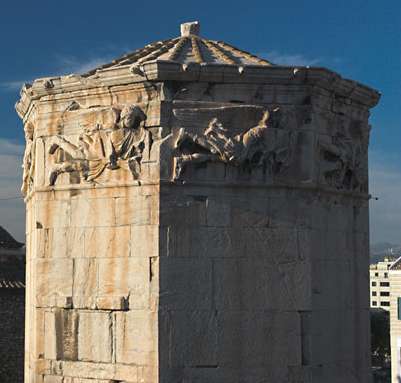 Athens
is an octagonal Pentelic marble clocktower and early timepiece situated in
the Roman Agora. It still features a combination of sundials, a water
clock, and it probably held a weather vane too. Thought by some to have
been built by Andronicus of Cyrrhus around 50 BC but possibly by another
even as early as the 2nd century BC, the Athens Ephorate of Antiquities began
cleaning and conserving the structure in 2014 and this has just been
completed! The North American Sundial Society NASS has an excellent
article about this fascinating building. Read it
Here
Athens
is an octagonal Pentelic marble clocktower and early timepiece situated in
the Roman Agora. It still features a combination of sundials, a water
clock, and it probably held a weather vane too. Thought by some to have
been built by Andronicus of Cyrrhus around 50 BC but possibly by another
even as early as the 2nd century BC, the Athens Ephorate of Antiquities began
cleaning and conserving the structure in 2014 and this has just been
completed! The North American Sundial Society NASS has an excellent
article about this fascinating building. Read it
Here
30.08.16
The Dollar Academy Sundial
Dollar is one of the 'Hillfoots' Villages of Clackmannanshire
 lying as it
does between Stirling and St Andrews. Its famous school, the
Dollar Academy lies in the town and its main school building is a
striking neoclassical design by the eminent Scottish architect William
Henry Playfair.
lying as it
does between Stirling and St Andrews. Its famous school, the
Dollar Academy lies in the town and its main school building is a
striking neoclassical design by the eminent Scottish architect William
Henry Playfair.
When an additional school building was needed for modern
languages and economics, the Westwater building was designed and
completed at the end of June 2015. It is named after George Westwater, a
private in the 1/4th Battalion, Royal Scots QER, who was killed at
Gallipoli on 28 June 1915 at the age of 21, almost one 100 years to the
day prior to the building’s completion.
In time for the formal opening on the 23 March 2016 by
Lord Brodie, a declining vertical sundial incorporating a sphere, was
commissioned. The sphere demonstrates how the sun's light travels round
the Earth in the course of the day. The two sided panel carries text on
the reverse showing the Equation of Time and the longitude and latitude
and the back half of the sphere emerges from the the reverse of the
panel.
See more
here and
here
02.10.16
|
The first sundial to be made in Montreal?
An
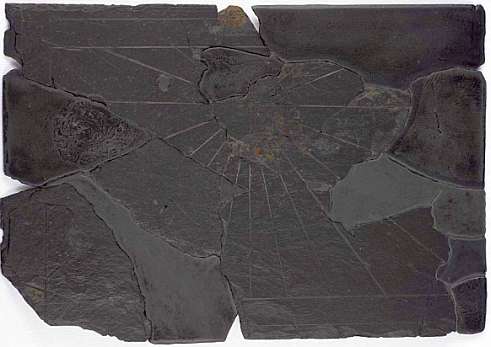 intriguing
question. In April 2009 a fragment of a sundial was displayed at the
Pointe-à-Callière museum in Montreal. Thought to date from the late
17thC and with a delineation that despite displaying lines above the horizon
shows it might have adorned a wall on a building on the estate of Montreal's
fifth appointed (rather than acting!) governor Louis-Hector de Callière, it
may even be the first sundial to be made in Montreal. intriguing
question. In April 2009 a fragment of a sundial was displayed at the
Pointe-à-Callière museum in Montreal. Thought to date from the late
17thC and with a delineation that despite displaying lines above the horizon
shows it might have adorned a wall on a building on the estate of Montreal's
fifth appointed (rather than acting!) governor Louis-Hector de Callière, it
may even be the first sundial to be made in Montreal.
Read more of this enigmatic discovery
►here
Image©Montréal Museum of Archaeology and
History, 2009 |
Enjoy a spell at the Gaol House!
That is enjoy the outside of the Gaol House in
 King's
Lynn, Norfolk! Sitting as it does next to the wonderful Town Hall
in the area of the Saturday Market, it sports on its roof line, a
majestic vertical west declining sundial dated, it is believed, to 1784
and delineated by S Bunnett. It has as its motto 'Tempus Fugit'. Click
on the image for a close up of the dial face. The dial declines 10
degrees West of South and is marked with tall Roman lettering, quarter
hours with the half hours having inward extending trefoil ended lines
and rather less commonly, with an individual marker for each half hour
engraved in the chapter ring. A really elegant dial.
(Photos
© VL Thomson 2016)
King's
Lynn, Norfolk! Sitting as it does next to the wonderful Town Hall
in the area of the Saturday Market, it sports on its roof line, a
majestic vertical west declining sundial dated, it is believed, to 1784
and delineated by S Bunnett. It has as its motto 'Tempus Fugit'. Click
on the image for a close up of the dial face. The dial declines 10
degrees West of South and is marked with tall Roman lettering, quarter
hours with the half hours having inward extending trefoil ended lines
and rather less commonly, with an individual marker for each half hour
engraved in the chapter ring. A really elegant dial.
(Photos
© VL Thomson 2016)
31.10.16
|
David Payne's suggestion for a
Noon Mark gets approval!!
Regular visitors to this site will know of David
 Payne's
extraordinary project to place sundials of various types along the
Burlingham Woodland Walks in Norfolk. The walks are about 7 miles east
of Norwich and they can be accessed at a number of start points, including
that from North Burlingham. Payne's
extraordinary project to place sundials of various types along the
Burlingham Woodland Walks in Norfolk. The walks are about 7 miles east
of Norwich and they can be accessed at a number of start points, including
that from North Burlingham.
Click the thumbnail for the impressive list of those sundials currently in
place or under construction. The next one will make use of
an existing
15 ft high
beacon which was erected in 2012 to mark the Queen's Jubilee on
playing fields nearby. This
will be a Noon mark, with an analemma on the ground that marks the months,
solstices and equinoxes.
We await further details with interest. SunInfo will provide
progress reports as we have them. Contact the
webmaster if you wish to
sponsor any of the dials.
07.01.16, 15.01.16
|
Capt. Michael Francis Aston Maltin, DFC. Wartime pilot of
Spitfires and then Lancaster bombers,
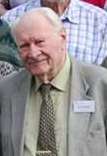 civilian
pilot for BOAC and then British Airways and a long time horologist and
sundial enthusiast, died peacefully in North Woodchester on 25th January
2015, aged 94 years with son Christopher, daughter Elaine and his
beloved Vera by his side. Michael was the son of the late Rev Arthur
Frank Maltin, former vicar of Stroud and of Amberley, the much loved
husband of the late Christine Maltin and a cherished father, grandfather
and great-grandfather. A lovely, unassuming man and Spitfire
fanatic who will be much missed by those who had the privilege to know
him. Read
SunInfo's Obituary to a great man.
The 2015 BSS Newbury Meeting included a fitting display to the memory of the
life and times of Michael.
civilian
pilot for BOAC and then British Airways and a long time horologist and
sundial enthusiast, died peacefully in North Woodchester on 25th January
2015, aged 94 years with son Christopher, daughter Elaine and his
beloved Vera by his side. Michael was the son of the late Rev Arthur
Frank Maltin, former vicar of Stroud and of Amberley, the much loved
husband of the late Christine Maltin and a cherished father, grandfather
and great-grandfather. A lovely, unassuming man and Spitfire
fanatic who will be much missed by those who had the privilege to know
him. Read
SunInfo's Obituary to a great man.
The 2015 BSS Newbury Meeting included a fitting display to the memory of the
life and times of Michael.
25.02.15
Martins Gills of Riga in Latvia has an interesting
website which
 contains
more than two hundred pages altogether but within that, no fewer than 41
pages of lovely images of dials around the world, several other links about
dials and dialling and a map showing the location of more than twenty dials
in Latvia. Saules pulkstensis is the Latvian for 'Sundial' and the
web site is in Latvian but Google Translate does a reasonable job of making
it understandable to those who do not read the language. Well worth a
look. It may be found
►here. contains
more than two hundred pages altogether but within that, no fewer than 41
pages of lovely images of dials around the world, several other links about
dials and dialling and a map showing the location of more than twenty dials
in Latvia. Saules pulkstensis is the Latvian for 'Sundial' and the
web site is in Latvian but Google Translate does a reasonable job of making
it understandable to those who do not read the language. Well worth a
look. It may be found
►here. |
|
Martins Gills has a second website which
describes a unique post card dial and a few of the dials that he has
designed himself. Have a look
►
here
Martins presentation at the recent 2014 BSS Conference may be
viewed
►here
(4MB PDF) |
The extraordinary (and to many, the appalling) comments made by the BSS's Council at the
April 2013 Edinburgh
BSS Conference contributed to no fewer than 340 visits to this site in April 2013 alone
and a further 364 in May with 51 of the visitors in May spending more that half
an hour on the site - 37 of those for more than an hour and 42 for more
than one hour in June! Not surprising given the facts.
Now we have received
copies of the text of quite astonishing emails from the Council
about their attempts to restrict this website and about the way the BSS
President (no less) has been bullied by this Council!
If you were a delegate at the April 2013 Edinburgh Conference, our advice is
not to dismiss as baseless the criticisms that had been made about the present Council's 'Integrity' until you know all the facts. We shall have more to say on this not least on the strange matter of a misinformed and complaining letter
sent by the BSS Chairman which of course prompted a robust correcting response
and which on its receipt was swiftly followed by the Council back-tracking
and saying: (and remember it was BSS who initiated this particular correspondence) 'We shall not engage in such
correspondence'!
Pleading the 5th or what?
All that glisters is most certainly not gold in all this. It's really gratifying that so many
just do not believe what was said
by the Council at Edinburgh - nor what was included in an insert with the June Bulletin
- and have turned to this web page
and even directly to the webmaster for information. It's also pleasing that so many
spend such a long time on this site in the process; many for more than one
hour!. Thanks so much for coming and please do keep coming back -
there's still a lot more to add - and especially more to comment
on! You really will find facts here.
 Long
Term future of the BSS Library FINALLY assured. BSS members will have noted the
recent and welcome change of heart by the Council of BSS Trustees that was
announced by BSS Librarian Nick Orders in the December 2014 Newsletter. In this the security of the BSS
Library was affirmed at last and the on-going commitment of the trustees to its support and maintenance was finally confirmed.
Long
Term future of the BSS Library FINALLY assured. BSS members will have noted the
recent and welcome change of heart by the Council of BSS Trustees that was
announced by BSS Librarian Nick Orders in the December 2014 Newsletter. In this the security of the BSS
Library was affirmed at last and the on-going commitment of the trustees to its support and maintenance was finally confirmed.
As a result of this BSS President Christopher Daniel has decided that his loaned
collection is not now at risk of unauthorised disposal and accordingly at the
2015 Conference he confirmed his intention to leave his highly valuable works at
the BSS Library in Bromley House, Nottingham.
As a part of that address Christopher
disclosed that he had asked Frank King, as Chairman (and Chris Williams, as
Secretary) to put their signatures to the document to endorse it.
Churlishly in the circumstances, it
seems they refused to do so. Members will simply not understand this
extraordinary attitude, one which has already led to such dissension within the
Society. Nor will they understand why such earlier misguided calls for the
dissolution of the library had not been thrown out MUCH earlier by the Council.
Blunders in
today's management of the BSS seem to many members to be occurring far too
frequently and the absence of any apology is not only worrying, it is
astonishing.
A few copies of the donation document
were circulated - see this copy below.

To see more of the 2015 BSS Conference please click
here
13.04.13, 09.05.15, 22.06.15
NOW, Christopher Daniel has replied
to the unfounded comments made in a Member's September
letter to
 the
Council which has already been reported below and which
is to be seen in our special page about the
Books Issue. Read Christopher's reply
here. It
of course confirms what all members of the Society - except apparently the
complainant - already knew. Yet most BSS Members will surely also be
baffled as to why such comments - which are entirely irrelevant to the
Books issue and are in any case incorrect - came to be raised in the first place.
the
Council which has already been reported below and which
is to be seen in our special page about the
Books Issue. Read Christopher's reply
here. It
of course confirms what all members of the Society - except apparently the
complainant - already knew. Yet most BSS Members will surely also be
baffled as to why such comments - which are entirely irrelevant to the
Books issue and are in any case incorrect - came to be raised in the first place.
17.11.14 Published with permission
Yet again, the BSS Council says 'take it
or leave it'. Prominent BSS Member and fellow
academic, Dr Martin Jenkins, recently wrote to BSS Chairman Frank King
suggesting a meeting to help resolve the matter of the ownership of the
President's books. The approach was rebuffed and the Chairman's reply was once again
only to 'urge Chris to accept the original
offer'. This was the unreasonable, non-negotiated 'take it or leave it' offer made a
long time ago. There was no mention let alone discussion of Christopher's
generous alternative 50 year loan offer which would be of such importance
to the membership. BSS Members will surely be appalled at what they
must see as the clear contempt being shown by their Council over this
important issue. Not only that but can anyone really believe that
even now the entire BSS
library contents are STILL at risk of an ill-considered
majority decision by any board of trustees in the future. This is unacceptable.
04.11.14
Now in connection with the matter of
Christopher Daniel's Books, SunInfo has received
two copies of what can only be described as an
astonishing document, one
written in
support of the Council by a BSS Member. See if you agree that it demonstrates the
paucity of logic that such a stance brings with it and the need of some to resort
to unnecessary and even quite unfounded criticism in an attempt to lend
what might be considered misguided support to the Council's
argument. The ordinary
BSS Member will surely be aghast at this sort of attack which does the
Council no credit over its handling of the matter of Christopher's Books.. Visit our special
page on this matter for more details
here.
Then look at just how much Christopher has actually written to date
here
04.11.14
Some of the BSS Membership have now responded
to the Council's extraordinary letter that was emailed to them by Frank
King on 11.09.14. Follow this wholly unnecessary saga at our
special page
devoted to the way in which the BSS Council is still treating its
eminent President, Christopher Daniel MBE
here. Latest
news is at the bottom of that page. Or simply jump to
the membership's
response now.
30.09.14
Still the comments come in about the
issue of Christopher Daniel's books and the BSS
library. The Council recently issued members with what some see
as an almost completely incorrect
summary of the position, because it claims that it is Christopher who will
not negotiate and who blocks acceptance of a deal.. To many however, a
deeper analysis of it indicates that:
By anybody's standards it is surely the Council of BSS who have bullied Christopher, it is they who have
twice refused to meet him at his home on a one to one basis and it is they
who tried twice to insist that he travels to Cambridge when he now no
longer drives and at 81 finds train journeys a problem.
Then the Council has tried to insist that they, and only they, determine
the agreement process. It is they (not Christopher) who refuse to
negotiate, it is they who try to insist on no lawyers being involved and
it is they who have imposed their own arbitrary deadline for ‘agreement’ -
but, be it noted, only an agreement on their terms – after which they are
now trying to suggest that the matter is closed.
The reaction of the Membership was swift and predictable:
"[We] are now angry enough at Frank and Council to support a revolt!
Frank's last dismissive diatribe is not acceptable. The OED defines
"amicable" as "done in a friendly spirit" implying such applies to all
parties and has been the word applied by Frank many times to achieving
settlement of this matter. When I asked Chris Williams at the AGM about
the problem, his attitude toward me was not amicable. Nothing I am aware
of from Frank about this issue has been amicable".
extract published with permission
And Now (1),
in another twist
and three months after first being formally asked for its evidence to support
its stance that Christopher Daniel's books were indeed a gift, the Society had to be asked again. That was dated 16th July and
there was still no reply from BSS more than another month later!!!!! Members must now be wondering if this 'evidence'
really does exist. See the latest requesting letter from the solicitor
►here.
And Now (2), in
yet another twist it turns out that the Council, despite
having spent (in 2013 alone),
roughly the equivalent of 117
membership subscriptions on two London Legal firms' advice to change the
status of the charity to a CIO (Info
here), they appear only later to have discovered that they do not
own the BSS Trademark Logo! You really could not make this up.
And Now (3), One opinion seen by
SunInfo
suggests that it seems
that charity law fully provides for gifts to be returned to their original
donor! So, no matter what argument BSS chooses, there appears to be no
excuse not to return Christopher's books!!
And Now (4),
Keen to ensure that they can continue to use the BSS logo when the
new CIO (Info here)
came into effect, the trustees of BSS proposed a
swap of books for title to the logo - take it or leave it. So now we know. The
trustees are NOT after all prevented from returning Christopher's books! Just
why has this issue ever arisen and just what does it say about trustee
'competence'?
 We celebrate John Harrison
The 3rd April 2018 would have been his 325th birthday.
We celebrate John Harrison
The 3rd April 2018 would have been his 325th birthday.
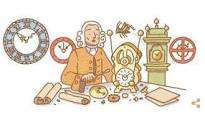 Courtesy
(and copyright) of Google Inc who on the day placed this excellent
Doodle on their website, we too would like to mark the life and more
importantly the determination of self-taught John Harrison, winner of
the 1714 Longitude Prize which had been put up to prevent naval
disasters. The Board of Longitude offered a reward of £20,000 to anyone
who could devise a navigational instrument that could be used to
determine a ship's longitude to within 30 miles even after a long sea
voyage.
Courtesy
(and copyright) of Google Inc who on the day placed this excellent
Doodle on their website, we too would like to mark the life and more
importantly the determination of self-taught John Harrison, winner of
the 1714 Longitude Prize which had been put up to prevent naval
disasters. The Board of Longitude offered a reward of £20,000 to anyone
who could devise a navigational instrument that could be used to
determine a ship's longitude to within 30 miles even after a long sea
voyage.
Harrison set to work in 1728 and completed it seven years later in 1735.
He followed up this feat with three more watches that were even smaller
and more accurate than his first.
03.04.18
Dial of the Month. Church of St.
Vincent Ferrer, Ragusa, Sicily.
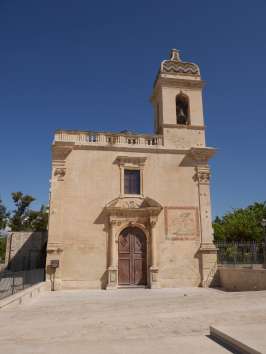 This
month we show the sundial that is on the facade of the Church of St.
Vincent Ferrer in Ragusa, Sicily. The dial is delineated in Italian hours
(shown in black). The red lines show the equinox and mid summer
declination lines and the
Taurus/Cancer zodiac symbols. The dial lies at 36.93N, 14.75E and appears
to decline approximately S105 degs W.
This
month we show the sundial that is on the facade of the Church of St.
Vincent Ferrer in Ragusa, Sicily. The dial is delineated in Italian hours
(shown in black). The red lines show the equinox and mid summer
declination lines and the
Taurus/Cancer zodiac symbols. The dial lies at 36.93N, 14.75E and appears
to decline approximately S105 degs W.
At the bottom are the words 'LINE S. VINC. Ferreri'.
Click the image for two photographs.
25.09.16 Photo
©copyright VL
Thomson, 2016.
A Cumbrian Riders' Dial can be found in the lovely churchyard of Hall
Waberthwaite in
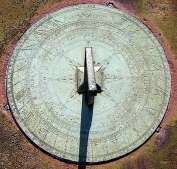 Cumbria
on the shore of the Esk Estuary. Installed in 1830 in memory of the
Rev J Stanley, it is mounted on a pedestal five or so feet high, placed
there for horse riders!
Cumbria
on the shore of the Esk Estuary. Installed in 1830 in memory of the
Rev J Stanley, it is mounted on a pedestal five or so feet high, placed
there for horse riders!
The dial is well made by Watkins & Hill and is nicely and accurately
delineated. Set on a moulded square plinth, turned upright, and moulded
square top with inset circular brass plate and gnomon.
Read about it in a recent Guardian article
17.08.16
The Istiwak clock that shows
dhuhur and asr prayer times. The Grand Mosque of
 Surakarta
in Central Java still uses a sundial, locally known as an ‘istiwak
clock’, to determine the exact time for Muslims in the city to perform
dhuhur (midday) and asr (afternoon) prayers. Surakarta
in Central Java still uses a sundial, locally known as an ‘istiwak
clock’, to determine the exact time for Muslims in the city to perform
dhuhur (midday) and asr (afternoon) prayers.
Although Muslims now use modern clocks for prayer time guidance, the
istiwak clock remains the main attraction for people to visit the
Surakarta Grand Mosque.
Read more about this interesting dial from the Jakarta Post.
30.12.16 |
 "Ladies and gentlemen, we call
time on a 50-year-old scam, in which a small number
of
"Ladies and gentlemen, we call
time on a 50-year-old scam, in which a small number
of
 corrupt
and politicized scientists, paid for by scientifically-illiterate
governments panicked by questionable lobby-groups funded by dubious
billionaires and foreign governments intent on doing down the West,
and egged on by the inept and increasingly totalitarian news media,
have conspired to perpetrate a single falsehood: that the science was
settled.
corrupt
and politicized scientists, paid for by scientifically-illiterate
governments panicked by questionable lobby-groups funded by dubious
billionaires and foreign governments intent on doing down the West,
and egged on by the inept and increasingly totalitarian news media,
have conspired to perpetrate a single falsehood: that the science was
settled.
Well, it wasn’t".
[Quote from Monckton
2018. E.&O.E.]
Read the analysis
HERE or this summary
HERE
20.03.18
The June 2017 edition of the BSS
Bulletin is available to Members. In this edition:
The Brighton i360, a Giant Gnomonic Possibility - Frank
King
In the Footsteps
of Thomas Ross. Part 19 Some Sundials of East Lothian - Dennis Cowan
The Navicula: Made in Medieval East Anglia? - John Davis
Newly Reported Dials 2016 - John Foad
Throwing Light on a Sundial at Newstead Abbey - John Wilson
A Replacement Armillary Dial for Christchurch Park Ipswich - John Davis
A Curious Oxford Sundial - Frank King
Two Interesting Slate Dials - Mike Cowham
Allan Mills - Obituary - John Davis (The
WUR Obituary}
A Very Personal Sundial - Ortwin Feustel
Review BSS Annual Conference: Oxford, 21-23 April 2017 - Jackie Jones &
Jenny Brown
Minutes of the 28th BSS Annual General Meeting, Oxford, April 2017
A Host of Fundials - John Lester
13.07.17
 A
New Polar Sundial designed by BSS Member David Payne
has now been placed in Farrows Wood as a further extension to the
fascinating
Burlingham Walks Sundial Trail in Norfolk, UK. The dial has
been dedicated to the memory of Kevin Pettigrew with the quote from
Sylvia Plath "There Was a Beautiful Time". A
New Polar Sundial designed by BSS Member David Payne
has now been placed in Farrows Wood as a further extension to the
fascinating
Burlingham Walks Sundial Trail in Norfolk, UK. The dial has
been dedicated to the memory of Kevin Pettigrew with the quote from
Sylvia Plath "There Was a Beautiful Time". |
|
BSS Newbury Meeting 2017
The Annual BSS One Day Meeting in Newbury took place on
Saturday 23 September 2017 and ran from 9-4. All were welcome not
just BSS Members. BSS President Christopher Daniel MBE attended too.
More information was available on our
Newbury 2017 page. |
Celebrating 115 years since the
discovery of the Antikythera Mechanism
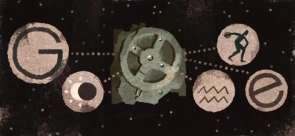
On 17 May 1902, Greek archaeologist Valerios Stais
found a corroded chunk of metal which turned out to be part of the
world's first computer and became known as the Antikythera Mechanism.
The Google Doodle of May 17 2017 commemorates the 115th anniversary of
the device's discovery showing just how a rusty remnant can open up a
skyful of knowledge and inspiration.
Read more about this here
17.05.17
Frans Maes has
recently recovered the information prepared by the late Fer de Vries
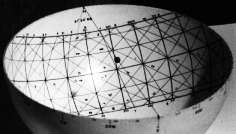 on
the construction of an Hemispherium.
on
the construction of an Hemispherium.
He has now very kindly placed it on his own website
here.
29.09.15
'Enid Blyton's Dial' - Rediscovery
and Restoration For the last 30 years of her life
Enid
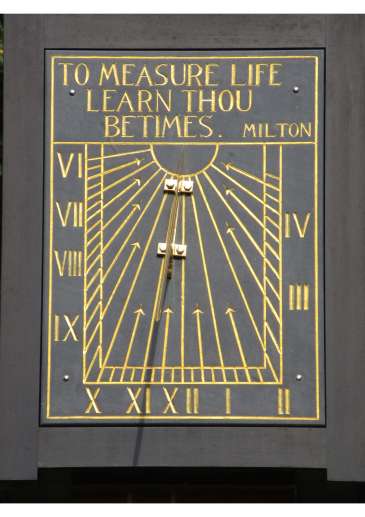 Blyton
lived at Green Hedges, 42 Penn Road in Beaconsfield. The house
had been built by one
Charles Maggs around 1912 and it was he who commissioned
a sundial which was originally positioned high up on the south gable of
the house. All trace of the dial was lost after the house came to
be demolished in 1973. Then in 2013 it was found, bought by Kari
Dorme, a committee member of The Beaconsfield Society and it has now
been restored and installed at Bekonscot Model
Village in Beaconsfield - a place much loved by Blyton.
See the restored dial and read about its
discovery and the restoration here.
Blyton
lived at Green Hedges, 42 Penn Road in Beaconsfield. The house
had been built by one
Charles Maggs around 1912 and it was he who commissioned
a sundial which was originally positioned high up on the south gable of
the house. All trace of the dial was lost after the house came to
be demolished in 1973. Then in 2013 it was found, bought by Kari
Dorme, a committee member of The Beaconsfield Society and it has now
been restored and installed at Bekonscot Model
Village in Beaconsfield - a place much loved by Blyton.
See the restored dial and read about its
discovery and the restoration here.
13.11.16
The Dial at Sherborne Castle
is listed as SRN 1929 in the UK's National Register. It was first
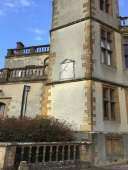 recorded
in 1992 and hasn't been recorded frequently since. Also it isn't easy to study.
Set high on the tower to the left of the entrance to this delightful
castle it is a pedimented vertical declining dial which declines slightly
East.
recorded
in 1992 and hasn't been recorded frequently since. Also it isn't easy to study.
Set high on the tower to the left of the entrance to this delightful
castle it is a pedimented vertical declining dial which declines slightly
East.
Click on the image here for a close up.
Image
taken 13.10.16 at 13:38:46 GMT
Although these images do not show it well, an observer at the tower can just discern
traces of its Roman numerals which are now only faintly visible. Oddly,
these numerals appear to be recessed rather than proud so suggesting that
the dial was originally engraved as well as painted rather than simply
painted on a flat ground. (Usually formerly painted dials protect the
background from erosion so resulting in raised lettering).
Apart from this, the dial, its mounting and its gnomon are in good
condition. A pity that it hasn't yet been restored to its earlier
elegance.
10.10.16
Oldest or second oldest surviving
portable sundial? Found in Herculaneum in the 1760s,
a
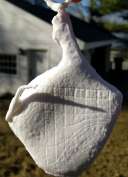 portable
sundial in the shape of an Italian ham has been copied and a 3D replica
generated in order to test its design. The dial is hung from a
string so that the sun falls on its left side, allowing the attached
'pig’s tail' gnomon to cast a shadow across the grid.
portable
sundial in the shape of an Italian ham has been copied and a 3D replica
generated in order to test its design. The dial is hung from a
string so that the sun falls on its left side, allowing the attached
'pig’s tail' gnomon to cast a shadow across the grid.
The user aligns the dial so that the tip of the tail’s shadow falls on
the vertical line for the current month whereupon the hour may be
estimated from the number of horizontal lines from the top horizontal
line to the horizontal line closest to the tip of the shadow.
Wesleyan University’s Christopher Parslow, a professor of
classical studies and Roman archaeology who made the 3-D reconstruction
claims it does represent a knowledge of how the sun works, and it can be
used to tell time.
Read more of the dial The original as found in the
Villa dei Papiri has been
dated to the 1st Century AD and can be seen
here.
14.02.17
In 1925 The Perkins Observatory
was one year old. As a gift to Ohio Wesleyan
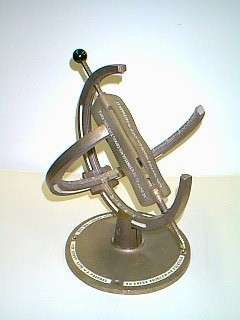 University, the
graduating class of 1925 raised money to present a sundial to the
observatory. The sundial itself was made of bronze and sat atop a
stone pedestal carved to represent the Mayan or Aztec sun god. University, the
graduating class of 1925 raised money to present a sundial to the
observatory. The sundial itself was made of bronze and sat atop a
stone pedestal carved to represent the Mayan or Aztec sun god.
Sadly, that sundial was stolen sometime around 1944. But in 1998, it
was decided that it was time to do something about it.
Read about
Perkins' Schmoyer sundial and the problem that it too had with
theft.
10.05.17 |
 Archaeologists Find Rare Ancient
Roman Sundial Cambridge University
Archaeologists Find Rare Ancient
Roman Sundial Cambridge University
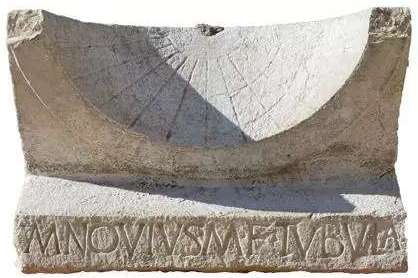 archaeologists
digging at the Roman town of
Interamna Lirenas
[between Rome and Naples] have uncovered a
near-complete Roman sundial still inscribed with its owner's name!
archaeologists
digging at the Roman town of
Interamna Lirenas
[between Rome and Naples] have uncovered a
near-complete Roman sundial still inscribed with its owner's name!
Read more about this unusual discovery
here
08.11.2017
'Rescued' perhaps - But...
Nether Winchendon House, near Thame in Oxfordshire is a
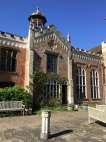 delightful
crenellated, mediaeval and Tudor property with seven acres of gardens
and 600 acres of parkland. Not surprisingly it is listed Grade 1 by
Historic England. Outside the house is an attractive pedestal
surmounted by what can only be described as a 'rescued' stone sundial
which is in a sorry state. The stone dialplate is cracked and
clumsily repaired in the ancient manner by two forged clamps. No dial
furniture is visible and the gnomon is a modern attempt to make the dial
look like a dial. The pedestal is however quite charming and worth
seeing for that alone.
delightful
crenellated, mediaeval and Tudor property with seven acres of gardens
and 600 acres of parkland. Not surprisingly it is listed Grade 1 by
Historic England. Outside the house is an attractive pedestal
surmounted by what can only be described as a 'rescued' stone sundial
which is in a sorry state. The stone dialplate is cracked and
clumsily repaired in the ancient manner by two forged clamps. No dial
furniture is visible and the gnomon is a modern attempt to make the dial
look like a dial. The pedestal is however quite charming and worth
seeing for that alone.
Click to see a series of three images
that show the sad outcome for what must
once
have been an interesting sundial. Guesses as to age?
28.08.17 - Photos
© VL Thomson 2017
Some Welcome Restoration News!
In our 2017 edition of Dial Time and courtesy of
NASS, it had been reported that the
1695 vertical
sundial on the wall of the Jesuits' Church, next to the Old University
entrance on St. Paul Street in Valleta, Malta was in a severe state of
disrepair. Alexei Pace now reports that "Restoration of the 1695
sundial in Valletta, has now been completed. All the vegetation and
fungal growth/mould has been removed and the stonework re-pointed."
24.08.17
Brian Asquith and a so far 'unrecorded'
Christopher Daniel dial!
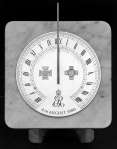 Brian
Asquith, who died in 2008 aged 78, was a sculptor, designer and
silversmith whose work remained in the forefront of contemporary design
and manufacture for some 40 years. Asquith drew his inspiration from
artists and designers who had been shown at the 1951 Festival of Britain, and
also from European Modernism. He also designed a centrepiece in silver
commissioned by the British government and presented to Mauritius on the
occasion of its independence in 1966; personal gifts given to the Prince
of Wales on his investiture in 1969, and a prestigious sundial
commissioned by the Victoria Cross and George Cross Association
and presented to the Queen Mother on her 80th birthday. This unbelievably
elegant dial shown here was delineated by Christopher Daniel and which has so
far escaped being included in the Christopher Daniel Collection though it is
recorded in the National Register as SRN2206.
Brian
Asquith, who died in 2008 aged 78, was a sculptor, designer and
silversmith whose work remained in the forefront of contemporary design
and manufacture for some 40 years. Asquith drew his inspiration from
artists and designers who had been shown at the 1951 Festival of Britain, and
also from European Modernism. He also designed a centrepiece in silver
commissioned by the British government and presented to Mauritius on the
occasion of its independence in 1966; personal gifts given to the Prince
of Wales on his investiture in 1969, and a prestigious sundial
commissioned by the Victoria Cross and George Cross Association
and presented to the Queen Mother on her 80th birthday. This unbelievably
elegant dial shown here was delineated by Christopher Daniel and which has so
far escaped being included in the Christopher Daniel Collection though it is
recorded in the National Register as SRN2206.
Click the image for a closer look and
Click
Here to read Brian Asquith's obituary.
25.04.17
|
The September 2017 edition of the BSS
Bulletin is available to Members. In this edition:
Modern Observations using the
1702 Meridian Line of the
Basilica of Santa Maria degli Angeli e dei Martiri (Rome) - Woodruff
Sullivan, Mallory Thorp, Guadalupe Tovar and Jennifer Look
How Long was I Walking? - Graham Stapleton
A Sundial Serenade - Wg Cdr James Hepburn Sindall DSO RAF, with a little
editing by Kevin Karney
An 80th Birthday Sundial - David Brown
Sundials in the Science Museum, Geneva - Doug Bateman
In the Footsteps of Thomas Ross. Part 20: The Other Dials of Lennoxlove-
Dennis Cowan
Obituary: Peter-Jochen Kunath - Ortwin Feustel
Polar Sundial in Darwin - Margaret Folkard
A Missed Opportunity? - David Brown
A Pop-up Sundial for Wroxton - David Brown, Graham Stapleton and Jackie
Jones
An Interesting Slate Sundial by Griffith Davies, FRS - Sue Manston
Portable Dial in a Calendar Box - Mike Cowham
A DIY Garden Heliochronometer - Brian Huggett
A Standing Ring Dial by J. Sisson - David Hawker
The Esperance Stonehenge in Australia - John Ward and Margaret Folkard
Sundial on Mullachgearr Memorial, Mullaghrnore, County Sligo - Michael
J. Harley
Old Sundial Books: A Survey by Mike Cowham and Fred Sawyer
14.09.17 |
Finding the sun in cloud.
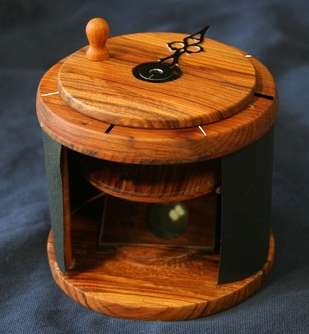
An interesting device was made in 2011 in the University
of Rennes (France) by which the Vikings' ability to locate position of
the sun on cloudy days may be replicated.
Click the image for an interesting article on this
device which (as we now know) uses light polarisation with what the Vikings called a
'sunstone' crystal.. There are other
interesting links there too on the same topic.
31.03.15 |
 Rochester's New Sundial.
That's Rochester in Michigan, USA of course and not
Rochester Kent, UK.
Rochester's New Sundial.
That's Rochester in Michigan, USA of course and not
Rochester Kent, UK.
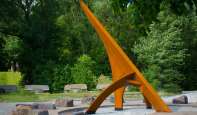 2017 saw
the celebration of Rochester’s bicentennial year, 200 years as a city.
2017 saw
the celebration of Rochester’s bicentennial year, 200 years as a city.
To commemorate the event, they unveiled a sundial monument at Municipal
Park, located behind city hall at 400 6th St. It includes
materials such as reclaimed brick from the old Main Street downtown and
stone from a Michigan quarry. The gnomon has a brown rusted look and is
constructed of the same corten steel used throughout the old knitting
mills of historic Rochester.
Twenty rocks made with reclaimed brick from old downtown Main Street
encircle the gnomon; each weighing 1,000 pounds and representing one
decade. Click on the image for a larger picture and
More
18.10.17
Did you know?
Sundials made out of coffee cups?
At one time the Eden Project in Cornwall processed waste plastic
coffee cups to make and sell horizontal and vertical sundials! Sadly
these are no longer available.
A
Sundial in the British
Passport?
Since 2010, the current UK passport has used a number of
background images on its pages. These are there to prevent
counterfeiting of course but in an imaginative move they contain images
of a wide variety of scenes. The Formal Park scene on page
20/21 is taken from the Italian Garden at Blenheim Palace and includes a
close up of the sundial there (SRN 2183 in the National Register)!
►More
Sundials out of
beer glasses?
The Daily Mail reported recently on BSS Trustee Jackie Jones and
her partner's design for a sundial made from a beer glass.
Another Beer Glass Sundial - though made in
Switzerland - is available for purchase
►here.
Make your own
sundial? You can easily
make a
sundial that is far more accurate than many available from garden
centres using materials you can probably find in the home. It has the
potential to be accurate to the minute. You can use our sundial anywhere
in Europe or the US, and you can even set it to tell summer time. |
Historic sundial back at Ipswich’s
Christchurch Park after nearly 100 years. An
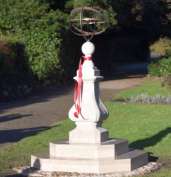 historic
sundial has been restored to its former glory – and has now been
dedicated to author and historian Dr John Blatchly. The armillary
sphere was previously in the Christchurch Park arboretum way back in
the early 1920s, but it fell into disrepair and was moved to the back
of Christchurch Mansion. historic
sundial has been restored to its former glory – and has now been
dedicated to author and historian Dr John Blatchly. The armillary
sphere was previously in the Christchurch Park arboretum way back in
the early 1920s, but it fell into disrepair and was moved to the back
of Christchurch Mansion.
After decades at the back of the mansion, a dedicated fundraising
project was launched by the Friends of Christchurch Park in June to
bring it back to life.
See the story here
08.01.17 |
|
A really historic sundial
designed for and used in Manchester's Liverpool Road
Station. This is the world's oldest surviving railway
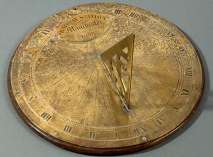 station
and the world's first railway warehouse; now restored and serving as a
museum. station
and the world's first railway warehouse; now restored and serving as a
museum.
This sundial was made in 1833, only four years after the purchase of land
for this Manchester terminus of the Liverpool & Manchester Railway (L&MR)
and still years from the eventual introduction of mean time.
Click on the image for a larger view. The dial measures 53 cms
diameter and the gnomon is some 28cms high.
25.08.15
|
This Month's Dial of Interest
This time we have a private image of the famous
'portable'
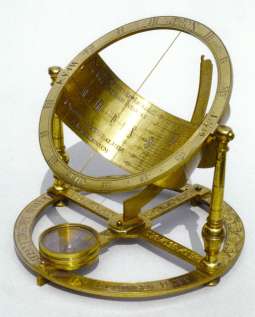 equinoctial
dial held in the National Maritime Museum and executed by Johan
Michael Uogler of Ellingen. It covers the full range of Northern
latitudes and is set with its own compass and a scratched value of the
then current magnetic declination. The hours are marked VI-XII and
I-VI and a scale for the equation of time at noon is displayed as a
figure of eight in the centre. A zodiacal scale is provided too. A
brass wire carries a small bead at its centre whose shadow at midday
yields the declination and the equation of time. A wonderful dial.
Click on the image here for a larger version or of course
go the NMM link for even more information. equinoctial
dial held in the National Maritime Museum and executed by Johan
Michael Uogler of Ellingen. It covers the full range of Northern
latitudes and is set with its own compass and a scratched value of the
then current magnetic declination. The hours are marked VI-XII and
I-VI and a scale for the equation of time at noon is displayed as a
figure of eight in the centre. A zodiacal scale is provided too. A
brass wire carries a small bead at its centre whose shadow at midday
yields the declination and the equation of time. A wonderful dial.
Click on the image here for a larger version or of course
go the NMM link for even more information.
24.11.17 (Image
courtesy CStJH Daniel) |
The Siberian Times: Reports of
a spectacular 'UFO'
 The
Siberian Times reports a giant glowing ball lighting the sky – in
Siberia. The
Siberian Times reports a giant glowing ball lighting the sky – in
Siberia.
There were fears
from locals of ‘aliens arriving’, but there is a surprising
explanation and, yes, there was indeed an unusual object in the sky.
There is more
here
29.10.17 |
|
'Know Thy Time' - Heiner
Thiessen's 'Chime Dial'. This sundial was inspired
by
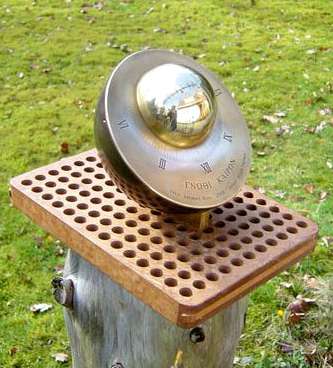 attempts
to mark solar midday by an acoustic signal, as happened with the noon
cannons of the early 1600s - though using rather more modern
technology. attempts
to mark solar midday by an acoustic signal, as happened with the noon
cannons of the early 1600s - though using rather more modern
technology.
This is effectively a solar alarm clock! Turn the small
hemisphere to the time of your choice and (if the sun shines at that
time) the dial will chime.
Read Heiner Thiessen's 2010 article on this dial and
also Tony Moss's description of how he constructed one of these dials.
The article is here
05.08.17 |
Obituary: Richard Mallett It is
with very great regret that SunInfo has to
 announce
that Richard Mallett, former BSS Trustee, Council Member and experienced
Webmaster for the Society, died on Nov 7th 2016. His funeral was
held at St Mary's Church, Eaton Bray, on Monday Dec 12, 2016. Our
sincere condolences go to his cousin, family and friends. announce
that Richard Mallett, former BSS Trustee, Council Member and experienced
Webmaster for the Society, died on Nov 7th 2016. His funeral was
held at St Mary's Church, Eaton Bray, on Monday Dec 12, 2016. Our
sincere condolences go to his cousin, family and friends.
Read our obituary for Richard here.
11.12.16, 12.12.16, 20.12.16 |
|
The December 2017 edition of the BSS
Bulletin is now available to Members.
In this edition:
A Quality Dial by Joshua Springer - John Davis
The Chord Rediscovered - Graham Stapleton
Sundial-Themed Products from Red Bubble - Frank King
Sundial Restoration at St Mary’s Church, Mentmore, Bucks - Ian Butson
Two Unusual Eighteenth-Century Sundials - Sue Manston
William Lumb of Swillington: Schoolmaster, land surveyor and dial
designer - John Davis
Newbury One-Day Meeting, 23 September 2017
In the Footsteps of Thomas Ross. Part 21: Pencaitland Parish Church (and
Bowden Kirk) - Dennis Cowan
A Trip to Southern France - Mike Cowham
A Pebble Dial by Greg McDonough - Frank King
Frank Evans— Obituary - Tony Moss (Read our
obituary to Frank here)
Two Scottish Harbour Dials - Alan Mitchell
12.12.17 |
An Unusual Birthday Sundial.
Back in 2012 Christopher Daniel took a commission to
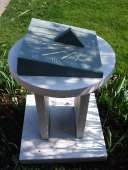 design
a sundial for the husband of a friend on the occasion of the husband's
40th Birthday. It was to a very tight timescale yet nevertheless
the outcome was not only a success but it also culminated in a very
unusual inclined horizontal dial with some additional features of
interest to all diallists.
design
a sundial for the husband of a friend on the occasion of the husband's
40th Birthday. It was to a very tight timescale yet nevertheless
the outcome was not only a success but it also culminated in a very
unusual inclined horizontal dial with some additional features of
interest to all diallists.
Read about the commission in this edited account of
Christopher's subsequent article which was first published in the BSS
Bulletin here.
11.04.17
 A West Side Story? In
1998 Christopher Daniel MBE A West Side Story? In
1998 Christopher Daniel MBE
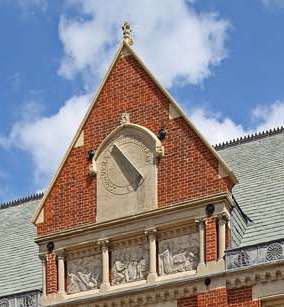 wrote
an article for the magazine of the Old Boys of Highgate School in North
London. It described the background to their most elegant vertical
West declining stone dial which is set above the main entrance.
Read the text of the article
here wrote
an article for the magazine of the Old Boys of Highgate School in North
London. It described the background to their most elegant vertical
West declining stone dial which is set above the main entrance.
Read the text of the article
here
19.11.17 |
 The March 2018 Edition of the BSS
Bulletin is published. The March 2018 Edition of the BSS
Bulletin is published.
A Gamble that Paid Off: A Horizontal Dial by Chadbum
Bros, Sheffield - John Davis
How are the Mighty Fallen - David Brown
Andrew James: Master of the Worshipful Company of Clockmakers – Frank
King
In the Footsteps of Thomas Ross Part 22: An Aberdonian Triad - Dennis
Cowan
Introducing a New Mass Dial - Frank King
New Life for an Old Calendar - John Foad
A Wine for Diallists? - Jackie Jones and Rob Stephenson
An Illustration of Serendipity: the Relocated Detroit Sundial - Frank
H. King
New Sundial Unveiled - Michael J. Harley
The Riddle of the Tower - Anthony Capon
A Second DIY Garden Heliochronometer - Brian Huggett
The 2017 American Eclipse: Postscript - Frank King
String Gnomon Dials - Mike Cowham
08.06.18 |
The Formal (Re) Dedication of the
Territorial Sundial
on the Washington State
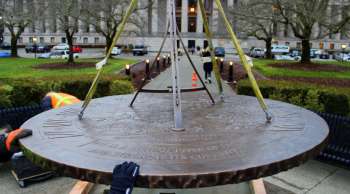 Capitol
Campus (USA) took place on January 30th 2018.
Capitol
Campus (USA) took place on January 30th 2018.
The
Territorial Sundial is located between the Legislative Building and the
Joel Pritchard Library and it has been restored and placed back at its
original location after being taken to Seattle for repairs for the past
6 months. The restoration work included making a new stronger gnomon, a
replica of the original with improved attachments. Repairs have also
been made to the face of the sundial and other improvements to the
mounting.
Read more here
22.01.18
|
Tried LightTrac yet? -
a useful
App for iPhone, iPad, iPod Touch and Android. LightTrac calculates and
plots the angle of the Sun and Moon on top of a map, for any location.
Pick any day and time and visualize the position and elevation of Sun
and Moon for any location and much more. Useful for judging sites
for dials. See it
►here
Interested in some other dial
related Apps?
For the iPhone? Try:
LunaSolCal or
Pocket Sundial
For Android devices? Try
Sol
Et Umbra (SEU). It can be
downloaded through the
Google Play Store app. |
 Retrograde Asteroid Discovered
Asteroid 2015 BZ509 had already been revealed as
Retrograde Asteroid Discovered
Asteroid 2015 BZ509 had already been revealed as
 having its
origins in another star system but it is now thought to be a permanent
member of our solar system. The 'visitor' is about 3km across and was
first spotted in late 2014 by the Pan-Starrs project at the Haleakala
Observatory in Hawaii. Experts quickly realised that the asteroid
travelled around the sun in the opposite direction to the planets – a
retrograde orbit. Additional studies now show that it has probably been
in this stable orbit for 4.5bn years and the discovery of a body from
another star system in the midst of the solar system is quite
extraordinary.
having its
origins in another star system but it is now thought to be a permanent
member of our solar system. The 'visitor' is about 3km across and was
first spotted in late 2014 by the Pan-Starrs project at the Haleakala
Observatory in Hawaii. Experts quickly realised that the asteroid
travelled around the sun in the opposite direction to the planets – a
retrograde orbit. Additional studies now show that it has probably been
in this stable orbit for 4.5bn years and the discovery of a body from
another star system in the midst of the solar system is quite
extraordinary.
More
here.
22.05.18
 Ancient stone calendar hidden for 900
years. Archaeologists suggest that a slab of
Ancient stone calendar hidden for 900
years. Archaeologists suggest that a slab of
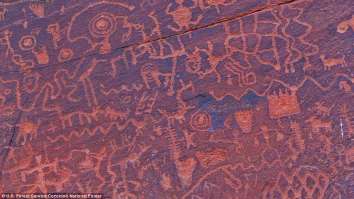 sandstone
in Arizona’s Verde Valley may have served as a calendar or as a clock
hundreds of years ago, marking the passing seasons and the onset of
important agricultural periods by the position of the sun.
sandstone
in Arizona’s Verde Valley may have served as a calendar or as a clock
hundreds of years ago, marking the passing seasons and the onset of
important agricultural periods by the position of the sun.
Roughly 1,000 petroglyphs were carved into the rock as
far back as 900 years ago by the Southern Sinagua people. As the
sun’s position in the sky changes, the light and the shadows cast by
features in the rock line up with specific images that each hold
agricultural or ceremonial significance. More can be seen about this
here
19.05.18
 The Dial of Ahaz
December 2017 marked ten years The Dial of Ahaz
December 2017 marked ten years
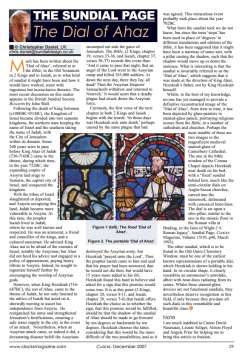 since
Christopher Daniel wrote his article covering the mystery of the Dial of
Ahaz in his then regular column of 'Clocks Magazine'. since
Christopher Daniel wrote his article covering the mystery of the Dial of
Ahaz in his then regular column of 'Clocks Magazine'.
Read the article for yourself Here
and see what some others have concluded about this ancient mystery.
20.10.17 |
 BSS Newbury 2018.
This annual one day meeting, open to all not just BSS
Members, will take place TODAY Saturday 22 September 2018 from 9am to 4pm at Sutton
Hall, Stockcross near Newbury RG20 8LN. No entry fee but a door donation
of £10 is suggested to cover expenses. Rough Programme: BSS Newbury 2018.
This annual one day meeting, open to all not just BSS
Members, will take place TODAY Saturday 22 September 2018 from 9am to 4pm at Sutton
Hall, Stockcross near Newbury RG20 8LN. No entry fee but a door donation
of £10 is suggested to cover expenses. Rough Programme:
Morning: Informal gathering and display of exhibits, Bookstall, Short 10-minute
talks from 10:00 am.
Bring a picnic lunch and chat with friends indoors or in the lovely grounds. Hot
and soft drinks provided.
Afternoon: Further short 10-minute talks/chats. Tour around all exhibits. More information from
David Pawley.
09.09.18 |
NOW ON
MARKING TIME; A JOINT EXHIBITION
BY TIM CHALK AND SASKIA
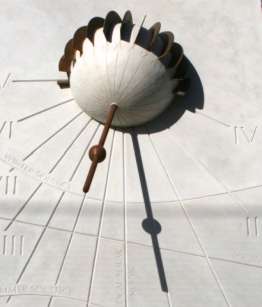 GAVIN.
“Marking Time” is an exploration of the passage of time through
artworks, some overtly measuring time, others expressing different
experiences of it through the medium of sculpture, drawing and
jewellery. GAVIN.
“Marking Time” is an exploration of the passage of time through
artworks, some overtly measuring time, others expressing different
experiences of it through the medium of sculpture, drawing and
jewellery.Mark your diary for 'Marking Time' - NOW!
In the meantime click on the image here to look at Tim Chalk's website
21ST - 29TH SEPTEMBER 2018; At the DUNDAS STREET GALLERY, 6
Dundas Street, EDINBURGH EH3 6HZ. |
|
A 'Mayan style' projection sundial
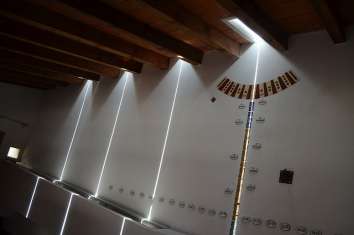
Courtesy of an article on the NASS website we learn that
Ruben Nohuitol of Queretaro, Mexico has built his own solarium which he
calls his “cosmic room” to observe the rays of the sun throughout the
year.
Have a look at
his extraordinary website
he re. There are several other pages of
intriguing displays to look at too.
27.09.17
|
Way back in 1991 The
UK's Cumbrian sundial super-sleuth Robert Sylvester first recorded the
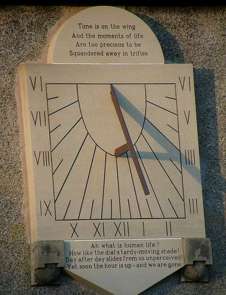 18C
sundial at the Parish Church of St Mary's Church in High Hesket, It was
designated SRN 1006 in the National register. By then the 700x800mm
sandstone dial had split, was missing its gnomon and it had been removed
from the wall and placed in store. Then, on Saturday 2nd April 2005 a
replica was rededicated by the Rev. Beth Smith after a three-year
restoration project by members of Hesket Local History Group. The
dial is notable for its two lengthy mottoes.
18C
sundial at the Parish Church of St Mary's Church in High Hesket, It was
designated SRN 1006 in the National register. By then the 700x800mm
sandstone dial had split, was missing its gnomon and it had been removed
from the wall and placed in store. Then, on Saturday 2nd April 2005 a
replica was rededicated by the Rev. Beth Smith after a three-year
restoration project by members of Hesket Local History Group. The
dial is notable for its two lengthy mottoes.
Have a look at it by clicking on the
thumbnail here.
Photos Trevor Harris, CC
BY-SA 2.0,
https://commons.wikimedia.org/w/index.php?curid=13691987
20.05.17
|
The June 2017 BSS Newsletter
reports a concern about declining society membership, about
 how the
Society might use social media to advertise itself and about the
possibility of establishing an online discussion forum. Since publication
of this Newsletter SunInfo has been contacted by several
members and former members to express their surprise since every one of
these issues was comprehensively discussed by Christopher Daniel's council
way back in 2011, a summary of ideas to remedy a reducing membership was
then given to the current council when they took office but from the
information so far received, it appears that little or none of these
has been considered let alone have any of the solutions been enacted in the
intervening years! More than that, the 2011 social media
implementation of the Society's Facebook page has never been updated for
over four years and, guess what? its designer had already
built in a discussion forum and even made provision for future advertising
facilities none of which have simply ever been tried, let alone used. Indeed former trustees
recall that the concept of using Facebook for any sort of advertising was
specifically abandoned almost from the time the present council took
office - despite the easy way costs for it could be limited. how the
Society might use social media to advertise itself and about the
possibility of establishing an online discussion forum. Since publication
of this Newsletter SunInfo has been contacted by several
members and former members to express their surprise since every one of
these issues was comprehensively discussed by Christopher Daniel's council
way back in 2011, a summary of ideas to remedy a reducing membership was
then given to the current council when they took office but from the
information so far received, it appears that little or none of these
has been considered let alone have any of the solutions been enacted in the
intervening years! More than that, the 2011 social media
implementation of the Society's Facebook page has never been updated for
over four years and, guess what? its designer had already
built in a discussion forum and even made provision for future advertising
facilities none of which have simply ever been tried, let alone used. Indeed former trustees
recall that the concept of using Facebook for any sort of advertising was
specifically abandoned almost from the time the present council took
office - despite the easy way costs for it could be limited.
Perhaps then, it's little wonder that these five (or so)
years of council inaction on such well understood and well documented issues
have finally led to today's problems? Maybe the Society would be
better placed now had other circumstances prevailed?
22.07.17 |
Nearly one year on...
It's now coming up for one year since Dudley Council reinstated a long
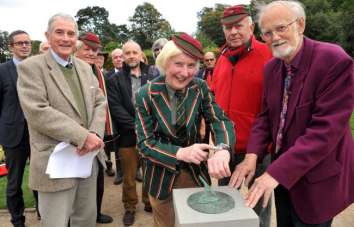 lost
sundial which went missing from Stourbridge town centre in the 1980s and
which was unveiled at its new home in Mary Stevens Park on the 10th
October 2016.
lost
sundial which went missing from Stourbridge town centre in the 1980s and
which was unveiled at its new home in Mary Stevens Park on the 10th
October 2016.
The sundial, which had been erected in a small public garden next to the
town clock and market hall by King Edward VI Grammar School in 1952 to
mark the quarter centenary of its charter, became damaged before
disappearing from the town. It is presumed that the sundial was
removed in the early 1980s when the garden was replaced by the Crown
Centre shopping development. It's a pity that Medway Council in
Kent cannot do likewise with Christopher Daniel's wonderful Nelson Dial
which has been so ignorantly removed from the town centre of Chatham.
Dudley's council are indeed enlightened, and are to be
congratulated.
Medway Council most certainly are not.
04.09.17
Christopher Daniel's 1981 Trigon!
A real discovery this!! Way back in 1981 BSS President
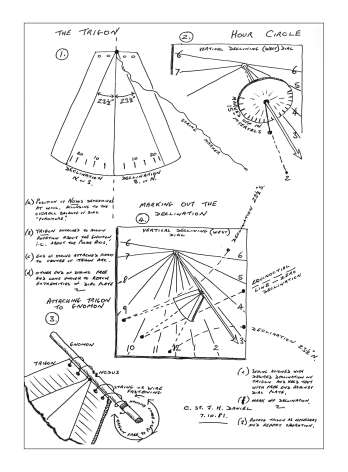 Christopher
Daniel MBE drew out for himself a very simple design for a Trigon.
Christopher
Daniel MBE drew out for himself a very simple design for a Trigon.
Such devices were used
long ago to lay out sundials on any fixed surface and they are useful
when the surfaces are not as accessible as one might wish. Modern
versions usually make use of theodolite mechanisms and a laser but such
isn't necessary. This hand drawn diagram explains the theory and
demonstrates the use of this device and all on one page too!
View the page here
- or click on the thumbnail.
01.03.17
Charity Commission confirms Donors'
Rights. In February 2017 and as a part of a public
 response, the Charity
Commission of England and Wales issued a concise summary of the duties
of charities in respect of their activities and, more importantly
their accountability to donors, beneficiaries and indeed the public.
The short summary says: response, the Charity
Commission of England and Wales issued a concise summary of the duties
of charities in respect of their activities and, more importantly
their accountability to donors, beneficiaries and indeed the public.
The short summary says:
It is important that the financial activities of
charities are properly recorded and their financial governance is
transparent. Charities are accountable to their donors,
beneficiaries and the public.
Donors to charity are entitled to have confidence that their money
is going to legitimate causes and reaches the places that it is
intended to. This is key to ensuring public trust and confidence in
charities.
SunInfo much welcomes this important
statement and all the policies that now lie behind it behind it, not
least those in respect of the operation of the BSS Library which -
after suggestions that it should even be closed - has only recently
been subjected to significant concerns as to its long term viability.
22.02.17 |
|
Here's an interesting Cumberland sundial
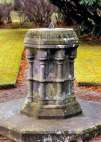 Hidden
away in the West Lakes is this gem that is very well preserved.
Not only that but it appears to be one of only two existing dials made by Chadburn of Liverpool - Optician to Prince Albert no less - and it is
mounted on a quite extraordinary pedestal. Hidden
away in the West Lakes is this gem that is very well preserved.
Not only that but it appears to be one of only two existing dials made by Chadburn of Liverpool - Optician to Prince Albert no less - and it is
mounted on a quite extraordinary pedestal.
Just take a closer look
here and judge
for yourself.
31.07.17, 12.09,17 [Images
© Robert Sylvester] |
|
Penrith's Unusual Sundial
In a garden near Penrith stands an elegant octagonal sundial
 which
at first glance looks as if it is simply an example of a pleasant well made
sundial mounted on a rather unusual tapered stone pedestal. which
at first glance looks as if it is simply an example of a pleasant well made
sundial mounted on a rather unusual tapered stone pedestal.
Closer inspection however shows that it is anything but
ordinary.
See more about this most unusual sundial here
19.08.17, 12.09.17 [Images
© Robert Sylvester] |
|
The Moorish Dial.
The origins of the sundial are lost in the mists of
antiquity; but there is no
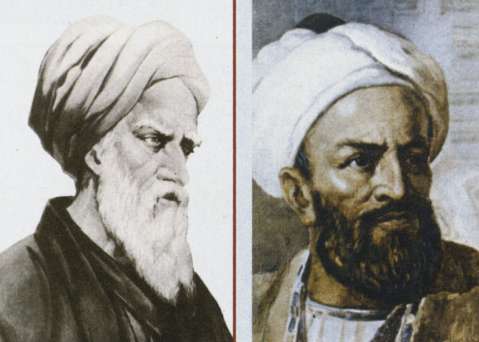 doubt
that the very earliest civilisations made use of the shadows of objects
to gauge the time of the day and the season of the year. In 2008
Christopher Daniel published a page in Clocks Magazine about the Arabic
Origins of the Scientific Sundial. doubt
that the very earliest civilisations made use of the shadows of objects
to gauge the time of the day and the season of the year. In 2008
Christopher Daniel published a page in Clocks Magazine about the Arabic
Origins of the Scientific Sundial.
There were many bright stars in the glittering Arabian
firmament of science and art; but these were perhaps the brightest of
those most able to invent the scientific sundial.
Read the article here.
13.08.17 |
Dr Frank Evans. At
the end of 2017, SunInfo was sad to report the death of Dr Frank Evans, an eminent Marine
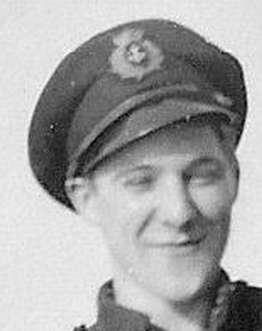 Biologist
and a British Sundial Society member of long standing. Biologist
and a British Sundial Society member of long standing.
Frank suffered a stroke aged 91 whilst on his way with
his daughter to go ice skating in North Shields.
An esteemed member of the British Sundial
community, Frank was the life and soul of any party bringing as he did
his own humour to any conversation!
Read our
obituary to Frank here
13.12.17 |
|
THE FAVERSHAM DIAL
| |
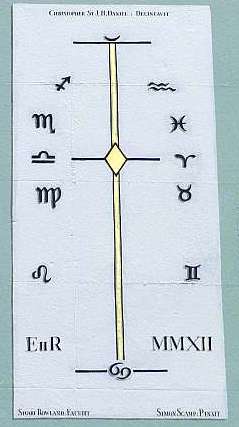 |
BSS President
Christopher Daniel's latest sundial commission,
a Noon mark on Faversham's Guildhall in the Market Place,
was formally inaugurated by the Mayor at a ceremony at 12:45 BST on
Wednesday 3rd April 2013. It was followed by a viewing of an
exhibition at the Upper Gallery of
Gallery Studios, 1 Abbey Street, Faversham of Christopher's extensive
sundial works entitled
 'Marking
Time'. After the opening Christopher remarked to the local
press that it was quite an honour for the town council to give him
permission to paint a sundial on the Guildhall as, after all, it is a
listed building. He wanted it to be something special to mark the
Queen's Diamond Jubilee. The dial was painted by Simon Scamp, a
local sign-writer and it was funded by local brewers Shepherd Neame as
well as by a number of anonymous donors. See it installed
here and
(Courtesy of This is Kent) in
'close up'
here. Some background to the construction of this dial may be
found
here.
See Christopher Daniel's own article about the dial
here. 'Marking
Time'. After the opening Christopher remarked to the local
press that it was quite an honour for the town council to give him
permission to paint a sundial on the Guildhall as, after all, it is a
listed building. He wanted it to be something special to mark the
Queen's Diamond Jubilee. The dial was painted by Simon Scamp, a
local sign-writer and it was funded by local brewers Shepherd Neame as
well as by a number of anonymous donors. See it installed
here and
(Courtesy of This is Kent) in
'close up'
here. Some background to the construction of this dial may be
found
here.
See Christopher Daniel's own article about the dial
here.
NOW See some
images of the actual dial in situ at our SunInfo Photogallery
Here
|
|
In yet another strange decision
the BSS Council announced that it was (astonishingly) consulting members over the possible abandonment of its Grants Policy.
It was indeed later abandoned. Some
say this was an action made before finding out why the policy was as it
is. More
on this
here. |
RHS Gardens at Hyde Hall are to be
congratulated! An April
visit to the
gardens at Hyde Hall near Chelmsford in Essex, by
one of SunInfo's
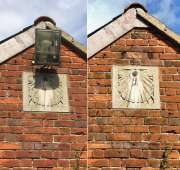 correspondents
revealed that a floodlight had been positioned above the vertical sundial
on the gable end of one of the out buildings there. See the photo on the
left.
correspondents
revealed that a floodlight had been positioned above the vertical sundial
on the gable end of one of the out buildings there. See the photo on the
left.
When this was brought to the attention of the management of RHS the
problem was very swiftly addressed; the light removed and even two nearby
mature trees that screened the dial removed also.
As can be seen in the second image, the sundial now 'shines in its own
glory' once again.
Notification of the main problem to the final fix was accomplished in only
17 days! That really is amazing.
RHS Hyde Hall management are much to be commended.
SunInfo visitors might consider dropping in when next they
are in the area - there's even more to Hyde Hall than just the sundial!
28.04.17
Remembering Andrew Somerville
Andrew was born in Paisley. He studied Organic
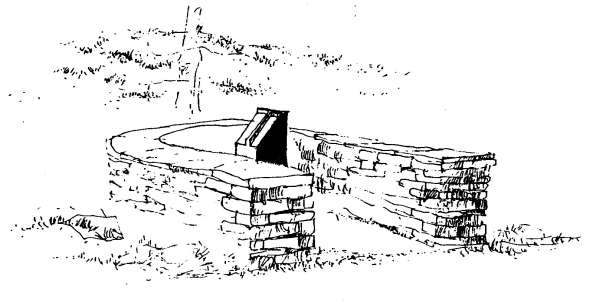 Chemistry at
Glasgow University and worked on aniline dyes and later on
cancer drug research.
Chemistry at
Glasgow University and worked on aniline dyes and later on
cancer drug research.
He retired in 1982 and resumed his interest in sundials. His book on
the elaborate Scottish sundials ‘The Ancient Sundials of Scotland’ is
still an important work. It was under his guidance that the British
Sundial Society was founded and he became its first Chairman. Sadly he
died in 1990 aged 67, only one year after BSS’s founding.
A memorial stone sundial was designed by Christopher Daniel, the
Society's current President, twenty-five years ago this year and it's
our pleasure to record that event as it was recorded in the
Bollington Arts Centre Magazine of Autumn
1992.
15.11.17
Huddersfield’s most popular rail
attraction? Brian Taylor – who died in 2009 – will
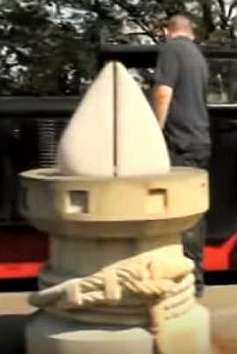 live
on at Kirklees Light Railway thanks to the unveiling of a fitting
memorial. The model steam vehicle enthusiast brought his hobby to life
in 1991 with the creation of the railway at Clayton West. The line was
first constructed to take passengers to Cuckoo’s Nest. It was later
expanded to Skelmanthorpe and then to Shelley where all journeys now
terminate. live
on at Kirklees Light Railway thanks to the unveiling of a fitting
memorial. The model steam vehicle enthusiast brought his hobby to life
in 1991 with the creation of the railway at Clayton West. The line was
first constructed to take passengers to Cuckoo’s Nest. It was later
expanded to Skelmanthorpe and then to Shelley where all journeys now
terminate.
The Golcar-born man built all the locomotives and carriages for the
three-and-a-half-mile route himself in his home workshop. To mark
Brian’s involvement, a sundial memorial has been unveiled by his widow
on the platform of Clayton West station. It has a nautical theme of a
windlass with two sails on the top, the gap between which allows the
sun to shine a line over the dial face. The sundial was created by
Shepley sculptor Dave Bradbury. Images
here and
here.
31.10.17 [Dial kindly reported by SunInfo
reader Gerald Stancey] |
 Gianni Ferrari
The Sundial Mail List
today
reported the death of Gianni Ferrari on the Gianni Ferrari
The Sundial Mail List
today
reported the death of Gianni Ferrari on the
 27th
March 2019. Gianni's definitive contributions to dialling discussions raised
over many years on the Sundial Mail List have contributed much to the
education of diallists everywhere and have delighted them in equal measure. His
book about Islamic sundials has been acclaimed by many as a masterpiece but it
will surely serve as only one aspect of his amazing dialling legacy. 27th
March 2019. Gianni's definitive contributions to dialling discussions raised
over many years on the Sundial Mail List have contributed much to the
education of diallists everywhere and have delighted them in equal measure. His
book about Islamic sundials has been acclaimed by many as a masterpiece but it
will surely serve as only one aspect of his amazing dialling legacy.
The gnomonic world has indeed lost a leader.
28.03.19 [Image©NASS
and used with permission] |
|
Andrew James
 SunInfo
is sad to have to report the untimely death in October 2019 of an
experienced, accomplished and well liked British diallist, Andrew
James FRSA HonMBHI.
Born in
Somerset, Andrew learnt from his father, before he went to school,
that skilled hands could, with simple tools, transform raw materials
into useful and beautiful objects. SunInfo
is sad to have to report the untimely death in October 2019 of an
experienced, accomplished and well liked British diallist, Andrew
James FRSA HonMBHI.
Born in
Somerset, Andrew learnt from his father, before he went to school,
that skilled hands could, with simple tools, transform raw materials
into useful and beautiful objects.
After studying both Natural Sciences and
Computer Science at Cambridge, he joined the Computing Development
Department of the Central Electricity Generating Board and was soon
given the task of creating software for a revolutionary new meter –
the precursor of today’s smart meters. He later spent 25 years as
chief scientist for a meter manufacturer.
While never his career, horology always remained his true passion
and from 2000 to 2016 he chaired the Wessex BHI Branch. Later he was
elected to be the
Master of the Worshipful Company of Clockmakers. He
was installed at a special ceremony at Panter-Stainers’ Hall,
London, followed by a Thanksgiving Service at St James Garlickhythe
Church.
Andrew combined a love of calligraphy and
carved lettering with a strong interest in sundials, and with an
interest in accurate assessments of the Equation of Time and, for
the BSS Registrar,
an
invaluable interest in resolving the several uncertainties of dial
recording not least the resolution of the long standing problem of
whether or not there was a dial in Woolfardisworthy in Devon. After
successive searches by BSS Members over several years had (almost
alternately) found the dial or reported its loss, it was Andrew who
discovered that almost unbelievably to mere mortals, there are two
villages in Devon called Woolfardisworthy one with a dial and one
without!
The Society benefitted from yet another of
Andrew’s hidden skills when he generated the then new index of
Bulletin Articles. Later he won one of the Society’s prizes for
sundial design and construction.
Andrew will certainly be remembered as one of
those few people who left this world better than he found it.
He will be sorely missed.
14.06.20
|
|
David Young
and Gordon Taylor SunInfo is
sad to report the recent deaths of two important British
diallists.
David Young
who was a founder member of the British Sundial Society and during
the early days with what might be described as an 'all hands to
the pumps' regime, it was he who took on multiple roles at
the same time being the first Secretary and the Society's first
Registrar. He and his wife Lilli took amazing care of the
fledgling society alongside Christopher Daniel at that time to the
point that he would take time to visit and effectively interview
potential members of the Committee that may have been proposed and
had agreed to serve. David was a prolific reporter of sundials for
the newly established Register, vying alternately (it then seemed)
with Tony Wood as the two BSS Members who had arguably discovered
the most dials in the UK. Always friendly towards new
members he was supportive of any new ideas by which the society
could be improved and so, perhaps unsurprisingly, he became highly
critical after a new Committee took over following Christopher's
retirement as Chairman, when he perceived a succession of mistakes
in charity management. In later life David moved more
towards his other passion, that of the history of his local area.
David will be much missed by all his friends in British dialling.
Gordon Taylor
was another early committee member of the Society who provided
much expertise and academic flair which materially helped the
acceptance of a new professional Society and moreover one which
was seeking to change the then habit of the National Trust in
using dials as ornaments that could be moved from garden to
garden. Thankfully and to the credit of the Trust, that was
quickly corrected and today both the Trust and English Heritage
are most vigilant in that regard. Gordon will be
particularly remembered by BSS Members for his design of the first
public Equiangular Dial in the UK and for his 1975 book on the
topic. Designated SRN 1773 the dial was designed for the
Royal Greenwich Observatory then located at Herstmonceaux Castle.
After a temporary move to Cambridge the dial is now back there at
the castle once again, as a fitting memorial to a memorable
diallist. See
more here
06.06.20 |
The Dial at Mackerye End
is rarely seen since it is a painted stone
declining vertical
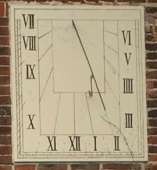
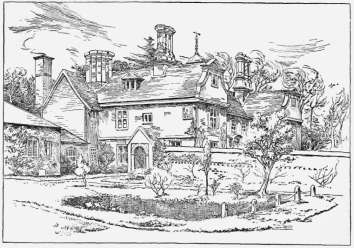
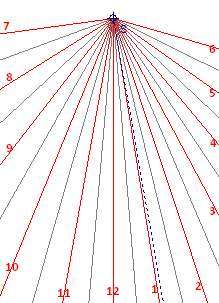 dial
dating back to the 18/19thC and mounted on an end wall of the manor house, deep
inside its own grounds. In truth it is not a particularly unusual dial though it
does indicate time intervals down to 5 minutes and is well constructed.
The images here also show a pre-WW2 drawing of the house - with dial in place
and an approximate calculation of the dialplate using the declination of S13W
established here by using Google Earth and the alignment of the roof line of
that wing of the house. It shows a close correlation though interestingly, it is
slightly different to the original - probably indicating that the actual wall on
which the dial is mounted is not quite in line with the roof and in turn, there
is a small difference in estimated declination! Such are the vicissitudes
of 18thC architecture... Click on the images for larger versions.
dial
dating back to the 18/19thC and mounted on an end wall of the manor house, deep
inside its own grounds. In truth it is not a particularly unusual dial though it
does indicate time intervals down to 5 minutes and is well constructed.
The images here also show a pre-WW2 drawing of the house - with dial in place
and an approximate calculation of the dialplate using the declination of S13W
established here by using Google Earth and the alignment of the roof line of
that wing of the house. It shows a close correlation though interestingly, it is
slightly different to the original - probably indicating that the actual wall on
which the dial is mounted is not quite in line with the roof and in turn, there
is a small difference in estimated declination! Such are the vicissitudes
of 18thC architecture... Click on the images for larger versions.
03.06.18
[photo © CPowers, 2018]
The June 2018 edition of the BSS
Bulletin is published.
A Singular Cross Dial in Moorfields - Graham Stapleton
In the Footsteps of Thomas Ross. Part 23: West Fife Sundials - Dennis
Cowan
Some Early French Dials - Mike Cowham
Newly Reported Dials 2017 - John Foad
A Sundial Commission with a Circular Enoch Calendar - Alastair Hunter
Livery Schools Link Showcase Event 2018 - Joanna Migdal
Sundial at Hotel Casino Ridola, Matera, South Eastern Italy - Martin
Jenkins
The Very Last Scratchings of an Old Bird - Tony Moss
Miniature Sundials for Some Wonderful People - Valery Dmitriev
A Sundial that Unites: Teddy Park Sundial, Jerusalem, Israel - Lupe
Feria
North American Sundial Conference, St Louis, August 2017 - Geoff Parsons
BSS Photographic Competition 2017-18 - David Hawker
BSS Annual Conference: Norwich, 20-22 April 2018
A Dial Displaced by a Bridge: Dial Square, Norwich - David Payne
13.06.18
A Very Wet Sundial at Hatfield House!
The sundial at Hatfield House in
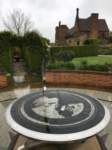 Hertfordshire
UK was installed in June 2011 in the garden near the Old Palace. It was designed
by William Andrewes of Concord, Massachusetts, USA and is shown here on a very
wet Spring day!
Hertfordshire
UK was installed in June 2011 in the garden near the Old Palace. It was designed
by William Andrewes of Concord, Massachusetts, USA and is shown here on a very
wet Spring day!
In many ways a conventional sundial but there is a twist!
The dialplate is made up of a gnomonic map with the location of the dial
at its centre.
Explanatory plaques are arranged around the supporting pedestal and a
selection of images of these and of the dial itself
can be seen,
though sadly not made very easy to read because of the
weather at the time. More
15.06.18
A
Real Victory for Science After an academic career of more
than 30 years, Peter
 Ridd
had his employment terminated as a professor of physics at James Cook University
in Townsville, Australia. Peter had spoken out against the accepted
orthodoxy that climate change was ‘killing’ the Great Barrier Reef. He was able
to crowd fund his chance to prosecute the University by raising $AUS 250,000 in
five days! Peter writes: "My lawyers have told me that the judge handed
down his decision and we seem to have won on all counts". Ridd
had his employment terminated as a professor of physics at James Cook University
in Townsville, Australia. Peter had spoken out against the accepted
orthodoxy that climate change was ‘killing’ the Great Barrier Reef. He was able
to crowd fund his chance to prosecute the University by raising $AUS 250,000 in
five days! Peter writes: "My lawyers have told me that the judge handed
down his decision and we seem to have won on all counts".
Peter’s court case has enormous implications for the international
debate about climate change, and for the ongoing crisis surrounding freedom of
speech in academia.
More here.
Full Judgement here
16.04.19, 18.04.19 |
St Martin's Cathedral, Leicester
has an interesting declining dial on its otherwise
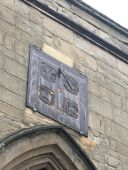 South
wall somewhat to the right of the porch. The Cathedral is not built to the
conventional E-W axis and the dial in fact declines approximately 15 degrees
East. Designated in the BSS Register as SRN 0854, it is some 600mm square.
Its Motto reads: "Coeli Enarrant Gloriam Dei". The dial displats solar time from
5am to 3pm in hours. Curiously no half hour markers or actual hour lines are
drawn. The dial's design encompasses four squares around a small centre boss
each with carvings clockwise from the upper left: angel, bird, winged ox, winged
lion. There are some traces of gold infill.
Click on the image for a larger version South
wall somewhat to the right of the porch. The Cathedral is not built to the
conventional E-W axis and the dial in fact declines approximately 15 degrees
East. Designated in the BSS Register as SRN 0854, it is some 600mm square.
Its Motto reads: "Coeli Enarrant Gloriam Dei". The dial displats solar time from
5am to 3pm in hours. Curiously no half hour markers or actual hour lines are
drawn. The dial's design encompasses four squares around a small centre boss
each with carvings clockwise from the upper left: angel, bird, winged ox, winged
lion. There are some traces of gold infill.
Click on the image for a larger version
16.03.19 Image
© VL Thomson 2019 |
Maciej Lose invites you!
You are invited to the SOL OMNIA REGIT
sundial exhibition
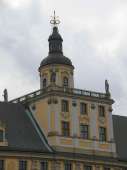 in
Wroclaw, Poland. The opening ceremony will take place on the Day of
Equinox, 20th March 2019 at 13:00 CET (13:01:29 solar time) in the Mathematical
Tower of the main building of University of Wroclaw, 1 University Square.
However the exhibition will remain open for about a year. Here there is the 1791
meridian line as well some 87 items on display in
Wroclaw, Poland. The opening ceremony will take place on the Day of
Equinox, 20th March 2019 at 13:00 CET (13:01:29 solar time) in the Mathematical
Tower of the main building of University of Wroclaw, 1 University Square.
However the exhibition will remain open for about a year. Here there is the 1791
meridian line as well some 87 items on display
including dials by: John Allen, Robert Jole, John Rowley, Thomas
Wright, William Deane (attr.), John Coggs, Samuel Saunders, Thomas Heath,
Benjamin Cole II etc.
More Here (then use Google translate to convert to your language)
11.03.19 |
The Famous Blackamoor Dial of Dunham
Massey. This important
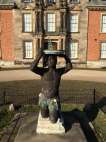 National
Trust dial dates from 1721, is 450mm in diameter and is listed by Heritage
England as "Early C18 and is thought to be either by Van Nost or by Carpentiere". National
Trust dial dates from 1721, is 450mm in diameter and is listed by Heritage
England as "Early C18 and is thought to be either by Van Nost or by Carpentiere".
Stone with a bronze
dial. 2-step stone base with nosings on which is a kneeling African
figure clad in leaves carrying the sundial above his head. Nat Grid
Ref: SJ7350787376. Thought to be one of five such original
figures only three of which are known today.
Click on the image here to see a few close-ups of
this now (sadly) very corroded dial which nonetheless can still
(just!) be used to tell the approximate solar time.
16.02.19
(© VL & M Thomson, 2019) |
New H.E. record for a pedestal at
Wardley Hall. Here's a Valentine's Day
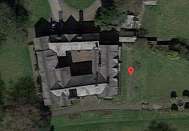 present
for those interested in dial pedestals! An Historic England list entry
discovered by SunInfo on 14-Feb-2019 describes a pedestal (sundial shaft), now
forming the base of a table. C18. Stone. Bulbous stone baluster with moulded
head and base. The dial has been replaced by a stone table top probably during
the C19. Listing: NGR: SD 75787 02185. present
for those interested in dial pedestals! An Historic England list entry
discovered by SunInfo on 14-Feb-2019 describes a pedestal (sundial shaft), now
forming the base of a table. C18. Stone. Bulbous stone baluster with moulded
head and base. The dial has been replaced by a stone table top probably during
the C19. Listing: NGR: SD 75787 02185.
Not often a pedestal gets listed without the dial! Can anyone send in
a picture of the pedestal that we can publish? Click on the picture for
Google's locational image.
(©Google Inc)
14.02.19 |
|
 Further Dial
Development Planned at Luton Hoo
The ever popular Further Dial
Development Planned at Luton Hoo
The ever popular
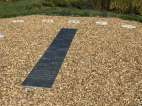 2013
analemmatic sundial at the Luton Hoo walled garden is to be partially
relaid and better marked out during the off season of 2018/19 so as to be
ready for the good weather next year. 2013
analemmatic sundial at the Luton Hoo walled garden is to be partially
relaid and better marked out during the off season of 2018/19 so as to be
ready for the good weather next year.
It will be recalled that In 2013 the octagonal Luton
Hoo Walled Garden celebrated the tercentenary of its builder -
the 3rd Earl of Bute. An eminent scientist of his day (though
a particularly unpopular Prime Minister!), it was he who, in the 18thC,
had been instrumental in the establishment of Kew Gardens. As a part of
the celebrations for this tercentenary celebration, an analemmatic dial
was commissioned and largely constructed by the Garden's own team of
volunteers.
However, what had
basically
been a straightforward dial delineation task ended up
uncovering an extraordinary fact. The garden is nearly aligned to the
sunrises and sunsets at the solstices and equinoxes of its location -
and it is not clear why!
Read about the Earl of Bute and how, with
'Capability' Lancelot Brown, he moved his original walled garden
from near the river up no less than 200 feet to the top of a hill,
arguably
to
the most inconvenient location on the estate for a huge
five acre garden and one that requires similarly huge amounts of water.
Bute combined his interests of botany, astronomy and
philosophical instruments all of which appear to be significant in the
concepts behind the walled garden. Why was it built like this? It
looks like it was the appeal of exotic soft fruits!
Read about it all here.
07.03.17, 30.11.18 |
 RA (Nick) Nicholls
SunInfo SunInfo is sad to have to report that former
Trustee and meticulous Treasurer of the British Sundial Society, Nick Nicholls
died on the 2nd October 2018. He was aged 92. Nick was a Civil Engineer by
training who brought the welcome discipline of an engineer to the management of
the young and developing Society. He was BSS Member No.47 and he joined the
other founding members as the first formally defined Treasurer. He also
contributed much in the founding years when the Society struggled to advertise
itself and somehow managed to fund and publish the first Bulletins. These were
the years before the internet when information about basic dialling was very
scarce. The early Bulletins were vital to recruit solitary diallists from their
isolation and those who wanted to learn more about sundials. A lovely man with
an equally lovely, dry sense of humour, Nick will indeed be sorely missed.
RA (Nick) Nicholls
SunInfo SunInfo is sad to have to report that former
Trustee and meticulous Treasurer of the British Sundial Society, Nick Nicholls
died on the 2nd October 2018. He was aged 92. Nick was a Civil Engineer by
training who brought the welcome discipline of an engineer to the management of
the young and developing Society. He was BSS Member No.47 and he joined the
other founding members as the first formally defined Treasurer. He also
contributed much in the founding years when the Society struggled to advertise
itself and somehow managed to fund and publish the first Bulletins. These were
the years before the internet when information about basic dialling was very
scarce. The early Bulletins were vital to recruit solitary diallists from their
isolation and those who wanted to learn more about sundials. A lovely man with
an equally lovely, dry sense of humour, Nick will indeed be sorely missed.
 A
fuller obituary is here
A
fuller obituary is here
10.10.18, 26.10.18
The September 2018 BSS Bulletin is
published:
On the Origins and Meaning of a Sundial Centre
Panel - Anthony Turner
Sundials at the Chelsea Flower Show - Douglas Bateman
A Couple of Cumbrian Dials. Part 1: The Ambleside Dial - Sue Mansion
Butterfield Dial Gnomons - Mike Cowham
In the Footsteps of Thomas Ross. Part 24: The
Carberry House Sundials -
Dennis Cowan
A Couple of Cumbrian Dials. Part 2: The Penrith Dial - Sue Mansion and
John Davis
The British Sundial Society’s Library - John Wilson
The Mystery of the Lumbutts Sundial - Robert Sylvester
Holiday Sundial: Ahakista, West Cork, Ireland - Peter Meadows
Ian Wootton (obituary) - Douglas Bateman (link
to SunInfo's obituary of Ian)
John Wright of London and Bristol: The beginning of the scientific
instrument trade in Bristol - John Davis
Sundial at the Friends’ Meeting House, Brant Broughton, North Kesteven
- John Wilson
The ‘Ingenious Beilbys’ and a Dial Made in Bristol - Kevin Fuller
18.09.18 |
The History of UK Summertime/DST
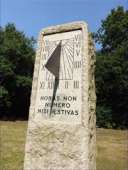 In
2016 the BBC broadcast a programme describing how Britain introduced Summertime
(daylight saving time) 100+ years ago – a move that was quickly followed by
countries worldwide. In
2016 the BBC broadcast a programme describing how Britain introduced Summertime
(daylight saving time) 100+ years ago – a move that was quickly followed by
countries worldwide.
A quarter of the world now use DST. Like it or not,
there’s a persistent British campaigner you can thank.. He came to be
supported by Winston Churchill and Sir Arthur Conan Doyle too.
Read about the builder from Chislehurst who changed the world!
And why his sundial memorial is in a clearing of Petts Wood.
01.09.18 |
|
A Sundial Missing in Zimbabwe...
Imagine, if you will, the interest to a sundial
 enthusiast
when this was spotted in the formal gardens of an hotel near the Victoria
Falls in Zimbabwe. Then imagine discovering that the company who made it
is still in existence in London yet they have no records of it. A
real mystery. enthusiast
when this was spotted in the formal gardens of an hotel near the Victoria
Falls in Zimbabwe. Then imagine discovering that the company who made it
is still in existence in London yet they have no records of it. A
real mystery.
Read a bit more about this intriguing puzzle
here. Do let the
webmaster know if you have any information about what must have been a
very well made equinoctial English sundial.
07.07.18 |
Barnwell sundial 'stands the test of
time'. On a bright, sunny day outside the
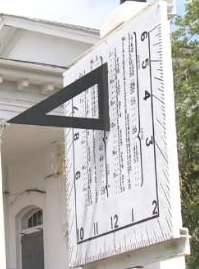 Barnwell
County Courthouse (that's in South Carolina, USA) there's no need to check your
watch to know what time it is. It is said possibly to be the only
'free-standing' vertical sundial left standing in the USA - can this really be?
Installed in 1858 after it was given to the county by State Senator Joseph D.
Allen it has recently been restored. Barnwell
County Courthouse (that's in South Carolina, USA) there's no need to check your
watch to know what time it is. It is said possibly to be the only
'free-standing' vertical sundial left standing in the USA - can this really be?
Installed in 1858 after it was given to the county by State Senator Joseph D.
Allen it has recently been restored.
It includes an EoT
correction table and is additionally unusual to British eyes in having
Arabic numerals viewed from the inside of a vertical dial.
Read
more about this recent restoration.
03.07.18 |
The Clifford A. Phaneuf Environmental
Center in Springfield's Forest Park, Mass,
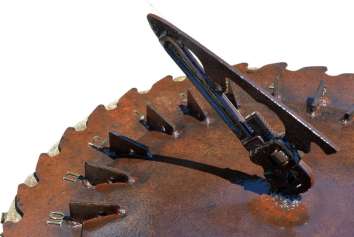 USA
dedicated a new sundial built by artist James Kitchen and commissioned by the
Edward Peck family in memory of Ruth Mahoney Peck who shared a great love for
the park. The dial is fabricated in steel using a skate blade as the
gnomon and a saw blade as a base. It was declared 'open' on June 21 2018. USA
dedicated a new sundial built by artist James Kitchen and commissioned by the
Edward Peck family in memory of Ruth Mahoney Peck who shared a great love for
the park. The dial is fabricated in steel using a skate blade as the
gnomon and a saw blade as a base. It was declared 'open' on June 21 2018.
More photos,
Short Youtube clip
04.07.18 Marking Independence Day |
Astonishing Neolithic Clay Disc from E
Jutland appears to record 2 stages of a full
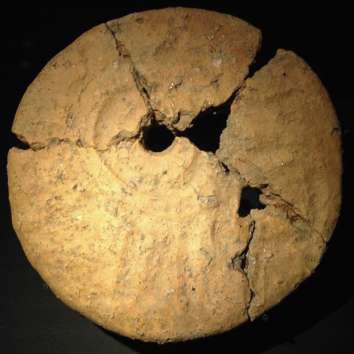
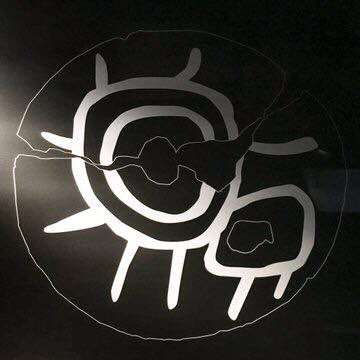 solar
eclipse on 5 May 2789 BC.
Dr Oosthuizen (Reader in Medieval Archaeology, University of Cambridge)
suggests the sun is the larger circle, its rays radiating out like a child's
drawing; the moon approaches it from bottom right, & then moves in front of the
sun - all as per the diagram.... Click on the images for slightly larger
view.
solar
eclipse on 5 May 2789 BC.
Dr Oosthuizen (Reader in Medieval Archaeology, University of Cambridge)
suggests the sun is the larger circle, its rays radiating out like a child's
drawing; the moon approaches it from bottom right, & then moves in front of the
sun - all as per the diagram.... Click on the images for slightly larger
view.
But, might this be akin
to
one of the Los Millares multi-sun artefacts known from Andalucía,
Spain, which appear to be connected with the visibility of the
constellation Orion and the time of deer rutting? What do you think?
28.05.18
The Website Devoted to the
Burlingham Walks Sundial Trail in Norfolk
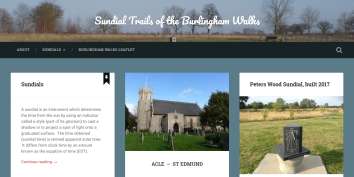 is
now operative and may be seen
here.
is
now operative and may be seen
here.
A map of how to look round the seven sundials (and some
mass dials on the church) is provided and the whole is accompanied by a
series of photographs.
Well worth a look. Click the link above or on the image
here to visit the site.
26.04.18
Happy Birthday, Sundial Atlas!
The Sundial Atlas was started 8 years ago, on April 25th
2010, and
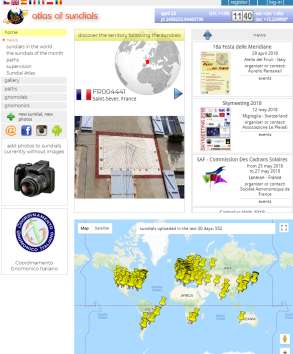 today
it has a new look with new software, renewed graphics, a new faster server and
several new features.
today
it has a new look with new software, renewed graphics, a new faster server and
several new features.
There is a guide for users (home page, click 'Sundial Atlas' on the
left, then click 'logo & guides').
Find The Sundial Atlas at
http://sundialatlas.net or click
the image
25.04.18
'Unrecorded' dial discovered on
the BSS Conference coach tour.
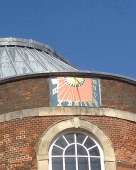
This year's BSS conference reinstated the earlier
practice of a coach tour of dials and by all accounts it proved a
success, not least because a dial was spotted by one of the delegates
which seems to be unknown as far as the UK National Register is
concerned! The dial is located high on St George's Theatre in King
Street, Great Yarmouth. It is a West declining dial painted in
bright colours. Click on the image here for a closer look.
27.04.18
The Craigdarroch Dial - found under a bush!
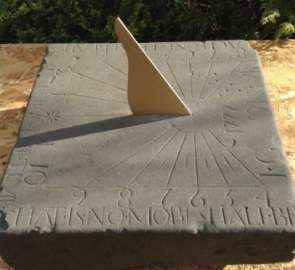 A
dial dated 1777 has been found hidden under bushes in an overgrown
garden in a small village near Inverness. Known as the Craigdarroch
stone after the place where it was found, it was recently restored by
Macmillan Hunter Sundials of Edinburgh. It carries the remarkable
motto “Each one that reads remember ye the time that is no more shall
be.”
A
dial dated 1777 has been found hidden under bushes in an overgrown
garden in a small village near Inverness. Known as the Craigdarroch
stone after the place where it was found, it was recently restored by
Macmillan Hunter Sundials of Edinburgh. It carries the remarkable
motto “Each one that reads remember ye the time that is no more shall
be.”
Read a little more about the dial
HERE
21.04.18
The Sundial, Lichfield Cathedral, Staffordshire. This
sundial, previously located near
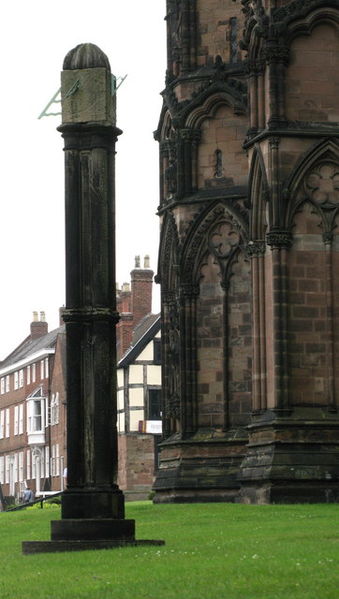 the
South door of the Cathedral was removed in 1781 and re-erected in 1785 at the
West end to regulate the clock on the tower.
the
South door of the Cathedral was removed in 1781 and re-erected in 1785 at the
West end to regulate the clock on the tower.
It was removed again in 1881 and passed into private
hands but it was returned to the cathedral in 1929 and put on a pedestal
in its present position south of the nave.
It takes the form of a cube dial with gnomons and time
scales on each face.
Photo 2009.
© David Rogers / Cathedral Sundial, Lichfield
20.04.18
A Roman Sundial dating
to the 1st century B.C. has been found in Interamna Lirenas, Italy. It was
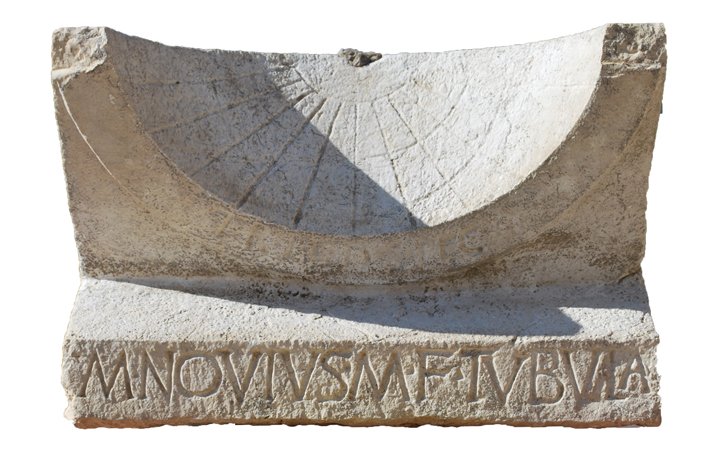 commissioned
by a man named Marcus Novius Tubula to celebrate his election to the office of
tribune of the plebs.
commissioned
by a man named Marcus Novius Tubula to celebrate his election to the office of
tribune of the plebs.
He had his name
inscribed on the base of the sundial, and paid for the whole thing “De
Sua PECUNIA,” or with his own money.
The dial is in astonishing condition and is complete with
its inscription - a rare find indeed.
More information
06.05.18
The Slate Sundials of Joseph McNally.
The slate dials of Joseph McNally are
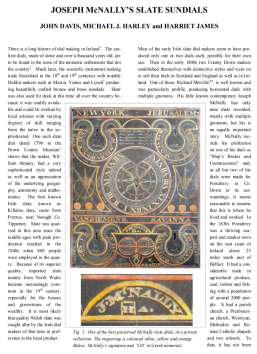 delightfully
pictorial and they add to a long tradition of slate dial making in Ireland.
delightfully
pictorial and they add to a long tradition of slate dial making in Ireland.
Read this excellent article from the BSS Bulletin by joint authors John
Davis, Michael Harley and Harriet James which is available to read on the web
courtesy of Flowton Dials.
The article may be read
HERE.
14.04.18 [
EU C-466/12]
The Queen and Sir David Attenborough saw the funny side
when they came across a
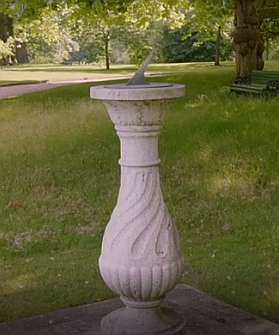 strangely
placed sundial in the grounds of Buckingham Palace.. The dial, once placed
in a suitable place now rests in the shade of nearby trees.
strangely
placed sundial in the grounds of Buckingham Palace.. The dial, once placed
in a suitable place now rests in the shade of nearby trees.
The scene is from a forthcoming BBC documentary, The
Queen's Green Planet, to be broadcast in the UK on ITV at 9pm on Monday
16 April 2018.
We read on 13th April that the dial has already been
resited!
10.04.18
Howard House sundial restored at last. One of
Norwich’s most significant historic
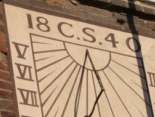 houses
has been restored at last. The Grade II* listed Howard House had stood empty for
more than 25 years and it had even been designated as at risk owing to its
deteriorating condition. But after the restoration, its roof and external
facades have now been carefully repaired and restored.
houses
has been restored at last. The Grade II* listed Howard House had stood empty for
more than 25 years and it had even been designated as at risk owing to its
deteriorating condition. But after the restoration, its roof and external
facades have now been carefully repaired and restored.
Howard House, on King Street, dates from the late 16th century and
originally was owned by Henry Howard, Duke of Norfolk. The picture shows the
West declining 1840s sundial as it is now following the restoration. Click on
the image for a larger version..
10.04.18
Images © Orbit
There is a wonderful dial in the gardens of the moated manor house 'Menkema
Manor',
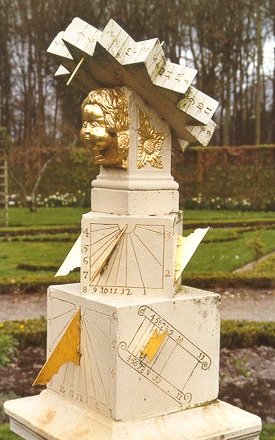 in
Uithuizen, Holland 53.4°N, 6.7°E. Information sent to
the Sundial Mail List courtesy of Frans Maes tells us that it is an elaborate
multiple dial, dating from 1722. The base is formed from two stacked
cubes, one rotated by 45° compared to the other. Each side of the cubes
has a vertical dial, though the gnomon of one has been wrongly aligned..
in
Uithuizen, Holland 53.4°N, 6.7°E. Information sent to
the Sundial Mail List courtesy of Frans Maes tells us that it is an elaborate
multiple dial, dating from 1722. The base is formed from two stacked
cubes, one rotated by 45° compared to the other. Each side of the cubes
has a vertical dial, though the gnomon of one has been wrongly aligned..
The gilded head is surmounted by a twelve-pointed star. The edge of each
point serves as the style of a small polar dial, the dial plate of which is
split over the two adjoining sides.
Then on the top of this astonishing dial, there are two
equatorial dials, on the top and on on the bottom faces of the star.
Altogether, this sculpture carries 34 dials.
More
pictures of the dial thanks to Frans Maes and
The wonderful moated manor house (image
courtesy Gouwenaar - Own work, CC0,
https://commons.wikimedia.org/w/index.php?curid=14840961)
22.03.18
The Rousham Sundial is February's dialling 'find'. A
lovely small sundial by Dolland set in
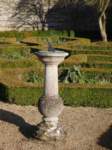 a
wonderful garden designed by William Kent in the 18thC.
a
wonderful garden designed by William Kent in the 18thC.
Rousham remains one of the few gardens of
this date to have escaped alteration, with many features still to be
seen such as the ponds and cascades in Venus’s Vale, the Cold Bath, the
seven arched Praeneste, Townsend’s Building, etc, etc
There in front of the dovecote - or more
correctly, the pigeon house - stands a lovely horizontal sundial by
Dolland which is registered with the British Sundial Society as SRN
5989. See a few images here
31.01.18
The Cannon Bridge House Sundial
- Revealed!! This is rather a hidden
gem in London.
 Part
of an immense Roof Garden that once was open to the public this is now a private
garden - about an acre in area!
Part
of an immense Roof Garden that once was open to the public this is now a private
garden - about an acre in area!
When open it was available for hire for events in London
but now it is sadly closed and only very rarely available to view.
SunInfo has however been able to obtain a few
photographs of the garden and - more importantly of the dial - and these
may be seen by clicking on the image here or on our link to our
Cannon Bridge House page. A rare
opportunity to see this particular dial - and one by a relatively
unknown modern maker too! Can you help identify the maker?
28.01.18
Why not Join our Mail List?
We don't send out many mailshots
 from
SunInfo but they can be a useful reminder for a number of
interesting Sundial matters. New EU regulations mean that unless you have
explicitly given us permission to receive mailings from us, future newsletters
will not be sent to you. By sending us an email to
Yes@ppowers.com (it doesn't even need a subject or
any content!) you will give us us your permission and we shall include your
email address on our mailing list from now on.
SunInfo Privacy Policy.
from
SunInfo but they can be a useful reminder for a number of
interesting Sundial matters. New EU regulations mean that unless you have
explicitly given us permission to receive mailings from us, future newsletters
will not be sent to you. By sending us an email to
Yes@ppowers.com (it doesn't even need a subject or
any content!) you will give us us your permission and we shall include your
email address on our mailing list from now on.
SunInfo Privacy Policy.
Make sure to email
Yes@ppowers.com
today!!
15.05.18
 CC
issues a new Trustee Welcome Pack CC
issues a new Trustee Welcome Pack
The Charity Commission has issued a
pack to welcome new trustees. They send it out to new trustees. Might be
worth making this a part of your induction pack as there could be a
delay advising the Commission of new trustees.
Read it here
09.06.18 |
Is the answer simply Scientific
Apophenia - all along? Climate
 scientists
are looking for evidence that supports the AGW hypothesis — and because they are
looking for it, Kip Hansen believes they see it in everything. The evidence, so
far, simply does not support the inference that the Earth’s climate is changing
dangerously. Perhaps only persons suffering from
Scientific Apophenia see dangerous climate change in the chaotic, random
patterns of long-term climate metrics? Click on the image for a bigger version
and
read
this for more. scientists
are looking for evidence that supports the AGW hypothesis — and because they are
looking for it, Kip Hansen believes they see it in everything. The evidence, so
far, simply does not support the inference that the Earth’s climate is changing
dangerously. Perhaps only persons suffering from
Scientific Apophenia see dangerous climate change in the chaotic, random
patterns of long-term climate metrics? Click on the image for a bigger version
and
read
this for more.
03.11.18 |
|
The
ULTIMATE Sundial Conference of 2017! 2017's
year's NASS Sundial Conference really was the one to visit.
The meeting took place in the Clayton Plaza Hotel,
7750 Carondelet Ave, Clayton, Missouri 63105 August 19-22 2017. Why was it
the
 ultimate
one to attend? Well, during the conference there was a total eclipse of
the sun! Delegates
enjoyed
3+ days of gnomonic presentations and sundial discussions. There were some
tutorial sessions for Aug 19th and the tour this year was very special
with a ring side seat to watch the August 21st Solar Eclipse.
NASS had reserved space at Jefferson Barracks that allowed an unobstructed view
of the eclipse away from the expected crowds.. ultimate
one to attend? Well, during the conference there was a total eclipse of
the sun! Delegates
enjoyed
3+ days of gnomonic presentations and sundial discussions. There were some
tutorial sessions for Aug 19th and the tour this year was very special
with a ring side seat to watch the August 21st Solar Eclipse.
NASS had reserved space at Jefferson Barracks that allowed an unobstructed view
of the eclipse away from the expected crowds..
30.05.16 , 17.11.16, 22.07.17, 20.07.17, 28.08.17 |
|
The Holes and History of the Beccles Church Dial - an anniversary!
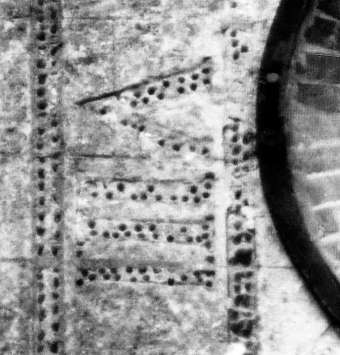 It
was ten years ago in 2005 that the mystery of the holes that are pierced
in the remains of the vertical dial on Beccles Church in Suffolk was
unravelled. The BSS Registrar at that time was Patrick Powers and in an
earlier article in the BSS Bulletin he had posed the question. Quick as a
flash, two eminent BSS diallists explained it all. A second article in the
BSS Bulletin was clearly necessary!
Read that article here to find out the answer and
to have a chuckle at Roger Bowling's succinct summing up! It
was ten years ago in 2005 that the mystery of the holes that are pierced
in the remains of the vertical dial on Beccles Church in Suffolk was
unravelled. The BSS Registrar at that time was Patrick Powers and in an
earlier article in the BSS Bulletin he had posed the question. Quick as a
flash, two eminent BSS diallists explained it all. A second article in the
BSS Bulletin was clearly necessary!
Read that article here to find out the answer and
to have a chuckle at Roger Bowling's succinct summing up!
26.08.15
|
Sundial replaces Floral Clock at Swadlincote's Eureka Park
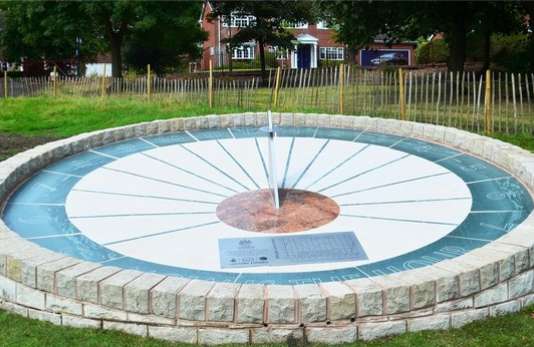 in
Derbyshire. Sited in the same place as the original 1937 floral clock, a
new sundial has been installed as a part of restoration work being carried out
on the whole park by South Derbyshire District Council and funded through a
£547,316 grant from the Heritage Lottery Fund and the Big Lottery Fund. in
Derbyshire. Sited in the same place as the original 1937 floral clock, a
new sundial has been installed as a part of restoration work being carried out
on the whole park by South Derbyshire District Council and funded through a
£547,316 grant from the Heritage Lottery Fund and the Big Lottery Fund.
More
►here
Image courtesy Burton Mail |
BSS
Bulletin - June 2020 The
June Bulletin of the British Sundial Society has
 recently
been issued to Members. The key contents are: recently
been issued to Members. The key contents are:
- Thomas and Joshua Mann: Engravers and
York Virtuosi - John Davis
- A Village Sign and a Sundial in
Lancashire - Irene Brightmer
- Restoration of the Drummond Castle
Obelisk Sundial. Part 2: Conservation and Restoration Work - James
Tate, Graciela Ainsworth and Alastair Hunter
- Newly Reported Dials, 2019 - John Foad
- A Bentley Gnomon – John Davis
- In the Footsteps of Thomas Ross. Part
31: East Coast Obelisks Dennis Cowan
- Who was EC? – John Davis
- Two Double Horizontal Sundials
Constructed at the Jesuit Academy in Polotsk, Belarus – Maciek
Lose
- A
Freshly-excavated Sundial from Antiquity Found in Turkey - John
Davis
Join the Society if you wish to receive
a copy of this publication
15.06.20 |
A Sundial Tartan - how about that?
Recently the 1890 Kinloch Anderson Sundial
 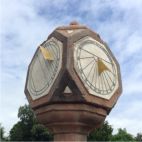 Monument
in Inverleith Park, Edinburgh was
restored by Macmillan Hunter Sundials. As a part of the 150th
Anniversary Celebrations in June this year, a unique Commemorative Tartan Cloth
- The Sundial Tartan - was produced. Stationery publishers Waverley Books were
asked by Kinloch Anderson to produce notebooks in the style of their Tartan
Cloth Commonplace Notebooks using the same Sundial Tartan. Monument
in Inverleith Park, Edinburgh was
restored by Macmillan Hunter Sundials. As a part of the 150th
Anniversary Celebrations in June this year, a unique Commemorative Tartan Cloth
- The Sundial Tartan - was produced. Stationery publishers Waverley Books were
asked by Kinloch Anderson to produce notebooks in the style of their Tartan
Cloth Commonplace Notebooks using the same Sundial Tartan.
These Sundial Notebooks are now available, as an exclusive limited
edition, to collectors and friends, from Kinloch Anderson. The background to
the creation of The Sundial Tartan is a fascinating story which is told in a
booklet enclosed with the notebook.
19.11.18 |
|
The amazing Coade Stone Dial Discovery -
AND we made it!! Recently Weston
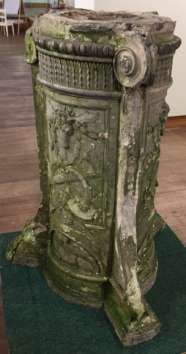 Park’s
Head Gardener made a remarkable discovery. Whilst sorting out an area used
for their equipment, amongst the detritus of old urns and shoulder high
nettles, they found this sundial base. It is no ordinary plinth, though,
being a rare Coade Stone piece which was last seen at Weston in the early
twentieth century when it appeared in a photograph of Margaret Countess of
Bradford and her children. Coade stone is not a real stone but is an
eighteenth century man-made ceramic. It was perfected by Mrs Eleanor
Coade in the 1770s and was notable for being twice fired. Examples
exist in a few places in London but only one other at Weston Park.
Only in recent years has this ceramic formulation been rediscovered and
restoration made possible. Look at the pedestal and listen to why it
is important
HERE. Park’s
Head Gardener made a remarkable discovery. Whilst sorting out an area used
for their equipment, amongst the detritus of old urns and shoulder high
nettles, they found this sundial base. It is no ordinary plinth, though,
being a rare Coade Stone piece which was last seen at Weston in the early
twentieth century when it appeared in a photograph of Margaret Countess of
Bradford and her children. Coade stone is not a real stone but is an
eighteenth century man-made ceramic. It was perfected by Mrs Eleanor
Coade in the 1770s and was notable for being twice fired. Examples
exist in a few places in London but only one other at Weston Park.
Only in recent years has this ceramic formulation been rediscovered and
restoration made possible. Look at the pedestal and listen to why it
is important
HERE.
To restore the plinth and to make a dial for it will cost £20,000 - an
amount close to 10% of the total park maintenance available to the
charity that runs Weston Park, so a crowd funding approach was started
and we at SunInfo asked if you who read SunInfo could help
too.
Appropriately and on the very day of the summer
solstice 2018 it was announced that the project has been funded!!
30.04.18, 21.06.18 |
A Fine Example of a Cross Sundial has been located
in the SE of England. It is a particularly elegant example
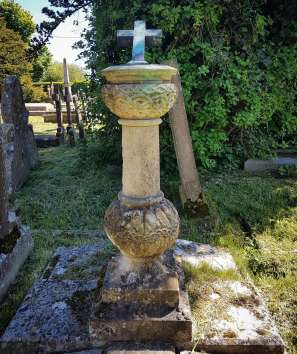
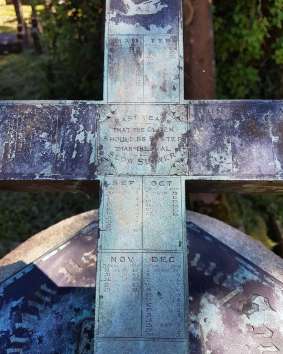 of
a rare dial type since only some 35-40 such dials are known in the
of
a rare dial type since only some 35-40 such dials are known in the
 British
Isles.
British
Isles.
This dial further excels in having its own equation of
time scale on its 'front' (South) face, a motto on its base and time
markings of 30,15 and 5 mins.
Now a little overshadowed by trees it is nevertheless
still 'operating'. Click on a thumbnail for a larger image.
© Natasha
Powers 05.06.17
Do you wish to Subscribe to receive material directly from SunInfo
or even Unsubscribe from receiving such material from SunInfo,
whether by email or ordinary mail? Click
here and enter your preferences there. You may also visit
www.bit.ly/nosuninfo at any time
for the same purpose.
Britain's beautiful secret sundials
An article by Sophie Campbell in the Daily Telegraph in January 2018
 drew
attention to the many 'secret' sundials that exist in Britain.
drew
attention to the many 'secret' sundials that exist in Britain.
She wrote:
"They are simple, yet
complex, a marriage of form and function, often beautiful, frequently
unusable (no sun) and they require for their creation a particular
combination of skills: mathematics and artistry.".
Read the article and see its other links
Here
Then read another article
Here,
this time from the Financial Times - this time all about the sundial
designer putting a modern twist on ancient technology and the dials of
David Harber.
18.06.18
Bridge End in the Snow!
The dial that is located in Francis Gibson's Garden
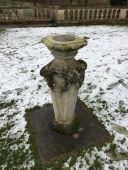 at
Bridge End, Saffron Walden is unusual in that it is rarely seen by dial
enthusiasts. This is odd since the gardens are very well worth a visit and
indeed are listed Grade II* in the UK Register of Parks and Gardens.
at
Bridge End, Saffron Walden is unusual in that it is rarely seen by dial
enthusiasts. This is odd since the gardens are very well worth a visit and
indeed are listed Grade II* in the UK Register of Parks and Gardens.
Gibson lived 1805–58 and he constructed a long view from
the Pavilion along the Pavilion path to steps and two vases, then to the
sundial, seat and balusters. The tapered pedestal is elegantly
decorated but
sadly today's dial is without its gnomon. The
dial plate is however competently laid out with an eight point compass,
sun motif and complete with the slightly depressing motto 'Night
Cometh'.
The pedestal my be viewed in more detail
here and
the dial plate itself
here.
10.02.19 (Images copyright
©
VLThomson 2019)
The Huge Dial at Grieskirchen,
Austria. This
huge sundial was erected to
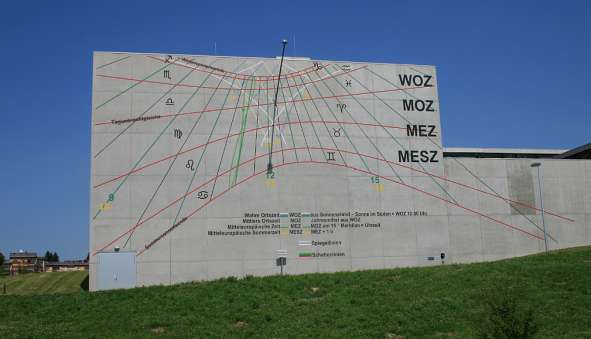 mark
the 400th anniversary of the town's elevation to municipal status. Click
on the thumbnail image here for more details. The dial now even has its own
webcam too. mark
the 400th anniversary of the town's elevation to municipal status. Click
on the thumbnail image here for more details. The dial now even has its own
webcam too.
Read more about this interesting and educational
dial, its connexion with Kepler and the live view of the new web cam
Here
15.02.19
|
The Two Tatton Twins
. Yes, we know that the word 'twins' implies
'two' but we
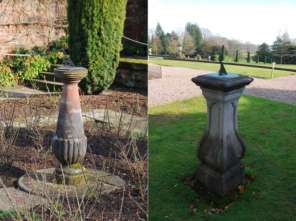 just
like a bit more alliteration! Whatever, there are no fewer than two
horizontal dials at Tatton Park in Cheshire. Not discovered for a long
time - and one of them not apparently even yet recorded in the
NT collections of such either - these sit there waiting to be
admired. One is in the Rose garden (sometimes only on view from a distance
because of the roses) and one is near the Italianate garden at the back of the
house. They are well worth a look. Click on the thumbnail images here for
larger views and for a couple of close ups of the second dial. Two
interesting dials. just
like a bit more alliteration! Whatever, there are no fewer than two
horizontal dials at Tatton Park in Cheshire. Not discovered for a long
time - and one of them not apparently even yet recorded in the
NT collections of such either - these sit there waiting to be
admired. One is in the Rose garden (sometimes only on view from a distance
because of the roses) and one is near the Italianate garden at the back of the
house. They are well worth a look. Click on the thumbnail images here for
larger views and for a couple of close ups of the second dial. Two
interesting dials.
14.02.19 (Photos
© VL Thomson 2019) |
When you are next in Dún Laoghaire,
do take a stroll out to the East Pier and there
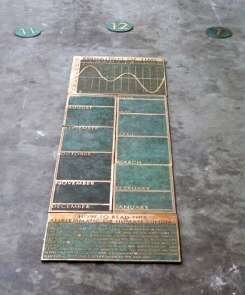 you
will find an interesting analemmatic sundial. In an article in the Irish Times
some years back there was a mention by
Peter Lynch, Professor of
Meteorology at the School of Mathematical Sciences University College Dublin.
In it he describes the dial which had been delineated by Irish dialling
enthusiast Captain Owen Deignan in 2006.
Read the Irish Times article here. Sadly the article does not
show an image of the dial so we are here much indebted to Michael J Harley who
has developed his own extensive register of Irish sundials and which is well
worth a look and well worth bookmarking too.
Go
here to see the
Dún
Laoghaire dial in more detail and
Go here to visit Michael
Harley's Register of Irish sundials. We'll be back soon with a few more
Irish dials all courtesy of Michael Harley's Register,
you
will find an interesting analemmatic sundial. In an article in the Irish Times
some years back there was a mention by
Peter Lynch, Professor of
Meteorology at the School of Mathematical Sciences University College Dublin.
In it he describes the dial which had been delineated by Irish dialling
enthusiast Captain Owen Deignan in 2006.
Read the Irish Times article here. Sadly the article does not
show an image of the dial so we are here much indebted to Michael J Harley who
has developed his own extensive register of Irish sundials and which is well
worth a look and well worth bookmarking too.
Go
here to see the
Dún
Laoghaire dial in more detail and
Go here to visit Michael
Harley's Register of Irish sundials. We'll be back soon with a few more
Irish dials all courtesy of Michael Harley's Register,
20.10.18
The Sundials of the Parks and
Gardens of Edinburgh. Here we mark the Autumnal Equinox with
an entry about some dials in Scotland! Alastair
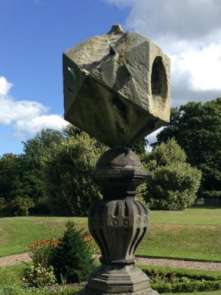 Hunter
of Macmillan Hunter Sundials, a company based in Edinburgh, recently organised a
three hour summer walk around four parks in the City: Grange Cemetery, The
Meadows, Fettes College and Inverleith Park . Hunter
of Macmillan Hunter Sundials, a company based in Edinburgh, recently organised a
three hour summer walk around four parks in the City: Grange Cemetery, The
Meadows, Fettes College and Inverleith Park .
All proceeds were in favour of the charity YACHT —'Youth
At CHurch Today'.
Read all about it at the Hunter Macmillan web site here.
21.09.18 |
The Sundials of Wisley
The Royal Horticultural Gardens at Wisley contain two sundials.

The first is located
at the entrance to the gardens - almost as you come in - and the
second is in the Herb Garden. Both are now modern dials though one
replaces an earlier horizontal dial by Barker.
The gardens make a lovely day out and the two dials
are interesting too. Click
Here or on the
image for more information and some images of the dials. Then admire
2018's dahlias!
05.09.18 |
The Sundial Society of Flanders,
"Zonnewijzerkring Vlaanderen" has published all copies of
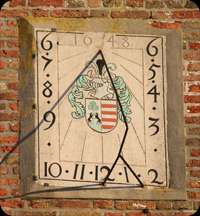 their
Bulletin from 1995 - 2017 as PDFs. They are in Dutch but can be read by those
unable to read the language by using the usual Google facilities. their
Bulletin from 1995 - 2017 as PDFs. They are in Dutch but can be read by those
unable to read the language by using the usual Google facilities.
These editions may be examined
here and the Flanders Society Web site
may be found
here
A Sundial Trail of the dials of Rupelmonde is
here
31.08.18 |
The Dial at Boughton House
In the lovely rose garden of Boughton House can be seen
 the
Henry Wynne sundial. Displaying a 32pt compass, the times of noon at twelve
cities and all set in a 'secured' dial plate of some 425mm diam which is mounted
on an octagonal plinth. The cities are marked as Mexico, Charlestown, New York,
Barbados, Tenerife, Dublin, Paris, Rome, Jerusalem, Babylon, Surrat and Bantom.
The dial shows 4am to 8pm with its numerals read from 'inside' the dial.
the
Henry Wynne sundial. Displaying a 32pt compass, the times of noon at twelve
cities and all set in a 'secured' dial plate of some 425mm diam which is mounted
on an octagonal plinth. The cities are marked as Mexico, Charlestown, New York,
Barbados, Tenerife, Dublin, Paris, Rome, Jerusalem, Babylon, Surrat and Bantom.
The dial shows 4am to 8pm with its numerals read from 'inside' the dial.
Enjoy these images of it:
Picture 1:
Picture 2;
Picture 3
12.08.18 Images©
VL Thomson, 2018
Charles Darwin's Sundial
at Down House is still to be seen at the head of the garden.
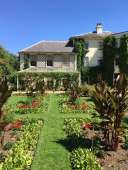
It is to be found near
the verandah although currently and sadly, it is not quite correctly set
up. It is a commendably simple but accurately delineated, dial set
on a lovely baluster pedestal - clearly positioned for use in earlier
times to set the house clocks.
It displays the hours
4am to 8pm in 30, 15, 10, 5 and 1 min divisions.
See more of this lovely dial
10.08.18
A chance to see a real Merkhet
The Merkhet (or merjet "instrument of knowing") was
 an ancient
Egyptian timekeeping instrument. It involved the use of a bar with a plumb line
and could be used during both morning and afternoon hours. A short video
clip shows one such in a museum
Here Two of these instruments could also be
used, together, to determine North. The merkhet consisted of a string with a
weight attached to one end, enabling a straight line to be measured. For the
operation to work, two merkhets were required, one aligned with Polaris, the
North Pole star. If erected properly, and if a merkhet was on hand, one
could estimate quite accurately the time by observing the transits of certain
stars as they crossed the meridian and came into alignment with the two merkhets. an ancient
Egyptian timekeeping instrument. It involved the use of a bar with a plumb line
and could be used during both morning and afternoon hours. A short video
clip shows one such in a museum
Here Two of these instruments could also be
used, together, to determine North. The merkhet consisted of a string with a
weight attached to one end, enabling a straight line to be measured. For the
operation to work, two merkhets were required, one aligned with Polaris, the
North Pole star. If erected properly, and if a merkhet was on hand, one
could estimate quite accurately the time by observing the transits of certain
stars as they crossed the meridian and came into alignment with the two merkhets.
17.07.18 |
Reinhold Kriegler
SunInfo is very sad to report that the sundial enthusiast Reinhold
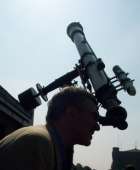 Kriegler
died on Saturday 23th March 2019 in Dessau. Over his lifetime he made many
contributions to the field of gnomonics. For those who remember his
extraordinary web site it still available to view and is at
http://www.ta-dip.de/ or more
specifically for his dialling work at
http://www.ta-dip.de/sonnenuhren.html. Kriegler
died on Saturday 23th March 2019 in Dessau. Over his lifetime he made many
contributions to the field of gnomonics. For those who remember his
extraordinary web site it still available to view and is at
http://www.ta-dip.de/ or more
specifically for his dialling work at
http://www.ta-dip.de/sonnenuhren.html.
In there he describes his on going interest in the Reinhold
crater on the moon - not of course named after him but still precious to him
nonetheless! Just one of the many comments says it all: "Kriegler exemplified
the best of what a community of dialists would be like. The most civil,
civilized, inoffensive, polite, considerate, member. Those attributes stand out,
aside from his impressive website with its wide coverage of dials and dialists
worldwide, and his own artistically-aesthetic dials". RIP.
26.03.19 |
The Delightful Dial of Dalemain in
Cumbria The well known octagonal dial
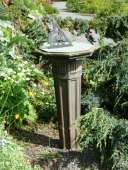 at
Dalemain Country House by Richard Whitehead is dated 1688 and shows the time
from 4am to 8pm in half, quarter and eighth hours on scales that lie inside the
chapter ring and in minutes (with Arabic Nos) on the outer edge. Some of the
actual hour lines on these inner scales are missing [eg 6 and 7pm]. There are
both inward (arrow with H form) and outward (line and dot form) half hour
markers. An elaborate inner 32 point compass with all points named [eg SEbE] and
on an adjacent (outer) scale with its reciprocal [eg NWbW] so as to give the
sun's bearing. the compass was designed to be used with vertical rod (not
present) which was passed through holes in the gnomon. and centred on the
compass. Markers on either side of the main 32 points indicate the width of this
shadow for accurate centring. Two scales further divide each of the 32 points
into 4 and 8 intervals. A half division is provided outside these scales (to the
inside of the dial) and marked by an inward line with a three dot arrowhead.
Wonderful pierced gnomon with scroll pattern, the whole mounted on an excellent
panelled octagonal stone pedestal which is slightly fluted and with no visible
base. Design Lat N 54d 40m.
More detailed pictures HERE dated May
2009. at
Dalemain Country House by Richard Whitehead is dated 1688 and shows the time
from 4am to 8pm in half, quarter and eighth hours on scales that lie inside the
chapter ring and in minutes (with Arabic Nos) on the outer edge. Some of the
actual hour lines on these inner scales are missing [eg 6 and 7pm]. There are
both inward (arrow with H form) and outward (line and dot form) half hour
markers. An elaborate inner 32 point compass with all points named [eg SEbE] and
on an adjacent (outer) scale with its reciprocal [eg NWbW] so as to give the
sun's bearing. the compass was designed to be used with vertical rod (not
present) which was passed through holes in the gnomon. and centred on the
compass. Markers on either side of the main 32 points indicate the width of this
shadow for accurate centring. Two scales further divide each of the 32 points
into 4 and 8 intervals. A half division is provided outside these scales (to the
inside of the dial) and marked by an inward line with a three dot arrowhead.
Wonderful pierced gnomon with scroll pattern, the whole mounted on an excellent
panelled octagonal stone pedestal which is slightly fluted and with no visible
base. Design Lat N 54d 40m.
More detailed pictures HERE dated May
2009.
28.02.19 |
Is
this Dial still showing the time? The
Colorado Transcript Newspaper dated 21st
 January
1909 had a small column remarking that sundials were still in common
use in Mexico. January
1909 had a small column remarking that sundials were still in common
use in Mexico.
The article showed a line drawing of one such high on a building but
sadly its location was not identified so we are at a loss to know if
the dial still exists. Can any reader throw light on the
location of this dial and say if it might still be in existence?
The newspaper entry
may be read here.
It makes interesting reading.
05.05.19 |
|
Summer Solstice at the Duomo
The other day Jim Tallman
 alerted the sundial community to the
'event' that occurs at (and near) the summer solstice in Florence's Duomo in
Italy. There is an aperture high up in the dome of the Cathedral which,
around the summer solstice lets a spot of light fall to the floor and pass over
a meridian line that was installed in 1756 - though the aperture might have been
installed as early as 1475!. It was designed partly so that "the measure
of the year and the date of Easter be more accurately determined", according to
the inscription still visible on the wall near the choir. If you cannot be
there, look at this video of an earlier
'transit'. Thanks Jim for alerting us all to this excellent spectacle. alerted the sundial community to the
'event' that occurs at (and near) the summer solstice in Florence's Duomo in
Italy. There is an aperture high up in the dome of the Cathedral which,
around the summer solstice lets a spot of light fall to the floor and pass over
a meridian line that was installed in 1756 - though the aperture might have been
installed as early as 1475!. It was designed partly so that "the measure
of the year and the date of Easter be more accurately determined", according to
the inscription still visible on the wall near the choir. If you cannot be
there, look at this video of an earlier
'transit'. Thanks Jim for alerting us all to this excellent spectacle.
06.07.18 |
The Chantilly ‘Dôme’ Sundial
is certainly rarely seen! It is at the Chantilly Gardens
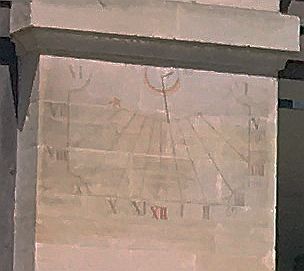 North
of Paris - inside the outdoor manège there, an extraordinarily
interesting part of the stables few otherwise get to see - unless
there to witness an equestrian demonstration of course. The key equestrian
shows and demonstrations take place beneath the 28 metre high majestic
dome of the Great Stables, with its ring and its spectators' stands
that can accommodate 600 people. Its recently restored fountain
features the dates of construction of the Great Stables (1719-1735).
The almost invisible sundial in the outside manège faces due South but
has an horizontal gnomon.
It is dated
1737.
Click on the image to see a better version with
more detail. A nice dial. North
of Paris - inside the outdoor manège there, an extraordinarily
interesting part of the stables few otherwise get to see - unless
there to witness an equestrian demonstration of course. The key equestrian
shows and demonstrations take place beneath the 28 metre high majestic
dome of the Great Stables, with its ring and its spectators' stands
that can accommodate 600 people. Its recently restored fountain
features the dates of construction of the Great Stables (1719-1735).
The almost invisible sundial in the outside manège faces due South but
has an horizontal gnomon.
It is dated
1737.
Click on the image to see a better version with
more detail. A nice dial.
13.05.19, 15.05.19
Images © VL Thomson 2019 |
The
New Coulsdon Dial Peter Ransom
has recently prepared the calculations for a
 sundial
to honour the history of the clock tower that stood pride of place
at the former Can Hill mental asylum hospital, Coulsdon. It
sits in the centre of what is now the Cane Hill Park development
and it represents the diverse history of Coulsdon whilst
acknowledging ‘noon’ not so much as 12pm, but the moment when the
sun is at its highest point in the sky above that specific place.
More
here sundial
to honour the history of the clock tower that stood pride of place
at the former Can Hill mental asylum hospital, Coulsdon. It
sits in the centre of what is now the Cane Hill Park development
and it represents the diverse history of Coulsdon whilst
acknowledging ‘noon’ not so much as 12pm, but the moment when the
sun is at its highest point in the sky above that specific place.
More
here
Richard Jackson, a committee member of
the residents’ association, called the sundial “exciting”, and
said of the designer of the dial: “Holly Graham has produced a
work of art that used historical documents left by the hospital
residents, which includes a useful sundial.
14.12.20 |
Mystery of an
Ancient Roman Gnomon Deciphered.
Digital mapping
 has
corrected a decades-old misconception about the famous
relationship between the Ara Pacis, consecrated in 9 B.C., and the
Obelisk of Montecitorio, a 6th century B.C. Egyptian relic that
was brought from Heliopolis to Rome by Augustus, the empire’s
founder. The researchers’ models revealed that the true
significance of the interaction between the monuments was not
after all, the shadow on the Ara Pacis, but the location of the
sun itself. Simulations showed that the Ara Pacis and the Obelisk
of Montecitorio were aligned so that, when viewed from the nearby
Via Flaminia, the obelisk would appear from behind the Ara Pacis
with the sun positioned at its tip. This celestial phenomenon
would have occurred not on Augustus’ birthday but on October 9,
the date of the festival of the Temple of Palatine Apollo.
Read more of this interesting discovery. has
corrected a decades-old misconception about the famous
relationship between the Ara Pacis, consecrated in 9 B.C., and the
Obelisk of Montecitorio, a 6th century B.C. Egyptian relic that
was brought from Heliopolis to Rome by Augustus, the empire’s
founder. The researchers’ models revealed that the true
significance of the interaction between the monuments was not
after all, the shadow on the Ara Pacis, but the location of the
sun itself. Simulations showed that the Ara Pacis and the Obelisk
of Montecitorio were aligned so that, when viewed from the nearby
Via Flaminia, the obelisk would appear from behind the Ara Pacis
with the sun positioned at its tip. This celestial phenomenon
would have occurred not on Augustus’ birthday but on October 9,
the date of the festival of the Temple of Palatine Apollo.
Read more of this interesting discovery.
09.11.20 |
World Sundial Webcam
Project
A project that aims to visualize the rotation of
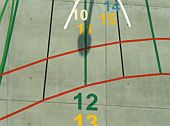 the
earth and therefore produce a real sense of the rotation at the
observer is being established. It uses a website with live web
camera streams from partner stations showing shadows of gnomons as
they cross Noon LAT. The website displays the live stream of an
automatically selected web camera. The selection is based on the
actual availability, according L.A.T., and local weather
conditions. These partner stations transfer their live stream to
the server and hence to the Internet. the
earth and therefore produce a real sense of the rotation at the
observer is being established. It uses a website with live web
camera streams from partner stations showing shadows of gnomons as
they cross Noon LAT. The website displays the live stream of an
automatically selected web camera. The selection is based on the
actual availability, according L.A.T., and local weather
conditions. These partner stations transfer their live stream to
the server and hence to the Internet.
Applications are
encouraged from anyone wishing to provide a webcam - details at
https://earthlat1200.org/
17.11.20 |
Hitchin's Physic Garden Sundial This month's dial is
the most unusual one that is in
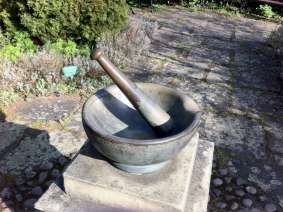 Hitchin's
so-called Physic Garden. The garden commemorates the first commercial
production of herbs in 1846 by William Ransom, a member of a prominent local
Quaker family. It opened on 20th May 1990 in the grounds of Hitchin
library and museum in Paynes Park. It is divided into four sections: Household;
the William Ransom border; External Ailments; Internal Ailments. It contains a
most unusual 1990 sundial in the form or a mortar and pestle dedicated to a late
president of the Trust. The motto reads "Disease doth oft rise above
medicine". Click the image for a larger version. The dial was designed and made by Joanna
Migdal (now Lady White). Hitchin's
so-called Physic Garden. The garden commemorates the first commercial
production of herbs in 1846 by William Ransom, a member of a prominent local
Quaker family. It opened on 20th May 1990 in the grounds of Hitchin
library and museum in Paynes Park. It is divided into four sections: Household;
the William Ransom border; External Ailments; Internal Ailments. It contains a
most unusual 1990 sundial in the form or a mortar and pestle dedicated to a late
president of the Trust. The motto reads "Disease doth oft rise above
medicine". Click the image for a larger version. The dial was designed and made by Joanna
Migdal (now Lady White).
30.03.18 |
COVENT
GARDEN’S HIDDEN SHOPPING VILLAGE
When Seven is Six! Seven Dials was
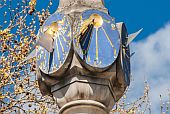 originally
laid out by Thomas Neale, MP in the early 1690s, who cleverly laid
out the area in a series of triangles to maximise the number of
houses as, at the time, rentals were charged per foot of frontage
and not per square foot of interiors. originally
laid out by Thomas Neale, MP in the early 1690s, who cleverly laid
out the area in a series of triangles to maximise the number of
houses as, at the time, rentals were charged per foot of frontage
and not per square foot of interiors.
The names of the
seven streets were chosen with the intention of attracting
affluent residents, however some of the names have subsequently
been simplified or changed because of duplication with other
streets in London. They were originally: Little and Great Earl
Street (now Earlham Street), Little and Great White Lyon Street
(now Mercer Street), Queen Street (now Shorts Gardens) and Little
& Great St. Andrew’s Street (now Monmouth Street). Some of the
original street signs can still be seen attached to buildings in
the area.
Neale commissioned England’s leading stonemason,
Edward Pierce, to design and construct the Sundial Pillar in
1693-4 as the centrepiece of his development in Seven Dials. The
Pillar was topped by six sundial faces, the seventh ‘style’ being
the column itself. [Click on the thumbnail for a larger version]
In its day it was regarded as one of London’s ‘great
public ornaments’ along with the layout and identity of the area
that revolves
around it.
24.11.20 |
The
Sundials of the Castle and Collegiate Church of St. Michael
of the city of
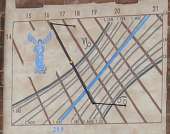 Pforzheim,
Germany are shown here. Sadly few documents exist today concerning the
origin and history of either the clocks or the dials of the castle
church. Nonetheless, it is known that until the 19th century the
mechanical tower clocks had to be readjusted daily or weekly with the
help of sundials, which were mostly nearby and in some cases even only
as noon dials. Pforzheim,
Germany are shown here. Sadly few documents exist today concerning the
origin and history of either the clocks or the dials of the castle
church. Nonetheless, it is known that until the 19th century the
mechanical tower clocks had to be readjusted daily or weekly with the
help of sundials, which were mostly nearby and in some cases even only
as noon dials.
The existence of the sundials at the castle church can today only be
deduced from the beginning of the 19th century. The recently restored
sundials shown here make use of the southwest corner of the church,
because that area is illuminated by the sun all day long. They are
relatively large and ideally located to make the time fully visible
and they have been mounted high to discourage vandalism.
Unfortunately, it is not clear from existing illustrations just how
the original dials were executed. Even investigations during the
restoration of 2014/15 gave no indication. Only the attachment points
of the original gnomons could be seen. The dials here have been
wonderfully executed by Siegfried Netzband, (delineation) and Schorn,
Marxzell (painting). Click on the
image above to see both dials set around the corner of the
church.
05.10.19
© & permission Siegfried
Netzband 2019. |
The Hugget Heliochronometers
Brian Huggett and his wife enjoy visiting gardens, in
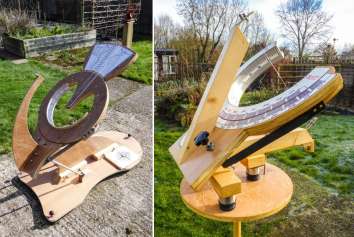 part
to gain inspiration for their own. Such outings in the summer of 2016 led him to
consider installing a sundial in their garden. Knowing little about sundials, he
inspected those they encountered and was dismayed to discover that none agreed
with his watch. Even those that claimed to reflect clock time required
additional consultation of a table or graph. ‘What we need,’ he said to his
wife, ‘is a sundial from which clock time can easily be read by anyone.’ part
to gain inspiration for their own. Such outings in the summer of 2016 led him to
consider installing a sundial in their garden. Knowing little about sundials, he
inspected those they encountered and was dismayed to discover that none agreed
with his watch. Even those that claimed to reflect clock time required
additional consultation of a table or graph. ‘What we need,’ he said to his
wife, ‘is a sundial from which clock time can easily be read by anyone.’
‘Why don’t you make one?’ she replied. See the consequences of this
suggestion here in two excellent articles.
Heliochronometer I,
Heliochronometer 2
12.08.18 |
WD& HO Wills
Cigarette Cards
Several decades ago the cigarette companies
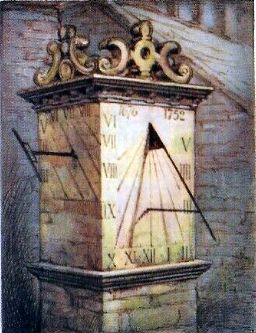 would
insert give-away cards in their packs of cigarettes to encourage
sales. These were issued on all sorts of topics in the hope that
customers would collect them and so keep buying their packs.
The practice didn't last but even in the 1950's Wills kept the
machinery maintained in case a 'cigarette card war' started again.
Here we have a link to the cards that they printed on Sundials -
with that for Wimborne Minster shown in the thumbnail. Click that
image to be able to see the obverse and reverse of these cards.
There is a short decription of each dial on the reverse of each
card. would
insert give-away cards in their packs of cigarettes to encourage
sales. These were issued on all sorts of topics in the hope that
customers would collect them and so keep buying their packs.
The practice didn't last but even in the 1950's Wills kept the
machinery maintained in case a 'cigarette card war' started again.
Here we have a link to the cards that they printed on Sundials -
with that for Wimborne Minster shown in the thumbnail. Click that
image to be able to see the obverse and reverse of these cards.
There is a short decription of each dial on the reverse of each
card.
21.10.20 Courtesy picclick.co.uk |
The
Summer Solstice and a Dihelion Sundial
The Edinburgh sundial company
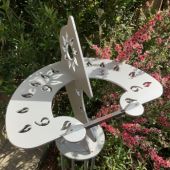 Macmillan
Hunter's latest newsletter reports that (surprisingly perhaps?)
the summer solstice 2020 in Edinburgh was a day of beautiful
sunshine. It really showed off their Dihelion dual sundial which
can read the solstice and the equinox seasons as well as the usual
daytime hours. Macmillan
Hunter's latest newsletter reports that (surprisingly perhaps?)
the summer solstice 2020 in Edinburgh was a day of beautiful
sunshine. It really showed off their Dihelion dual sundial which
can read the solstice and the equinox seasons as well as the usual
daytime hours.
The time shown here is before 8 in the
morning solar time, or nearly 9 am in British Summer Time. It is
still well before noon, when the horizontal rod is able to mark
the passage of the four seasons by its shadow. Read more of this
HERE
02.08.20
Image
© Macmillan-Hunter Sundials, with
permission |
Royal Museums
Greenwich
–
the astronomical background to the Summer
 Solstice.
The Royal Museums of Greenwich recently released a
link to an article in their Discover and Explore
series for children and adults. This one relates
to the Equinoxes and it was released just before an
earlier summer solstice
which took place on Saturday 20 June 2020 at 21:43 GMT
(22:43 BST).
Click on this link for more. Solstice.
The Royal Museums of Greenwich recently released a
link to an article in their Discover and Explore
series for children and adults. This one relates
to the Equinoxes and it was released just before an
earlier summer solstice
which took place on Saturday 20 June 2020 at 21:43 GMT
(22:43 BST).
Click on this link for more.
https://www.rmg.co.uk/discover/explore/equinoxes-and-solstices
07.07.20
|
The
Sad Dial at the Lygon Arms Hotel.
The Lygon Arms Hotel in the Cotswolds
 district
of the UK lies in the High Street,of Broadway, Worcestershire.
It is an old and established high quality hotel build from the
local Sandstone. This explains why the often missed sundial
on the right hand front facade is no longer operational. It
does however still retain its unusual gnomon which is somewhat
more ornate than those usually seen. The dial must have been
a Vertical South dial but sadly few if any markings remain.
This must surely be one case where re-engraving would be worthwile
and not a violation of 'conservation' principles. Click on the image for a
fuller picture - Can you see the dial? See a closer image
here
and an even closer image
here district
of the UK lies in the High Street,of Broadway, Worcestershire.
It is an old and established high quality hotel build from the
local Sandstone. This explains why the often missed sundial
on the right hand front facade is no longer operational. It
does however still retain its unusual gnomon which is somewhat
more ornate than those usually seen. The dial must have been
a Vertical South dial but sadly few if any markings remain.
This must surely be one case where re-engraving would be worthwile
and not a violation of 'conservation' principles. Click on the image for a
fuller picture - Can you see the dial? See a closer image
here
and an even closer image
here
22.04.20
|
The Vaux-Le-Vicomte Surprise...! A visit to the
Chateau de Vaux-Le-Vicomte in
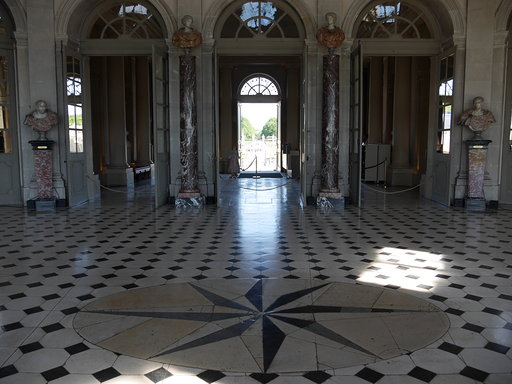 Maincy,
near Melun, 55 km SE of Paris in the Seine-et-Marne département of
France is always a delight. However when visiting the Grand Salon
there you are in for a surprise because the tiled floor of the Salon
is set out as a dial without an obvious aperture gnomon. Sadly nothing
available to read about the salon mentions this nor does the plan
being carried out for restoration. Can diallists in the area
please let SunInfo know the history of the dial or meridian
line and whether it will be restored to its former glory? Click
on the image for more detail and see more of the floor markings of the
Salon Here,
Here and
Here Maincy,
near Melun, 55 km SE of Paris in the Seine-et-Marne département of
France is always a delight. However when visiting the Grand Salon
there you are in for a surprise because the tiled floor of the Salon
is set out as a dial without an obvious aperture gnomon. Sadly nothing
available to read about the salon mentions this nor does the plan
being carried out for restoration. Can diallists in the area
please let SunInfo know the history of the dial or meridian
line and whether it will be restored to its former glory? Click
on the image for more detail and see more of the floor markings of the
Salon Here,
Here and
Here
17.05.19
Images © VL Thomson 2019 |
Fer De Vries' article of the month April 2003
This month's entry involves the
 identification
of the bands of an armillary sphere - using their latin
identification from long ago. identification
of the bands of an armillary sphere - using their latin
identification from long ago.
This clear description proves
an interesting way to discover the detail that is represented on
any properly constructed Armillary Sundial.
Click
here
or on the thumbnail to see a PDF of the details.
07.03.21 © De Zonnewijzerkring, 2021 |
Fer
De Vries' article of the month March 2003 Fer wrote: It
just came to us
 from
out of the blue. from
out of the blue.
"A drawing of a sundial with
calculations (1730), made for William IV, probably for the
construction the sundial in the Prinsenhof garden in Groningen".
That, to the Dutch Sundial Society,
not surprisingly was interesting! Click the image or
Here
for the article
16.02.21 ©
De Zonnewijzerkring, 2021 |
Fer
De Vries' article of the month Feb 2003
How much time is sundial time?
 Whenever
we design a sundial for an arbitrary plane, we will also have to
determine which hour lines to add. Whenever
we design a sundial for an arbitrary plane, we will also have to
determine which hour lines to add.
This choice depends on two factors:
- The sun should be above the horizon
where the sundial is located, i.e. it should be day
- The sun should be on the correct side
of the dial plane
See how to solve for these issues.
Here
or by clicking the image.
08.02.21 © De Zonnewijzerkring, 2021 |
A
Sundial Guide for the Extremadura Region of Spain.
The first edition of the
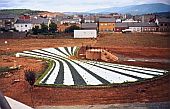 Guide
of Sundials for the Extremadura region (interior SW) of Spain was
published this last summer. An electronic version of this
guide (in pdf format) can now be downloaded free of charge.
Although this PDF is the full document in Spanish complete with
images, the online page for individual dials can be read in most
languages by simply right clicking and turning on Google
Translate. Guide
of Sundials for the Extremadura region (interior SW) of Spain was
published this last summer. An electronic version of this
guide (in pdf format) can now be downloaded free of charge.
Although this PDF is the full document in Spanish complete with
images, the online page for individual dials can be read in most
languages by simply right clicking and turning on Google
Translate.
Go
HERE to explore this excellent Register of
Dials or click on the image here.
17.01.21 |
Fer
De Vries' article of the month Jan 2003
Here is Dutch diallist Fer De Vries'
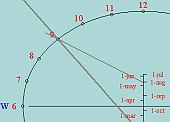 first
available article for the Dutch Sundial Society. It
introduces the reader to the analemmatic sundial and as usual with
Fer's contributions it add a little twist to our normal use for
this type of dial. first
available article for the Dutch Sundial Society. It
introduces the reader to the analemmatic sundial and as usual with
Fer's contributions it add a little twist to our normal use for
this type of dial.
The article may be viewed in full by
clicking on the thumbnail image or
here.
10.01.21 © De Zonnewijzerkring, 2021 |
The
Napier Dial At the southernmost
tip of Africa, about two hours drive from
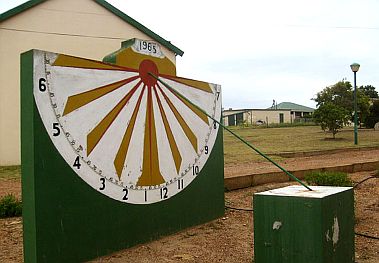 CapeTown,
lies the town of Napier, a natural and historical delight for
visitors to South Africa. This little town lies at the foot of the
Soetmuisberg Mountain Range and is home to many tourist
attractions, not least the Napier Sundial. CapeTown,
lies the town of Napier, a natural and historical delight for
visitors to South Africa. This little town lies at the foot of the
Soetmuisberg Mountain Range and is home to many tourist
attractions, not least the Napier Sundial.
Locally accepted as the largest sundial,
as well as the only vertical one, in South Africa.
The Napier Sundial was erected by Danie
du Toit in 1965, after years of observing the movements of the
sun. It was when he read an article written by CJ Langenhoven on
sundials which had been reprinted in 1936, that his interest was
piqued. This sparked in Du Toit a special desire to create his own
sundial. Click on the thumbnail
image for a larger version.
He duly approached the local
municipality, which provided the materials and allowed him to
erect the sundial outside the Municipal offices. It took him 18
months just to complete the markings for each minute - all based
solely on his observations of the shadow on the dial. A most
unusual example of a dial being constructed by observation.
Using an
accompanying table, which explains the corrections between the
sundial’s time and standard time, it seems the time of day can
still be determined to within an accuracy of 30 seconds.
22.12.20 |
The
Meadows Dial
This
amillary sundial was erected in Edinburgh in
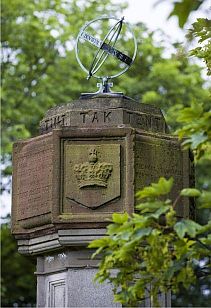 commemoration
of the opening of the International Exhibition by Prince Albert
Victor of Wales on 8th May 1886. commemoration
of the opening of the International Exhibition by Prince Albert
Victor of Wales on 8th May 1886.
Shields on the sundial
are carved with a crown, the arms of Edinburgh, a lion rampant and
a castle. One inscription on the sundial reads, " Tak tent o' time
ere time be tint" or 'Take account of time before your time is
finished.'
Quarry names are also on the blocks making up
the shaft of the sundial. and on each of the lower facings several
sayings. source: www.rcahms.gov.uk)
29.11.20 |
 Tony Wood
It is with great regret that SunInfo Tony Wood
It is with great regret that SunInfo
 noted
the death of Tony Wood, in the early hours of 20th April 2022. His
contribution to the recording of Mass Dials in particular was enormous. noted
the death of Tony Wood, in the early hours of 20th April 2022. His
contribution to the recording of Mass Dials in particular was enormous.
His funeral took place on 30th May 2021. SunInfo's
own obituary may be
found Here.
12.05.2022
©SunInfo |
The Good News and Bad News about a
Dial. The discovery of a
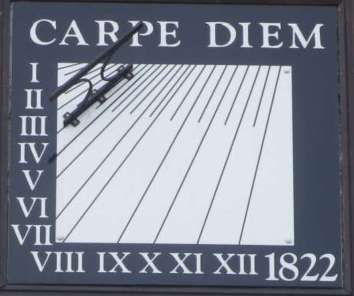 rarely seen great declining
dial is rightly good news, as is the fact that clearly the dial in question has
recently been carefully repainted. So, what then might be the bad news in the
heading to this entry? rarely seen great declining
dial is rightly good news, as is the fact that clearly the dial in question has
recently been carefully repainted. So, what then might be the bad news in the
heading to this entry?
This dial has only fairly recently been recorded. It is in Amptill in
Bedfordshire, UK and the facts about it were the subject of an article in
SunInfo's Dial Time 2018. Read about its problems
here
13.09.18 |
 The Dial at
Kiftsgate Court
Another lost original dial has been replaced at The Dial at
Kiftsgate Court
Another lost original dial has been replaced at
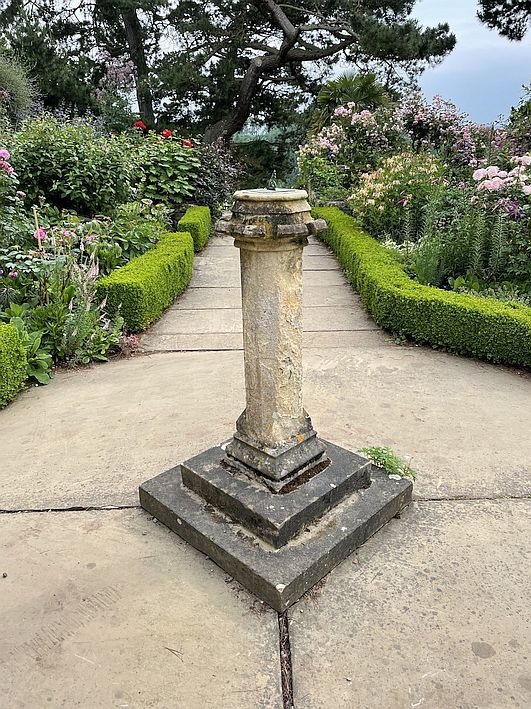 Kiftsgate
Court in the garden there. Heather Muir created the wonderful
garden, which until 1920 had consisted of a paved formal garden in
front of the portico. Kiftsgate
Court in the garden there. Heather Muir created the wonderful
garden, which until 1920 had consisted of a paved formal garden in
front of the portico.
Heather was helped and inspired by her
lifelong friend Lawrence Johnston of Hidcote Manor which is
close-by but it was Heather who decided that the garden should
develop organically, rather than by planning everything first.
This has given the garden a distinctly feminine feel, almost in
direct contrast to the more masculine lines being employed by
Johnston at Hidcote. A more recent development has been the
addition of the new water garden that was once the tennis court.
The original dial has long gone and the inset in the top has been
strangely filled but the replacement dial has character. Click the
image or HERE
to see more detail.
06.07.21 |
 The Dire Dial of
Hidcote Bartrim
The gardens of Hidcote Bartrim in The Dire Dial of
Hidcote Bartrim
The gardens of Hidcote Bartrim in
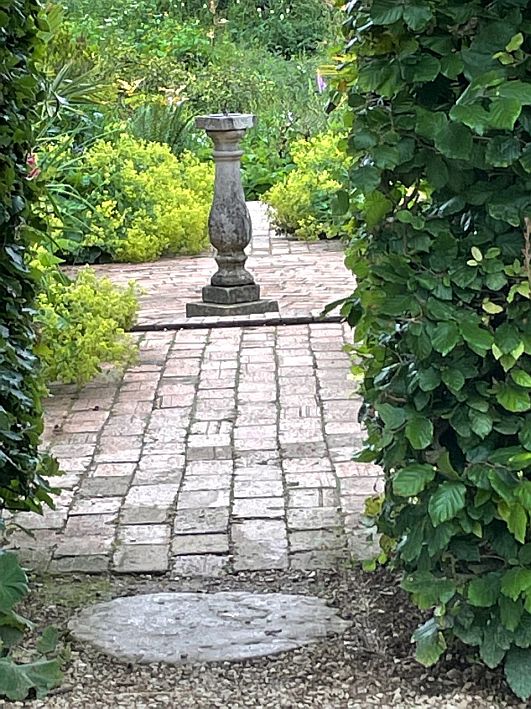 Gloucestershire
are deservedly well known and admired by all. In 'Mrs Winthrop's Garden' there is
a sundial (SRN 5903) which has, like so many others,
suffered from theft over the years. Today's version though is
frankly a bit of a mess. Set on a lovely 1789 pedestal is a poor
modern dial of the wrong size and with a rather twee motto. On top
of that the dial is not properly aligned. How much better with a
better dial but how much greater the risk of another theft? Gloucestershire
are deservedly well known and admired by all. In 'Mrs Winthrop's Garden' there is
a sundial (SRN 5903) which has, like so many others,
suffered from theft over the years. Today's version though is
frankly a bit of a mess. Set on a lovely 1789 pedestal is a poor
modern dial of the wrong size and with a rather twee motto. On top
of that the dial is not properly aligned. How much better with a
better dial but how much greater the risk of another theft?
Check out the
dial HERE and
judge for yourself.
03.07.21 |
Erin Beeston on his
'Relics of a Railway
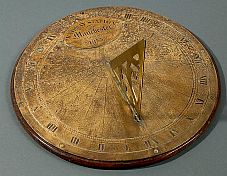 The
Liverpool Road Station in Manchester has owned a quite spectacular
vertical sundial for over 180 years which has been an object of
fascination for over a century. In 1929 the sundial was removed
from a plinth outside and placed in the offices of Grundy, the
goods agent at the station until 1931. The sundial also featured
in the Liverpool Echo in 1937, when it was photographed outside
with a member of staff. We next see it in a 1939 Pathé film. Read
Erin Beeston's interesting article
HERE Click the image for a larger version The
Liverpool Road Station in Manchester has owned a quite spectacular
vertical sundial for over 180 years which has been an object of
fascination for over a century. In 1929 the sundial was removed
from a plinth outside and placed in the offices of Grundy, the
goods agent at the station until 1931. The sundial also featured
in the Liverpool Echo in 1937, when it was photographed outside
with a member of staff. We next see it in a 1939 Pathé film. Read
Erin Beeston's interesting article
HERE Click the image for a larger version
22.06.21 Courtesy Science &
Industry Museum |
The History Section of the Société
Jersiaise The History Section of the Jersey Society
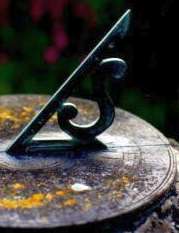 in
the Channel Islands, runs programmes of historical interest to the Islanders.
Sometimes these are published on their web site. Two in particular from
the early years of the millennium are of interest to a wider sundial public and
we give their links to these here. in
the Channel Islands, runs programmes of historical interest to the Islanders.
Sometimes these are published on their web site. Two in particular from
the early years of the millennium are of interest to a wider sundial public and
we give their links to these here.
1.
Catching the Shadow An Illustrated Talk on The Sundials of
Jersey by David Levitt on 29 November 2001
2. A brief description of
The Sundial at The Parish Church of St Peter In the Island of Jersey
which was designed by Harriet James in 2004.
23.09.18 |
|
The
Kiftsgate Sundial Kiftsgate Court Gardens is
situated above the village of
 Mickleton
in the county of Gloucestershire, England, in the far north of the
county close to the county border with both Worcestershire and
Warwickshire. The gardens, famed for their roses, are the creation of
three generations of women gardeners. This wonderful pedestal
supports a perhaps less wonderful dial but is nevertheless worthy of
note. Mickleton
in the county of Gloucestershire, England, in the far north of the
county close to the county border with both Worcestershire and
Warwickshire. The gardens, famed for their roses, are the creation of
three generations of women gardeners. This wonderful pedestal
supports a perhaps less wonderful dial but is nevertheless worthy of
note.
There are more images of the dial's details
Here,
Here and
Here
05.08.19. Images
©
coursesy VL Thomson, 2019 |
Revisiting an old
friend..
In a recent visit back to Northumberland it was
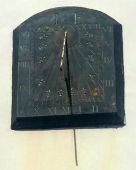 pleasing
to see again the old vertcal dial on the side of Willcox's
Jewellers in Alnwick's main street. pleasing
to see again the old vertcal dial on the side of Willcox's
Jewellers in Alnwick's main street.
Constructed in
1737 and bearing the initials I.F. it is a Direct South dial in
slate, still in remarkably good condition and showing in Roman
numerals the expected 6am to 6pm in quarter hours with half hours
marked by fleurs de lys.
Click on the thumbnail for a
larger image which was taken at 13:33 BST on 20th August 2020.
01.09.20 |
The
Dial in Italy's Sigurtà Garden Park.
Magda and Joseph Sigurtà have tirelessly
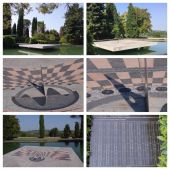 maintained
the garden that was first restored by the pharmaceutical
industrialist, Dr. Giuseppe Carlo Sigurtà from the 1940s. maintained
the garden that was first restored by the pharmaceutical
industrialist, Dr. Giuseppe Carlo Sigurtà from the 1940s.
In 1990 a sundial was constructed there and
surrounded by water. Click on the image or
HERE to see
larger images of this interesting sundial, seen here at close to the
2019 autumnal equinox.
13.10.19 |
April's
News from Border Sundials The recent addition to 'News from
Border
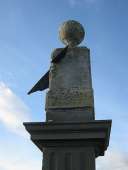 Sundials' can be read
here.
This edition mentions the Sundial on Wilton Bridge, Ross-on-Wye,
Herefordshire. Read about its history, why it was moved and read its
depressing motto: "Esteem thy precious time; Which pass so swiftly
away; Prepare thee for eternity; And do not make delay". The
sundial was commissioned by Jonathon Barrow - originally from Monmouth
but who lived in Bridstow just outside Ross-on-Wye. Sundials' can be read
here.
This edition mentions the Sundial on Wilton Bridge, Ross-on-Wye,
Herefordshire. Read about its history, why it was moved and read its
depressing motto: "Esteem thy precious time; Which pass so swiftly
away; Prepare thee for eternity; And do not make delay". The
sundial was commissioned by Jonathon Barrow - originally from Monmouth
but who lived in Bridstow just outside Ross-on-Wye.
11.04.19
Image
©
Pauline Eccles & licensed for reuse under the Creative Commons
Attribution-ShareAlike 2.0 license. |
An
interesting new, painted Italian dial of classic
design.
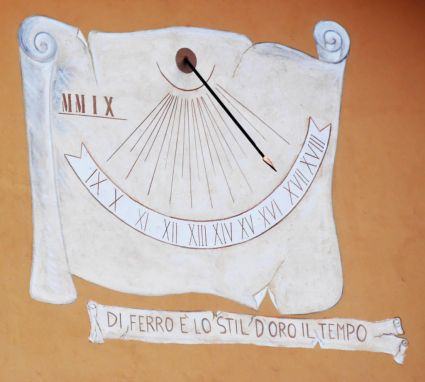 Here
is a painted dial on a house on the Eastern side of Lake Garda in
Italy. On one of the houses overlooking the Lake and accessible
only along the very narrow roads of that area. Here
is a painted dial on a house on the Eastern side of Lake Garda in
Italy. On one of the houses overlooking the Lake and accessible
only along the very narrow roads of that area.
Constructed (or perhaps repainted) in 2009 it bears the motto
"Di ferro e' lo stil, d'oro il tempo". (Iron is the style, gold the
time). It displays local solar time from 9am to 8pm.
29.09.19
Images courtesy VL Thomson © VLT 2019 |
The Dennis Cowan
Sundial Trails
Over the years Sundiallist Dennis Cowan
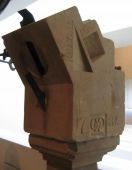 has
put together a number of quite fascinating sundial trails of
Scottish dials. Readers will know that Scottish dials
frequently have a style all of their own but despite their
relative rarity there are many such that are well worth looking
at. Despite this they are not shown as much as you might imagine.
So, over the next weeks and with Dennis's gracious permission,
SunInfo intends to feature a few of these
trails. has
put together a number of quite fascinating sundial trails of
Scottish dials. Readers will know that Scottish dials
frequently have a style all of their own but despite their
relative rarity there are many such that are well worth looking
at. Despite this they are not shown as much as you might imagine.
So, over the next weeks and with Dennis's gracious permission,
SunInfo intends to feature a few of these
trails.
Our first trail encompasses the dials of the
Royal Mile in Edinburgh including those to be seen there in the
National Museum of Scotland. The image here shows a lectern
sundial, dated 1781, from Cantray in Aberdeenshire, with the
monogram DD (David Duncan) and with dials for 13 locations around
the world. These are Cantray, Peking, Goa, Rome, Jerusalem, Cairo,
Naples, Syracuse, Ozaca, Troy, Smyrna, Bengal and Paris. This
sundial was gifted to the museum around 1931 by Miss EM Davidson.
It is of grey sandstone. Just compare the complexity of this
Scottish dial of 1781 with the English dial in Alnwick of the not
dissimilar date of 1737 which is shown lower down on this page.
Click on the thumbnail to see a larger image. The full trail can
be downloaded as a PDF
HERE.
Enjoy your trip!
02.09.20 By kind permission of D Cowan. |
The Sundials of New
College, Oxford
Twenty Years ago, the UK's famous dial
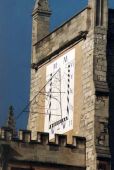 maker,
Harriet James, publlshed an interesting article about the history
of dialling at New College Oxford. She then magnificently
ended her article with a description of her own addition to the
College on the Muniment Tower. maker,
Harriet James, publlshed an interesting article about the history
of dialling at New College Oxford. She then magnificently
ended her article with a description of her own addition to the
College on the Muniment Tower.
This turned out to be a bit
of a saga which Harriet bravely reported for the benefit of all
diallists and she acknowledged the help and advice of others in
getting this quite magnificent dial installed. Those of us
who have our own experience of the design and installation of
large dials know only too well just what problems can arise.
Her end result of a 20 second accuracy is remarkable and her
account of this in her article linked below is well worth reading
or even re-reading!.
Harriet's article of the dials of New College
15.09.20 [EU C-466/12] |
The Dial at Fountains
Hall
Fountains Hall is a Grade 1 listed country house in
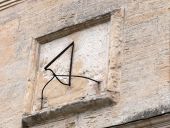 Richmond
(N Yorks) which has a sundial over the front entrance. Amazingly
the dial is not mentioned in the listing and this might account
for its current state. It is a Direct South Dial the gnomon of
which is currently slightly twisted. The lower part of the carved
sandstone dialplate is also badly weathered. Nonetheless it
is all still largely visible and it is well worth a look if you
happen to be in the area. Click on the image here to see a larger
version and
Click Here
to see its setting over the entrance door. Richmond
(N Yorks) which has a sundial over the front entrance. Amazingly
the dial is not mentioned in the listing and this might account
for its current state. It is a Direct South Dial the gnomon of
which is currently slightly twisted. The lower part of the carved
sandstone dialplate is also badly weathered. Nonetheless it
is all still largely visible and it is well worth a look if you
happen to be in the area. Click on the image here to see a larger
version and
Click Here
to see its setting over the entrance door.
29.09.20.
Images courtesy VL Thomson © VLThomson 2020 |
An amusing garden
ornament
But in no way should this be described as a
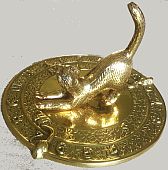 working
sundial. Here's your challenge! How many aspects of
this garden ornament can you see that fail to make it a workable
sundial. This has to be one of the best yet. working
sundial. Here's your challenge! How many aspects of
this garden ornament can you see that fail to make it a workable
sundial. This has to be one of the best yet.
Click on the image to
see a larger version from which you can see at least three generic
problems. Do you know of a dial that is similarly incorrect though
well made as an ornament. Send your images to the
webmaster!!
10.05.21 |
NASS (The North American Sundial Society) held its
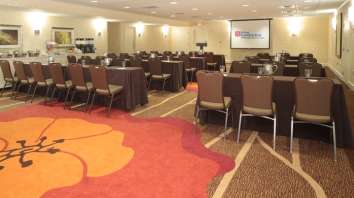 2018
Annual Conference from Thurs 16 Aug - Sun 19 Aug in Pittsburgh, Pennsylvania,
USA. The conference was held near the famed University of Pittsburgh campus with
its Cathedral of Learning at the Hilton Garden Inn, Pittsburgh University Place
3454 Forbes Avenue, in Pittsburgh.
2018
Annual Conference from Thurs 16 Aug - Sun 19 Aug in Pittsburgh, Pennsylvania,
USA. The conference was held near the famed University of Pittsburgh campus with
its Cathedral of Learning at the Hilton Garden Inn, Pittsburgh University Place
3454 Forbes Avenue, in Pittsburgh.
19/8/18
 The Frogner Park
Sundial
Just outside Oslo in Frogner Park there lies the Gustav The Frogner Park
Sundial
Just outside Oslo in Frogner Park there lies the Gustav
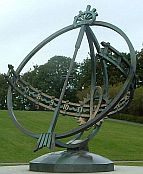 Vigeland Sculpture
Park which is dedicated to the display of the many sculptures of
Adolf Gustav Thorsen who later changed his name to Gustav
Vigeland. Amongst these that were designed and constructed in 1930,
is an interesting half armillary sundial with an Equation of Time
correction analemma appropriately positioned to be read by the
observer using the shadow of the attached nodus. Vigeland Sculpture
Park which is dedicated to the display of the many sculptures of
Adolf Gustav Thorsen who later changed his name to Gustav
Vigeland. Amongst these that were designed and constructed in 1930,
is an interesting half armillary sundial with an Equation of Time
correction analemma appropriately positioned to be read by the
observer using the shadow of the attached nodus.
It is made of bronze on a granite
pedestal which has inset niches depicting the signs of the zodiac.
Click the image or HERE
for a larger view. There is also another sundial on the nearby manor
house. Be sure to find it when you next visit Oslo.
19.07.21 |
Dials
of Polesden Lacey Polesden Lacey is an Edwardian
house and estate, located on
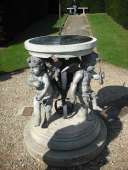 the
North Downs at Great Bookham, near Dorking, Surrey. Built by Thomas
Cubitt Ambrose Poynter it is a designated World Heritage site.
It has several dials the main one was stolen some years ago and a
rather poor replacement has been put in its place on the original
elegant cherubic pedestal. the
North Downs at Great Bookham, near Dorking, Surrey. Built by Thomas
Cubitt Ambrose Poynter it is a designated World Heritage site.
It has several dials the main one was stolen some years ago and a
rather poor replacement has been put in its place on the original
elegant cherubic pedestal.
See the
dials here: Dial 1,
Dial 2,
Dial 3a,
Dial 3b
06.09.19
Images courtesy VL Thomson © VLT 2019 |
Fer De Vries' article of the month
May 2003 At what time is the
sun due south?
 The
answer is often, "at twelve o'clock". That is correct when we mean
XII hours apparent solar time, but here, we want something else. The
answer is often, "at twelve o'clock". That is correct when we mean
XII hours apparent solar time, but here, we want something else.
In order properly to orient a sundial,
it is necessary to know the north-south direction, and it is good
fun to find that direction using the sun and a good watch.
The question now becomes: What time does
our watch read when the sun is due south (north)?
And that will rarely be twelve o'clock
exactly. Click
here
or on the image here to link to Fer's article.
20.03.21 © De Zonnewijzerkring, 2021 |
The Möbius Strip Noon-Mark at Brown University
Several years ago (in the
 USA),
Brown University alumnus Charlie Giancarlo presented
students at the University’s School of Engineering with a grand
design challenge. USA),
Brown University alumnus Charlie Giancarlo presented
students at the University’s School of Engineering with a grand
design challenge.
Giancarlo wanted
to fund the installation of a sculpture to be placed in front of
Brown’s new Engineering Research Centre. He envisioned something
that would represent the rigour of engineering work, but have
artistic beauty as well. He wanted something that people could
touch and interact with, yet would last a long time, at least as
long as the engineering building itself. Most importantly, he
wanted it to be a means of telling time by tracking the sun — a
sundial. He challenged students to come up with a striking design
that met all those criteria and to then oversee its fabrication
and installation.
A student group
took up the challenge, and the result of more than two years of
work — a stainless steel Noon Mark measuring 15 feet long and 4
feet high — was recently installed. The piece, titled “Infinite
Possibility,” is in the form of a Möbius
Strip with a Noon Mark analemma at one end..
More about
this here.
26.12.20 |
 Fer De Vries' article
of the month June 2004
This month Fer considered Fer De Vries' article
of the month June 2004
This month Fer considered
 how
dial design was conducted in years gone by and well before the age
of the computer. Here he shows a few approaches one going back to
Regiomontanus in 1474. how
dial design was conducted in years gone by and well before the age
of the computer. Here he shows a few approaches one going back to
Regiomontanus in 1474.
It is interesting to see how these
things were approached - even if accuracy wasn't quite as good as
it might be today. Click on the image or
HERE
to read the English version of his entry.
19.10.21 |
 Fer De Vries'
article of the month July 2004
This month's topic is the Fer De Vries'
article of the month July 2004
This month's topic is the
 interesting
one of unequal and equal hours. Unequal hours or temporal
hours divided the daylight period between sunrise and sunset in
twelve hours. interesting
one of unequal and equal hours. Unequal hours or temporal
hours divided the daylight period between sunrise and sunset in
twelve hours.
Sundials of the day were thought always to
show equal hours but of course clocks put a stop on that.
Read Fer's short discussion by clicking on the image here or
HERE
30.10.21 |
 The Birkenau Sundial
Meeting 2021
The German Sundial Working Group The Birkenau Sundial
Meeting 2021
The German Sundial Working Group
 celebrated
its 59th Anniversary in August 2021 at a meeting in Birkenau
in the Odenwald - a small town which holds an international record
for the highest sundial density (8 sundials/square km) and a very
creditable 70 people attended.. celebrated
its 59th Anniversary in August 2021 at a meeting in Birkenau
in the Odenwald - a small town which holds an international record
for the highest sundial density (8 sundials/square km) and a very
creditable 70 people attended..
The presentations covered many
interesting topics, ranging from sundial history, books, funding
programs, quizzes to modern technology as applied to sundial
manufacturing. Birkenau in the Odenwald is a small town which
holds an international record for the highest sundial density (8
sundials/square km).
08.11.21 Text courtesy of Dan-George Uza |
 Wichita Dial
rediscovered
A 16 inch diameter bronze dial was presented to Wichita Dial
rediscovered
A 16 inch diameter bronze dial was presented to
 Wichita
State University in 1934 by the then class of 175 graduating
seniors together with a three foot pedestal of white granite. Wichita
State University in 1934 by the then class of 175 graduating
seniors together with a three foot pedestal of white granite.
Photographs show the sundial situated in its original location
throughout the 1940s, but an early 1950s photo from the University
Special Libraries’ Collection shows the sundial with a missing
gnomon. Then, in the mid-1950s, the sundial was apparently removed
from Wichita State’s grounds and lost.
In 2017, after the
death of Wichita State’s Dr. George Platt some of his colleagues
found the sundial. On July 19, 2021, the sundial was
reinstalled and rededicated to Dr. George Platt and placed on the
east side of Hubbard Hall. The motto, which quotes poet Robert
Browning: “Grow old with me, the best is yet to be.”
More
HERE. A dial returned.
30.11.21 |
Fer De Vries' article of the month
June 2003
 How
do we count the hours? It sounds easy but is it? How
do we count the hours? It sounds easy but is it?
It sounds simple enough, but in our daily lives, we use two
systems.
Read Fer's article of the month
HERE
or click on the image. It is in PDF format.
26.04.21 |
Fer De Vries' article of the month
September 2003
This month's article
 by
the late Fer De Vries concerns Bifilar sundials with negative
wires. by
the late Fer De Vries concerns Bifilar sundials with negative
wires.
It is a comment concerning a (then) new(ish) development
in bifilar gnomonics.
The idea came from: Fabio Savian, Italy.
The horizontal bifilar sundial with two crossing wires as a shade
device was invented in 1923, by Hugo Michnik of Germany.
Read fer's article
HERE
20.05.21 |
Fer De Vries' article of the month
August 2003
The latest Fer De Vries
 article
in our series considers the matter of a wide style triangle
gnomon. article
in our series considers the matter of a wide style triangle
gnomon.
Flat pole style sundials usually carry a style
triangle.
The straight edge is the actual style, the shadow of
which indicates the hour.
The designer is otherwise free in his
choice of shape.
Read Fer's article
HERE
19.05.21 |
 The Dandelion...
Here from The Canterbury Festival 2009 is one of the many poems of
Christopher Daniel MBE. The Dandelion...
Here from The Canterbury Festival 2009 is one of the many poems of
Christopher Daniel MBE.
The Dandelion
Nature’s Sundial
My leaves are green and lushly spread,
My stem stands tall with a ‘gilded’ head
My petals fan in
yellow gold;
But I am a weed, or so I am told.
Towards the
sun, I gaze and smile:
Some say that I am Nature’s dial;
But
if I have such natural powers,
I only count the sunny hours!
More do I mark, when I turn grey,
A sphere of seeds in soft
array,
Each tiny parachute a seed,
Born by the wind as
another weed!
***
***
***
31.07.2022
Published with permission
|
Fer De Vries' article of the month
July 2003
In this
interesting article Fer
 discusses
the confusion over the meaning of the word Analemma. discusses
the confusion over the meaning of the word Analemma.
Ptolemeus who lived in Alexandria around 140 AD, copied the
Roman architect Vitruvius in using the word for an ingenious
projection of the celestial globe on the meridian plane.
Read Fers article
HERE
or click on the image to read the next in Fer's interesting
articles.
26.04.21 |
 Hever Castle's Multi
Facet Dial
At Hever Castle in Kent there is a rather worn Hever Castle's Multi
Facet Dial
At Hever Castle in Kent there is a rather worn
 multifacted
pillar dial. It has as many as 24 dials and scaphe dials and is
set on a square plinth and an elegant slender column multifacted
pillar dial. It has as many as 24 dials and scaphe dials and is
set on a square plinth and an elegant slender column
Little
else is known about the origin of this dial Some hour lines
are still visible however. It is recorded in the National
Register as SRN2906.
Click on the image or
HERE to see a larger
image.
06.10.21
Images© VL Thomson,
2021 |
 Hever's Armillary
Sphere
The armillary spherethat can be seen at Hever Castle in Hever's Armillary
Sphere
The armillary spherethat can be seen at Hever Castle in
 Kent was
repositioned
sometime ago and placed in the centre of a flower bed. It
dates back to 1710. Kent was
repositioned
sometime ago and placed in the centre of a flower bed. It
dates back to 1710.
It is placed in the Tudor Chess Set
garden and is looking particularly fine at this time of year.
It has four rings, the scale is white with black numerals. It
shows 6am to 6pm in hours and half hours. There is also an
altitude scale which has been used to establish latitude.
Click HERE
or on the image to see a larger image.
27.09.21
Images©
VL Thomson, 2021 |
 Bekonscot's Model
'Armillary' Sphere
One of the dials displayed at the Bekonscot's Model
'Armillary' Sphere
One of the dials displayed at the
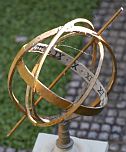 Bekonscot
Model Village in Beaconsfield is an armillary sphere. It is
even logged as SRN 6837 in the National Register but it is unusual
in that the first version - in an aluminium alloy - had many
faults. Bekonscot
Model Village in Beaconsfield is an armillary sphere. It is
even logged as SRN 6837 in the National Register but it is unusual
in that the first version - in an aluminium alloy - had many
faults.
The hour ring was horizontal, the noon marking was
wrongly placed etc. Since then the 40 cm miniature dial has
been corrected, painted to look like brass and aligned and it might now
'work'.
Click the image or
HERE
to see a close up.
25.09.21
Images©
VL Thomson, 2021 |
 Fer De Vries' article
of the month March 2004
On a sunny day, a Fer De Vries' article
of the month March 2004
On a sunny day, a
 diallist
in Utrecht stands on the analemmatic sundial on the Janskerkhof. diallist
in Utrecht stands on the analemmatic sundial on the Janskerkhof.
Not only does he read the time, but his shadow moves
clockwise, and he had not expected otherwise.
However, this
little experiment performed in Capetown would show the shadow to
move counter-clockwise. It is even more fun between the tropics.
Click the image or
HERE
to see more.
11.08.21 |
 Fer De Vries' article
of the month February 2004
This month's article was Fer De Vries' article
of the month February 2004
This month's article was
 written
by Hans de Rijk. written
by Hans de Rijk.
This article shows what happened when
Hans discovered a misaligned sundial in a churchyard...
Click the image to find out...
04.08.21 |
 Fer De Vries' article
of the month January 2004
This month's article Fer De Vries' article
of the month January 2004
This month's article
 from
Fer De Vries shows a very special sundial, or rather a triple
sundial. It is barely visible on a buttress of the Large Church in
Maassluis. from
Fer De Vries shows a very special sundial, or rather a triple
sundial. It is barely visible on a buttress of the Large Church in
Maassluis.
Yet there are three vertical sundials, facing
north-east, south-east and south-west.
This triple dial was
probably made in the 17th century.
30.07.21 |
|
 Fer De Vries'
article of the month December 2003
In this article Fer Fer De Vries'
article of the month December 2003
In this article Fer
 continues
his commentary about definitions relating to dialling. continues
his commentary about definitions relating to dialling.
This time he discusses style height again in a little more
detail and then looks at the 'Translation Rule' which makes it
possible to calculate or construct a randomly oriented sundial
simply as a horizontal sundial
Click the image or
HERE
to read his interesting article made available here courtesy of
the Dutch Sundial Society,
De Zonnewijzerkring.
12.07.21 |
Chatsworth's
Elaborate Multiple Dial
Constructed by Gary Breeze from
 Woodkirk
Yorkstone, this fascinating dial stands on a circular pad set in
the lawn near the Cottage Garden at Chatsworh. It includes a
scaphe dial delineated for 6am to 6pm. a polar dial and an
equatorial dial. Interestingly dots are used to mark some
intermediate hours. Two equatorial dials follow and the two sides
display direct East and West dials. Additionally included on the
ediface are the names, directions and distances of over 40
Derbyshire stone circles and earthworks. The dial is registered as
SRN7645 in the National Register. Woodkirk
Yorkstone, this fascinating dial stands on a circular pad set in
the lawn near the Cottage Garden at Chatsworh. It includes a
scaphe dial delineated for 6am to 6pm. a polar dial and an
equatorial dial. Interestingly dots are used to mark some
intermediate hours. Two equatorial dials follow and the two sides
display direct East and West dials. Additionally included on the
ediface are the names, directions and distances of over 40
Derbyshire stone circles and earthworks. The dial is registered as
SRN7645 in the National Register.
Click on the image or
HERE to see a
selection of views of this dial. The images can be magnified to
give a closer view.
10.09.21
Images©
VL Thomson, 2021 |
Five Years On at
Canons Ashby
It is now just over five years since SunInfo
last
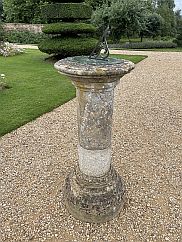 visited
the dial at Canons Ashby to find that when measured for accuracy
in March 2016 and with its displayed solar time duly corrected for
both longitude and EoT it proved to be a very acceptable 3m 30s
fast! visited
the dial at Canons Ashby to find that when measured for accuracy
in March 2016 and with its displayed solar time duly corrected for
both longitude and EoT it proved to be a very acceptable 3m 30s
fast!
The dial was delineated by Richard Glynne who
served his apprenticeship under Henry Wynne and was admitted to
the Guild of Clockmakers in 1705. Click on the image or
HERE for
a few views of how the dial is today.
If you want to see
what we said about the dial in 2016 and the measurements we took
click on the link HERE
An excellent dial.
21.08.21 |
The Sol Horometer -
A falling out of Directors?
In 1906 Gibbs applied
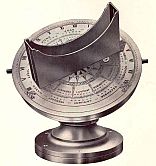 for a patent for a type
of sundial he had designed—the Universal Equinoctial Mean Time
Heliochronometer or Gibbs Heliochronometer for short—which was
able to accurately determine GMT to within a minute at any time of
the year and at any latitude. for a patent for a type
of sundial he had designed—the Universal Equinoctial Mean Time
Heliochronometer or Gibbs Heliochronometer for short—which was
able to accurately determine GMT to within a minute at any time of
the year and at any latitude.
The invention filled a gap in
the market created by the standardization of time in the 1880s
which was only truly alleviated with the broadcast of the BBC pips
in the 1920s. Unable to fund the business venture himself he found
a willing partner in his then employer, William Renard Pilkington,
and together they formed Messrs. Pilkington & Gibbs Ltd. in 1906.
The price ranged from £7 10s to £15 15s and promotional material
indicates they were supplied to a number of important patrons
around the world including HM The King. They were marketed
simultaneously as accurate time-keepers and garden ornaments and
were supplied to owners of large, country estates. As an ornament,
they fitted into the early twentieth century trends in landscape
architecture and were used in garden designs by Mawson and
Lutyens.
The lucrative possibilities of the
Heliochronometer did not escape the attention of Gibbs' partner
Pilkington who applied for a patent in his own right for his own
"Sol Horometer" in 1911 and another two years
later.
Gibbs obtained a copy of the patents and noted on
both: “First [and second] attempt to find a way to escape paying
royalties to GJG”. This might have become difficult except
that production of sundials by the company ceased with the
out-break of WW1 in 1914 from when there is no record of the
partnership continuing in any capacity after 1923. Roughly 1,000
heliochronometers were made before 1914 but many did not survive
the recycling of metal in the later WW2. Click on the image
or
HERE
for a larger version of the image..
20.08.21 |
Fer De Vries'
sundial
of the month April 2004
This month Fer discusses
 'Chimney
Dials' - dials that use chimneys as their support and which often
- though not always use more than one surface to display a dial. 'Chimney
Dials' - dials that use chimneys as their support and which often
- though not always use more than one surface to display a dial.
These in Fer's article are thought to date back as far as
1655.
Click the image or
HERE to
read Fer's article.
01.09.21 |
The Rather Odd Roman
Dial at Hever
One of the several sundials to be
 found
at Hever Castle in Kent is thought to be Roman. It is in
fact also rather a mystery. Indeed Dr Ward of the Science
Museum in London concluded that the 'Roman' scaphe dial at Hever is
a rare example of a Roman sundial showing equal hours, when
classical Greek and Roman sundials more often show unequal’ hours.
Indeed it is possibly unique. David Brown wrote an interesting
analysis of this dial which (courtesy of BSS) may now be read
HERE. Find out if it can be considered a
working dial. found
at Hever Castle in Kent is thought to be Roman. It is in
fact also rather a mystery. Indeed Dr Ward of the Science
Museum in London concluded that the 'Roman' scaphe dial at Hever is
a rare example of a Roman sundial showing equal hours, when
classical Greek and Roman sundials more often show unequal’ hours.
Indeed it is possibly unique. David Brown wrote an interesting
analysis of this dial which (courtesy of BSS) may now be read
HERE. Find out if it can be considered a
working dial.
12.10.21 [EU C-466/12
as incorporated into UK law] |
The Silas Higgon
Dial at Alton Towers
Quite well hidden in the gardens area
 of
Alton Towers is this attractive dial by Silas Higgon of
Shropshire. of
Alton Towers is this attractive dial by Silas Higgon of
Shropshire.
It has a precision time scale and an EoT graph but
its real attraction is surely the wonderful gnomon. All set
high up on an elegant column.
Click on the image or
HERE to see a few
images of this interesting dial.
08.10.21
Images© VL Thomson,
2021 |
Fer De Vries' article
of the month May 2004
"Reusing the pattern"
 Usually a sundial designates time in hours, but this
horizontal sundial indicates the hour angle in degrees. Usually a sundial designates time in hours, but this
horizontal sundial indicates the hour angle in degrees.
This example was made for 52 degrees latitude, whether north or
south. You just need to know which part is for morning, and which
for the afternoon hour angles. Click on the image or
HERE
to read the article.
19.09.21 |
Bodnant Garden
Sundial
Bodnant Garden in Tal-y-Cafn, nr Colwyn Bay, Wales
 is
a National Trust property in the Snowdonia foothills. is
a National Trust property in the Snowdonia foothills.
Covering
nearly 80-acres (32 ha) it holds a collection made by several
famous global explorers. More importantly for some it is
also the home to an interesting Pilkington and Gibbs sundial,
complete with a bronze base plate which indicates compass
directions and the directions of some local landmarks. On 8th May
1906 George James Gibbs was granted a patent on a mechanical
‘universal’ equinoctial meantime sundial. Mr Gibbs went into
partnership with a William Renard Pilkington to form Messrs
Pilkington & Gibbs of Ribble Bank Mills, Preston Lancashire and to
produce the heliochronometer.
Click the image or HERE
for a close up image of this interesting dial.
13.09.21 Thumbnail © Copyright Richard Hoare, Main image
© P Strudwick |
I am a Sundial..?
Hilaire Belloc's Collected Verse 1910 contained the
famous and
 amusing
verse:
"I am a sundial, and I make a botch
of what is done far better by a watch". Twenty three
years ago this year, on the occasion of a dinner of the Royal
Astronomical Society Club then being held at the Athenaeum on
Friday 14 February 1997, Christopher Daniel MBE delivered a poem
also entitled "I am a Sundial". You may like to read it
HERE or by clicking the image above. amusing
verse:
"I am a sundial, and I make a botch
of what is done far better by a watch". Twenty three
years ago this year, on the occasion of a dinner of the Royal
Astronomical Society Club then being held at the Athenaeum on
Friday 14 February 1997, Christopher Daniel MBE delivered a poem
also entitled "I am a Sundial". You may like to read it
HERE or by clicking the image above. |
 T.W.Cole's 1935 Treatise on Scratch Dials
A scratch
(or mass) dial is a
T.W.Cole's 1935 Treatise on Scratch Dials
A scratch
(or mass) dial is a
 form
of sundial, used by medieval parsons to mark the time for
services. These dials, about the size of one's hand, are scratched
on the south wall of old country churches at about eye level. What
they originally looked like we do not know. All that remains
to-day is a central hole from which radiate a few lines cut in the
stonework. form
of sundial, used by medieval parsons to mark the time for
services. These dials, about the size of one's hand, are scratched
on the south wall of old country churches at about eye level. What
they originally looked like we do not know. All that remains
to-day is a central hole from which radiate a few lines cut in the
stonework.
Read more
Here of what TW Cole wrote about these fascinating
early sundials - used to ensure greater timliness in the
celebration of Christian services and look out for them when next
looking around a church.
13.04.2022 |
Palma's Sundial
Heaven!
The island of Mallorca has the highest concentration
 of
sundials per square kilometre in the world – 829 in fact, of which
112 are located in Palma itself. They are to be found in the most
characterful buildings of the island such as churches, convents,
historic public and private buildings, as well as on streets and
in ‘plazas’ and they often go unnoticed of
sundials per square kilometre in the world – 829 in fact, of which
112 are located in Palma itself. They are to be found in the most
characterful buildings of the island such as churches, convents,
historic public and private buildings, as well as on streets and
in ‘plazas’ and they often go unnoticed
A visitor walking
through Palma’s Old Town can quickly spot a large number of them.
For example, on the main façade facing the famous Paseo del Borne
in Plaza Juan Carlos I, on the San Nicolás church (on the side of
Plaza de Santa Catalina Tomás), on the façade in Calle Bolsería 1,
in Plaza Sta. Eulalia (on the corner with Cadena Street), in Plaza
San Francisco (on the front of the church of the same name), in
Portella Street no.8 and in the Bishop’s Palace.
These
magnificent sundials are scattered around the city and are easily
missed unless you look for them. Click on the image and
HERE for a permitted link to just two of Palma's
dials.
13.12.2021
[
[EU C-466/12
retained and as amended] |
Sundial
at St Peter’s Archabbey in Salzburg
There is more than one
 sundial
at the Archabbey which is considered to be one of the oldest
monasteries in the German-speaking area and in fact the oldest
with a continuous history since its foundation in 696 by Saint
Rupert at the site of a Late Antique church. After the Austrian
Anschluss to Nazi Germany in 1938, the premises were seized and
most of the monks expelled. Nevertheless, the monastery was not
dissolved and amazingly the monks were able to return after the
war. The west declining dial shown here shows seven declination
lines below St Rupert and his raven. sundial
at the Archabbey which is considered to be one of the oldest
monasteries in the German-speaking area and in fact the oldest
with a continuous history since its foundation in 696 by Saint
Rupert at the site of a Late Antique church. After the Austrian
Anschluss to Nazi Germany in 1938, the premises were seized and
most of the monks expelled. Nevertheless, the monastery was not
dissolved and amazingly the monks were able to return after the
war. The west declining dial shown here shows seven declination
lines below St Rupert and his raven.
Click on the thumbnail for
a permitted link to an image of the dial.
09.12.2021
[
[EU C-466/12
retained and as amended] |
Weston Park's Rare
Coade Stone Dial Restored!
Way back in 2017 (see
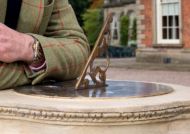 our
Suninfo Archive 2) we announced that a second
rare sundial plinth had been found among nettles at Weston Park.
It has now been restored and takes centre stage in the formal
gardens there. It turned out that this pedestal was a rare Coade
stone one made in the 1790s by that extraordinary entrepreneur of
the time, Eleanor Coade and was notable for being twice fired.
Funding for restoration was obtained and the plinth went to be
restored by Phil Thomasson, a Dorset-based specialist conservator.
To accompany the restoration a new sundial has also been made to
replace the missing original, by Robert Foster of Jackfield. our
Suninfo Archive 2) we announced that a second
rare sundial plinth had been found among nettles at Weston Park.
It has now been restored and takes centre stage in the formal
gardens there. It turned out that this pedestal was a rare Coade
stone one made in the 1790s by that extraordinary entrepreneur of
the time, Eleanor Coade and was notable for being twice fired.
Funding for restoration was obtained and the plinth went to be
restored by Phil Thomasson, a Dorset-based specialist conservator.
To accompany the restoration a new sundial has also been made to
replace the missing original, by Robert Foster of Jackfield.
The pedestal had been last seen at Weston in the early twentieth
century, when it appeared in a photograph of Margaret Countess of
Bradford and her children. In those days it was on the top terrace
of the south front, presiding over the Victorian formal gardens
designed for the 3rd Earl of Bradford. The sundial plinth had
originally been supplied to Sir Henry and Lady Bridgeman of Weston
Park in 1779.
The agents’ accounts for 1779, which are now in
the care of Staffordshire Archives tell us that on the 1st of
January that year Mrs Coade was paid £28 for the plinth.
Restoration in 2020/1 cost the Foundation considerably more, in
being just under £20,000. Click the image or
Here for a full picture.
Read an article about this excellent development
Here.
04.12.2021 Courtesy Weston Park Enterprises |
Previously unknown UK sundial location
revealed! The National
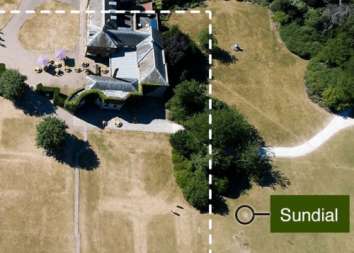 Trust property of Clumber
Park in Nottinghamshire recently suffered from a drought. The building that once
stood on here was Clumber House - a grand 18th-Century mansion which was
demolished in 1938 after a series of fires and the subsequent economic downturn. Trust property of Clumber
Park in Nottinghamshire recently suffered from a drought. The building that once
stood on here was Clumber House - a grand 18th-Century mansion which was
demolished in 1938 after a series of fires and the subsequent economic downturn.
In the present drought, rooms and corridors of the old house have
become visible as stone foundations left in the ground heated up more quickly
than surrounding material, scorching the soil above to a lighter shade.
Although the location of the lost mansion is well known, amazingly the
location of a previously unknown sundial in front of the lawn has been
identified -
see this image..
More about this and
other drought related discoveries from the BBC here
17.07.18 |
Shadow Clocks of the
Ancient World
Time in the ancient world was first
 measured
by naturally occurring events, such as sunrise, sunset, and meal
times. In the early ages of Rome and even down to the middle of
the fifth century after the foundation of the city no other
divisions of the day were known than sunrise, sunset and midday,
which were marked by the arrival of the Sun between the Rostra and
a place called Graecostasis. measured
by naturally occurring events, such as sunrise, sunset, and meal
times. In the early ages of Rome and even down to the middle of
the fifth century after the foundation of the city no other
divisions of the day were known than sunrise, sunset and midday,
which were marked by the arrival of the Sun between the Rostra and
a place called Graecostasis.
The single greatest literary
source that exists for the sundials of Greece and Rome is
Vitruvius's Ten Books on Architecture written about 25 B.C. In
Book 9, Vitruvius gives a list of a variety of dials and their
inventors.
Sundials resembling the kind of which Vitruvius
speaks were in use in Egypt from at least 1200 B.C. A near
complete sundial was found at Kantara, Egypt dating back to
approximately 320 B.C., well over a thousand years after the
shadow clocks were in operation Click on the image here or
HERE to read a fascinating article by Daniel Mintz
(University of St Andrews).
26.11.21 |
William Emerson
was an extraordinary mathematician of great repute and fame in his
 own
lifetime, definitely Hurworth’s most famous son and someone
thought to have made at least 30 sundials which he put all over
the village to test his theories. own
lifetime, definitely Hurworth’s most famous son and someone
thought to have made at least 30 sundials which he put all over
the village to test his theories.
The only authentic sundial of
his that is said to remain is that on the Bay Horse pub in
Hurworth - see image here dated 1739.
Watson's sister married the landlord
and this dial is thought to have been a wedding present. Sundials aside, Emerson was a
remarkable man, of eccentric habits – and not just for his
prodigious consumption of beer. After his schooling in Newcastle
and York he returned in 1730 aged 42 whereupon he published his
first book, The Doctrine of Fluxions – what today is
called calculus and first devised by Sir Isaac Newton – and it even became a bestseller. Click on the
image or
HERE to read an excellent article courtesy of the
Northern Echo about this bad tempered genius.
23.11.21 Images and article
© Northern Echo |
The Extraordinary
Dials of Seaton Ross
This link takes the recent
 celebration
of William Watson further by showing some of his extraordinary
dials still extant today. Two of these are truly enormous one
being no less than some 12 feet in diameter and mounted on a
cottage wall. celebration
of William Watson further by showing some of his extraordinary
dials still extant today. Two of these are truly enormous one
being no less than some 12 feet in diameter and mounted on a
cottage wall.
Click on the image or
HERE to go to our separate
page that gives more information about these dials.
19.11.21
Images and texts© A.
Sefton &Pocklington & District Local History Group 2021. Published
with permission |
Celebrating William
Watson
A public sundial has been erected in memory of
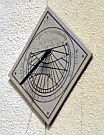 self-taught
19th century Yorkshire astronomer and diallist William Watson. It
is a copy of an original design from Watson’s own notebook, and
made in Corian by Yorkshire-based sundial designer Stephen
Holehan. self-taught
19th century Yorkshire astronomer and diallist William Watson. It
is a copy of an original design from Watson’s own notebook, and
made in Corian by Yorkshire-based sundial designer Stephen
Holehan.
The dial has been placed on the gable end of a shop in
George Street, Pocklington
Born in Seaton Ross in 1784,
near Market Weighton, Watson was the child of local farmer John
Watson and his wife Sarah.
In 1854 he wrote a book called
Dialling Diagrams and he was a member of Pocklington’s Institute
for Improvement in Science and Literature, founded in 1849.
Watson was buried in Seaton Ross in 1857 and his gravestone is
marked “At this church I so often with pleasure did call, that I
made a sun-dial upon the church wall. Click the image or
HERE for a larger image.
10.11.21 |
Richard Mallett's
Twitter
Page
Former BSS Webmaster,
Richard Mallett sadly died in November 2016 - his obituary
is at this link and in the reference section below. However
recently it was discovered that his twitter account up to the time of
his untimely death has survived him. It was of course written for
his many followers and the topics range all over his interests from
daily events, television and to sport. His humour comes out
wonderfully in the many wry comments which also show his depth of
knowledge on so many topics. Those who remember him - and those
who perhaps do not - will surely be interested to look at this
fascinating resource. Click
HERE
to see more.
18.08.21 |
A Collection of
Scottish Sundials
Scottish sundials of the renaissance period
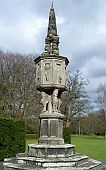 are
surely unique. Many are free standing stone sculptures of the 17th
and 18th centuries with many small dials engraved on them.
Accurate timetelling is often not the aim. Precision is sacrificed
for decorative effective and the mathematical complexity of the
dials is often decoration enough. The ancient sundials of Scotland
can be grouped into three main styles: lectern, obelisk and
facet-head though there are many more conventional ones too.
Have a look at this Scottish Dial Register of
over 100 Dials listed
HERE are
surely unique. Many are free standing stone sculptures of the 17th
and 18th centuries with many small dials engraved on them.
Accurate timetelling is often not the aim. Precision is sacrificed
for decorative effective and the mathematical complexity of the
dials is often decoration enough. The ancient sundials of Scotland
can be grouped into three main styles: lectern, obelisk and
facet-head though there are many more conventional ones too.
Have a look at this Scottish Dial Register of
over 100 Dials listed
HERE
21.05.21 |
Just in time for
Christmas! How it was done!
As if it might have been
 intended,
a cache of images depicting design aspects relating to some of the
dials that Christopher Daniel designed has come to light and
Suninfo is able to publish them. These
were included in with those that Christopher wanted to place on
his web site but were not thought at the time to be ones for
inclusion there. By way of a 'taster'
we show this which shows a
youthful Chris working to layout one of the dials that would later
be installed on St Margaret's Church in London - the church next
to Westminster Abbey. How it was done back in the day! We
shall have more to show in the New Year. Make sure you come back
to see!! intended,
a cache of images depicting design aspects relating to some of the
dials that Christopher Daniel designed has come to light and
Suninfo is able to publish them. These
were included in with those that Christopher wanted to place on
his web site but were not thought at the time to be ones for
inclusion there. By way of a 'taster'
we show this which shows a
youthful Chris working to layout one of the dials that would later
be installed on St Margaret's Church in London - the church next
to Westminster Abbey. How it was done back in the day! We
shall have more to show in the New Year. Make sure you come back
to see!!
24.12.2021
© Copyright Christopher Daniel published with
permission |
 The Dial of
Whitehall
Not the Whitehall in London of course but the one in The Dial of
Whitehall
Not the Whitehall in London of course but the one in
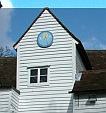 Cheam,
one of the row of weatherboarded houses in Malden Road. The first
and most imposing of these is Whitehall. With its projecting upper
storey, and sloping porch, Whitehall is a landmark of the Cheam
Village Conservation Area. Built in the early sixteenth century,
Whitehall and its residents have played an important part in local
life. The Friends of Whitehall Sundial was commissioned from
Brookbrae and designed by Julia Wright Des RCA and Brian Wright
ARCA in recognition of Mr. W A Devereux OBE. First Chairman of the
Friends. It was installed at the rear of the building in 1985 on
the seventh anniversary of the opening of the house. Click on the
image to see a drawing of the dial's layout. Cheam,
one of the row of weatherboarded houses in Malden Road. The first
and most imposing of these is Whitehall. With its projecting upper
storey, and sloping porch, Whitehall is a landmark of the Cheam
Village Conservation Area. Built in the early sixteenth century,
Whitehall and its residents have played an important part in local
life. The Friends of Whitehall Sundial was commissioned from
Brookbrae and designed by Julia Wright Des RCA and Brian Wright
ARCA in recognition of Mr. W A Devereux OBE. First Chairman of the
Friends. It was installed at the rear of the building in 1985 on
the seventh anniversary of the opening of the house. Click on the
image to see a drawing of the dial's layout.
02.01.22 |
The Sundial in
Kufstein, Austria
Here we are able to show an interesting East
 declining
dial dating back in its design to 1733 in Kufstein, a city in the
Austrian state of Tyrol which is the second largest Tyrolean city
after the state capital Innsbruck. In the upper part, can be seen
a motto which translates as : ‘I only show the sunny hours, the
gloomy and dark ones I conceal’. By UK standards the sundials of
Austria are more elaborate with this sundial, located in the
Austrian mountains, even showing a big sailing ship in the
background. Click the image or
HERE for a link to the Travelwriticus image to whom
we are indebted for this image. We hope to show more Austrian
dials in the future. declining
dial dating back in its design to 1733 in Kufstein, a city in the
Austrian state of Tyrol which is the second largest Tyrolean city
after the state capital Innsbruck. In the upper part, can be seen
a motto which translates as : ‘I only show the sunny hours, the
gloomy and dark ones I conceal’. By UK standards the sundials of
Austria are more elaborate with this sundial, located in the
Austrian mountains, even showing a big sailing ship in the
background. Click the image or
HERE for a link to the Travelwriticus image to whom
we are indebted for this image. We hope to show more Austrian
dials in the future.
15.12.2021
Image ©Travelwriticus Reproduced by permission. |
The Ahakista
Memorial
On the shore near Ahakista village on the Sheep's Head
 penninsula
in West Cork, is a modern stone sundial, delineated by Capt. Owen
M. Deignan, the well known and much liked Irish diallist. It
is of course the memorial to the Air India Flight 182 which blew
up at an altitude of 31,000 feet over the south-west tip of
Ireland, killing all 329 aboard including 60 children under the
age of 10. Michael Harley's website shows the dial which also
marks the exact time of the disaster. Click the image here or
HERE
to read more. penninsula
in West Cork, is a modern stone sundial, delineated by Capt. Owen
M. Deignan, the well known and much liked Irish diallist. It
is of course the memorial to the Air India Flight 182 which blew
up at an altitude of 31,000 feet over the south-west tip of
Ireland, killing all 329 aboard including 60 children under the
age of 10. Michael Harley's website shows the dial which also
marks the exact time of the disaster. Click the image here or
HERE
to read more.
09.02.2022
Image © Copyright Michael J Harvey |
 The Kilmalkedar
Sundial
Some of the earliest sundials in Ireland, made of stone The Kilmalkedar
Sundial
Some of the earliest sundials in Ireland, made of stone
 and
over a thousand years old, are to be found in the ruins of
monastic settlements. This one is at Kilmalkedar on the Dingle
Peninsula, Co. Kerry. Its pillar is about 1.2m high and the
rectangular shaft and the semi-circular head are smoothed in their
finish. The SE face of the head is divided into four equal
sections by lines radiating from the gnomon hole. The north west
face of the head is decorated with what has been called a cross of
arcs. It is now believed that these crosses of arcs - for
they occur on other similar dials - were a 'symbol of pilgrimage'.
Click on the image or
HERE to see a larger image courtesy of
Michael
Harvey and
over a thousand years old, are to be found in the ruins of
monastic settlements. This one is at Kilmalkedar on the Dingle
Peninsula, Co. Kerry. Its pillar is about 1.2m high and the
rectangular shaft and the semi-circular head are smoothed in their
finish. The SE face of the head is divided into four equal
sections by lines radiating from the gnomon hole. The north west
face of the head is decorated with what has been called a cross of
arcs. It is now believed that these crosses of arcs - for
they occur on other similar dials - were a 'symbol of pilgrimage'.
Click on the image or
HERE to see a larger image courtesy of
Michael
Harvey
25.01.2022
Image © Copyright Michael J Harvey |
 The 'Daring
Vessel’ sundial
Early in 2019 .submissions were invited from The 'Daring
Vessel’ sundial
Early in 2019 .submissions were invited from
 artists
for an art sculpture/ installation piece that would tell the story
of the arrival at Ballinskelligs Bay of Amergin (Co. Kerry) and
the first Gaelic peoples to Ireland from Northern Spain - The so
called ‘Song of Amergin’. Holger C. Lὃnze's 'Daring Vessel’sundial
sculpture was successful and was awarded the commission. artists
for an art sculpture/ installation piece that would tell the story
of the arrival at Ballinskelligs Bay of Amergin (Co. Kerry) and
the first Gaelic peoples to Ireland from Northern Spain - The so
called ‘Song of Amergin’. Holger C. Lὃnze's 'Daring Vessel’sundial
sculpture was successful and was awarded the commission.
His
6.4 metre high repoussé bronze sundial gnomon is a tribute to
Amergin and the mythological Milesian seafarers from Galicia in
Northern Spain, who, according to legend, brought the Gaeilge
language to Ireland.
The gnomon sculpture forms the focal point
of the monument and takes the form of the emerging prow of a boat
breaking upwards through the Atlantic waves, which rises, tapering
as it elongates, and turns into the beak of a gannet.
The song
is also included in English, Modern Irish and German on the nearby
information plaque. The gnomon’s shadow moves across the bronze
hour-lines, marked with Roman numerals and the 10 minute divisions
marked by the white joints of the outer black tile ring, in the
large beach-like semi-circle. Click on the image or
HERE for a
larger view.
02.03.2022
Image © Copyright and information Michael J Harvey |
 Lady Nicolson, CH.
1892 – 1962
Otherwise more commonly known as Vita Lady Nicolson, CH.
1892 – 1962
Otherwise more commonly known as Vita
 Sakville-West
was an English authoress and garden designer. Sakville-West
was an English authoress and garden designer.
Sackville-West
was a successful novelist, poet, and journalist, as well as a
prolific letter writer and diarist. She published more than a
dozen collections of poetry and 13 novels during her lifetime. She
was twice awarded the Hawthornden Prize for Imaginative
Literature: first, in 1927 for her pastoral epic, The Land, and in 1933
for her Collected Poems. She was the inspiration for the
protagonist of Orlando: A Biography, by her famous friend and
lover, Virginia Woolf.
She had a longstanding column in The
Observer (1946–1961) and is remembered for the celebrated garden
at Sissinghurst created with her husband, Sir Harold Nicolson.
Rather more to the point she liked Sundials! She
once said:
"Then there are sundials. I
rather like sundials. They must be plain and straightforward; not
arty-crafty; be functional; be placed not as mere adornment but
where they will fulfil their duty; however the puzzled things may
get by summer-time".
Very good advice.
28.02.2022 |
 The Dial at Culdaff
The Church of Ireland church in Culdaff (pop 237), in the
The Dial at Culdaff
The Church of Ireland church in Culdaff (pop 237), in the
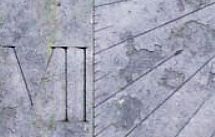 Inishowen
peninsula of County Donegal, Ireland, is typical of the standard
two-and three-bay hall and tower churches, which were built in
large numbers, particularly between 1808 - 1830, using loans and
grants from the Board of First Fruits [Bord na Prímhide 1722 -
1833. Inishowen
peninsula of County Donegal, Ireland, is typical of the standard
two-and three-bay hall and tower churches, which were built in
large numbers, particularly between 1808 - 1830, using loans and
grants from the Board of First Fruits [Bord na Prímhide 1722 -
1833.
Three metres up on the south wall of St. Baudan's is
a 600mm wide by 20mm thick vertical direct south facing slate
sundial dated 1820. It is canted (or wedged) out approximately
50mm along the east edge and is held in place by four
now-corroding iron brackets with resultant minor rust stains on
the face of the dial. It is engraved to show the time from 6am to
6pm in Roman numerals with hour, half hour, quarter hour and 5
minute divisions. There is a noon gap to compensate for the
thickness of the brass gnomon. The slate is sadly now split from
top to bottom and while the slate has moved a little vertically
there is only minor chipping along the break line and the two
halves are still held in place. Sadly too, the dial maker is not
known. Click the image or
HERE for an image of the dial.
.
24.02.2022
Image © Copyright and information Michael J Harvey |
 The Fleet Street
Sundial
Installed
only
a few months ago in London, the design The Fleet Street
Sundial
Installed
only
a few months ago in London, the design
 is
by Piers Nicholson, who had happened to move into the Fleet Street
building next door a decade ago and was curious about what could
be done to improve an otherwise blank wall. is
by Piers Nicholson, who had happened to move into the Fleet Street
building next door a decade ago and was curious about what could
be done to improve an otherwise blank wall.
It’s taken this
decade to persuade successive owners of the building to put
something on the wall, and it’s to their credit that the current
owners have finally agreed that a newspaper-style sundial would be
a good thing to have, and the City of London who decided in April
to cover the outstanding costs of installing it.
Five old
newspaper titles were chosen to fill in the lines, The Republican,
Pall Mall Gazette, The Morning Post, News Chronicle, and The Daily
Herald.
The newspaper at the top, The Republican was actually
based at this location, in a building that was demolished in the
1880s to widen the side street, and it was the only London paper
to publish a report of the Peterloo Massacre in 1819. Piers is
certainly to be congratulated.
Click the image or
HERE to read more
21.03.2022 |
 The Kew Palace
Sundial
In front of Kew Palace is a sundial, which was given to The Kew Palace
Sundial
In front of Kew Palace is a sundial, which was given to
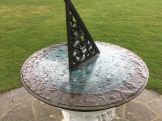 Kew
Gardens in 1959 to commemorate a visit by the late Queen Elizabeth II. It
was sculpted by Martin Holden and is a replica of one by Thomas
Tompion, a celebrated 17th-century clockmaker, which had been
sited near the surviving palace building since 1832 to mark the
site of James Bradley's observations leading to his discovery of
the aberration of light. Kew
Gardens in 1959 to commemorate a visit by the late Queen Elizabeth II. It
was sculpted by Martin Holden and is a replica of one by Thomas
Tompion, a celebrated 17th-century clockmaker, which had been
sited near the surviving palace building since 1832 to mark the
site of James Bradley's observations leading to his discovery of
the aberration of light.
It shows solar time from 4am to
8pm in half and quarter hours and, in Arabic numerals, 10 and 1
min marks. It has a table by which to correct for the equation of
time. There is an ornate 'florally' pierced gnomon all set on a
square section baluster pedestal with a circular capital and an
octagonal plinth. Click on the image or
HERE to see a few images of
this lovely replical.
18.03.2022 |
 Brigit's Garden in
Galway
A 20 minute drive north of Galway City in Eire there is Brigit's Garden in
Galway
A 20 minute drive north of Galway City in Eire there is
 Brigit's
Garden within which is a 16 metre diameter calendar-sundial which
has fifteen declination lines, one for the first day of each
month, one for the equinoxes and two for the solstices. The
shadow is cast by a 1.75 metre high bog oak gnomon with the tip of
the shadow indicating the time and date. Since the dial is
about 9 degrees west of Greenwich the sun is at its highest at
about 12.35 pm GMT or about 1.35 pm during Summer Time. At this
time the shadow points due North on the sundial. Click on the
thumbnail or HERE
for a larger view. Brigit's
Garden within which is a 16 metre diameter calendar-sundial which
has fifteen declination lines, one for the first day of each
month, one for the equinoxes and two for the solstices. The
shadow is cast by a 1.75 metre high bog oak gnomon with the tip of
the shadow indicating the time and date. Since the dial is
about 9 degrees west of Greenwich the sun is at its highest at
about 12.35 pm GMT or about 1.35 pm during Summer Time. At this
time the shadow points due North on the sundial. Click on the
thumbnail or HERE
for a larger view.
15.03.2022
Image © Copyright,
permission and information Michael J Harvey |
 'The Dublin Sphere'
One of two dials in the National Botanic Gardens of Dublin 'The Dublin Sphere'
One of two dials in the National Botanic Gardens of Dublin
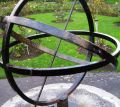 City,
this black iron armillary sphere is located in the Rose Garden
where it replaced the Lynch dial which had been moved to be beside the
Palm House. Click on the image here for a larger version. City,
this black iron armillary sphere is located in the Rose Garden
where it replaced the Lynch dial which had been moved to be beside the
Palm House. Click on the image here for a larger version.
The
sphere itself is 320mm in diameter, mounted on a 80mm high x 40mm
diam stand with a 150mm diam base and bolted to the 460mm diam top
of an 1120mm high fluted sandstone column.
See image HERE.
This
in turn sits on a circular three step base. A bronze time ring is
planted (screwed) onto the iron Equatorial Ring with hours from
4am to 8pm in Arabic numerals. Each hour is sub-divided at 10 min
intervals. Designed by Ireland's Owen Deignan, it was constructed
by Ted Sweeney in 1987.
The 48 acre gardens are located at
Glasnevin, North of the city centre.
12.03.2022
Image © Copyright,
permission and information Michael J Harvey |
Check out the dials on the Burlingham Walks of Norfolk.
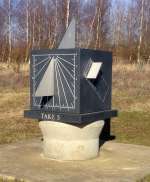 Courtesy
of Annabel Payne, see the new website, which covers some of her father David's
dials that have been carefully located in the woodland trails located North of
Lingwood Village. The 3,000 acre estate was acquired by Norfolk County Council
in the early years of the 20th century and became part of a scheme to provide
farms for heroes returning from the First World War. Courtesy
of Annabel Payne, see the new website, which covers some of her father David's
dials that have been carefully located in the woodland trails located North of
Lingwood Village. The 3,000 acre estate was acquired by Norfolk County Council
in the early years of the 20th century and became part of a scheme to provide
farms for heroes returning from the First World War.
See more of this site
Here.
28.02.18, 21.06.18 |
|
 'The Dublin Sphere'
One of two dials in the National Botanic Gardens of Dublin 'The Dublin Sphere'
One of two dials in the National Botanic Gardens of Dublin
 City,
this black iron armillary sphere is located in the Rose Garden
where it replaced the Lynch dial which had been moved to be beside the
Palm House. Click on the image here for a larger version. City,
this black iron armillary sphere is located in the Rose Garden
where it replaced the Lynch dial which had been moved to be beside the
Palm House. Click on the image here for a larger version.
The
sphere itself is 320mm in diameter, mounted on a 80mm high x 40mm
diam stand with a 150mm diam base and bolted to the 460mm diam top
of an 1120mm high fluted sandstone column.
See image HERE.
This
in turn sits on a circular three step base. A bronze time ring is
planted (screwed) onto the iron Equatorial Ring with hours from
4am to 8pm in Arabic numerals. Each hour is sub-divided at 10 min
intervals. Designed by Ireland's Owen Deignan, it was constructed
by Ted Sweeney in 1987.
The 48 acre gardens are located at
Glasnevin, North of the city centre.
12.03.2022
Image © Copyright,
permission and information Michael J Harvey |
 The 'Other' (Older) Chevening Dial
There is another dial at Chevening. It is to be found
The 'Other' (Older) Chevening Dial
There is another dial at Chevening. It is to be found
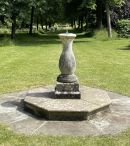 in
the walled garden. Little is known of it and its history but
it is clearly well delineated and of some age. It is an
horizontal dial set on an elegant pedestal and mounted on an
octagonal plinth. in
the walled garden. Little is known of it and its history but
it is clearly well delineated and of some age. It is an
horizontal dial set on an elegant pedestal and mounted on an
octagonal plinth.
Click on the thumbnail image here - or
HERE - to see
a closeup of the dialplate itself. This may be further
magnified a little if desired.
Sadly, although possibly
signed it does not appear to
be readable. Possibly designed originally to provide a correction
for clocks in the house.
26.06.2002 Image
© Copyright M Thomson |
 The Dial at Hartland Abbey In
North Devon there stands Hartland Abbey the home
The Dial at Hartland Abbey In
North Devon there stands Hartland Abbey the home
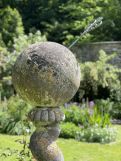 of
the Stucley family. It was built in the 12thC. Hartland Abbey
survived as a monastery longer than any other in the country. In
1539 Henry VIII gifted the Abbey to the Keeper of his Wine Cellar
whose descendants still live here today. It is probably the most
historically important ancestral home in North Devon, containing
much of national interest. of
the Stucley family. It was built in the 12thC. Hartland Abbey
survived as a monastery longer than any other in the country. In
1539 Henry VIII gifted the Abbey to the Keeper of his Wine Cellar
whose descendants still live here today. It is probably the most
historically important ancestral home in North Devon, containing
much of national interest.
The beautiful 18thC Walled and
Woodland gardens, the walks and the parkland provide visitors with
extensive grounds through which to wander and to enjoy. In the
garden there is a rather rare spherical dial, sadly now without
its gnomon, but it still provides a focal point and shows just how
these dials were constructed. Click on the thumbnail or
here
for a larger image.
10.06.2022 Images © M & V Thomson, 2022 |
The Dial in Ashridge
House Gardens
There is an armilliary sphere sundial in
 the
National Trust's Ashridge House Gardens in Hertfordshire.
Marked on the dial rings is this text ‘THERE’S ROSEMARY FOR
REMEMBRANCE’ and the base has a motto ‘Rejoiceth as a giant to run
his course' which is taken from Psalm 19:5. the
National Trust's Ashridge House Gardens in Hertfordshire.
Marked on the dial rings is this text ‘THERE’S ROSEMARY FOR
REMEMBRANCE’ and the base has a motto ‘Rejoiceth as a giant to run
his course' which is taken from Psalm 19:5.
Click on
the image or HERE to see several
images of the dial. Any image can be enlarged from within
your browser by pressing CTRL/+
06.10.21
Images© VL Thomson,
2021 |
 Puns on Mottoes?
Here is an excellent Austrian sundial which unusually
Puns on Mottoes?
Here is an excellent Austrian sundial which unusually
 includes
a pun. It is on the Austrian version of the common English motto:
'I count only the sunny hours'. includes
a pun. It is on the Austrian version of the common English motto:
'I count only the sunny hours'.
The dial is at an old
inn located in the village of 'Golling an der Salzach', population c
5000. The saying in the right bottom corner of the dial tells us
that this clock 'is not counting the cloudy hour' which phrase is
actually a pun. The German term trüb describes a weather condition
as well as a mood. So the phrase invites people not to stick to a
bad mood. Are there other examples of puns in sundial
mottoes?
The village is located on the southern rim of the
Tennengau region south of the city of Salzburg and interestingly
it has a notable 19thC resident, Joseph Mohr (1792–1848), who
wrote the words to the Silent Night Christmas carol. We diallists
certainly 'get about'. Click on the image or
HERE for more.
12.05.2022 |
An Horological History of Charing in Kent
There is an
 interesting
book by Christopher HK Williams, formerly of Charing in Kent that
concerns the horological history of Charing itself.
Charing’s horological timeline shows that over half Charing’s
horological history is that of the scratch or mass dial. Yet, of the
numerous scratch dials cut over the centuries, only one disappearing
example survives there - though of course many such exist in the
Southern UK. He write that its successor, the scientific sundial,
was essential to set and regulate clocks for three centuries. Only
with the establishment of railway time, telegraphic and then radio
time signals did the sundial become technically obsolete:
ornamentally it lives on. The timeline can be seen on page 106 of
Archaeologia Cantiana - Vol. 126 2006. Click
HERE to see this or to go backwards and
forwards in this document. interesting
book by Christopher HK Williams, formerly of Charing in Kent that
concerns the horological history of Charing itself.
Charing’s horological timeline shows that over half Charing’s
horological history is that of the scratch or mass dial. Yet, of the
numerous scratch dials cut over the centuries, only one disappearing
example survives there - though of course many such exist in the
Southern UK. He write that its successor, the scientific sundial,
was essential to set and regulate clocks for three centuries. Only
with the establishment of railway time, telegraphic and then radio
time signals did the sundial become technically obsolete:
ornamentally it lives on. The timeline can be seen on page 106 of
Archaeologia Cantiana - Vol. 126 2006. Click
HERE to see this or to go backwards and
forwards in this document.
15.12.2022 |
The
Maxstoke Dial
Puzzle
Maxstoke Castle is a privately owned moated castle
 dating
from mediaeval times situated to the north of Maxstoke,
Warwickshire, England. It was built by Sir William de Clinton, 1st
Earl of Huntingdon, in 1345 to a rectangular plan, with octagonal
towers at each angle, a gatehouse on the east, and a residential
range on the west, the whole surrounded by a broad moat. Clinton
died in 1354 but his widow, Juliana Leybourne spent time here even
after her next marriage. Additions were made by Humphrey Stafford,
1st Duke of Buckingham who acquired it in 1437 by exchanging it
for other manors in Northamptonshire. The castle is unusual in
that it has survived largely intact. There is a sundial in
the outer court, clearly well designed and possessing a post 1752
EoT circle, names of several cities and many detailed time scales.
Sadly no designer's name can be discerned. Let the webmaster know
if you find it. Click the image
here to see some images
that were taken during a private visit in 2007. dating
from mediaeval times situated to the north of Maxstoke,
Warwickshire, England. It was built by Sir William de Clinton, 1st
Earl of Huntingdon, in 1345 to a rectangular plan, with octagonal
towers at each angle, a gatehouse on the east, and a residential
range on the west, the whole surrounded by a broad moat. Clinton
died in 1354 but his widow, Juliana Leybourne spent time here even
after her next marriage. Additions were made by Humphrey Stafford,
1st Duke of Buckingham who acquired it in 1437 by exchanging it
for other manors in Northamptonshire. The castle is unusual in
that it has survived largely intact. There is a sundial in
the outer court, clearly well designed and possessing a post 1752
EoT circle, names of several cities and many detailed time scales.
Sadly no designer's name can be discerned. Let the webmaster know
if you find it. Click the image
here to see some images
that were taken during a private visit in 2007.
11.04.2022 |
Timekeeping by Sundials in the Ancient World
In
the time of the
 ancient
Greeks and Romans, the earth was considered the centre of the
universe, which was itself a sphere containing all the stars. This
celestial sphere rotated from east to west, carrying not only the
stars but also the sun and the planets. Clearly therefore, the sun
revolved around the earth! This is what caused day and night. The
earth did not rotate. For the purpose of understanding sundials,
it is perfectly acceptable and convenient to adopt this geocentric
view. The sun did not travel around the earth in a circle at right
angles to the earth's axis (which was also the axis of the
celestial sphere) as the stars did. Rather, the sun traced a
circle along the celestial sphere, centred on the earth, known as
the ecliptic. In the early ages of Rome and even down to the
middle of the fifth century after the foundation of the city no
other divisions of the day were known than sunrise, sunset and
midday, which were marked by the arrival of the Sun between the
Rostra and a place called Graecostasis. Read David's article
here or click the image. ancient
Greeks and Romans, the earth was considered the centre of the
universe, which was itself a sphere containing all the stars. This
celestial sphere rotated from east to west, carrying not only the
stars but also the sun and the planets. Clearly therefore, the sun
revolved around the earth! This is what caused day and night. The
earth did not rotate. For the purpose of understanding sundials,
it is perfectly acceptable and convenient to adopt this geocentric
view. The sun did not travel around the earth in a circle at right
angles to the earth's axis (which was also the axis of the
celestial sphere) as the stars did. Rather, the sun traced a
circle along the celestial sphere, centred on the earth, known as
the ecliptic. In the early ages of Rome and even down to the
middle of the fifth century after the foundation of the city no
other divisions of the day were known than sunrise, sunset and
midday, which were marked by the arrival of the Sun between the
Rostra and a place called Graecostasis. Read David's article
here or click the image.
10.04.2022 Courtesy of Daniel Mintz (University of St Andrews) |
Sumburgh Head
Lighthouse Dial,
The
lighthouse at Sumburgh Head in the
 Shetland
Islands is one of the most Northerly in the UK with the sundial
there located at Lat 59.85 1.27W. In 1991 the
Grade A listed Lighthouse was automated and the buildings and
surrounding area were formed into a Visitor Centre and Nature
Reserve which opened in June 2014. The lighthouse is located at
the southermost tip of mainland Shetland. It is the oldest
Stevenson lighthouse in Shetland and has been in continuous use
since its construction in 1821. Its Fresnel lens has 26
reflectors, rather than the normal 21 of other standard lenses..
Click on the thumbnail image here to link to an image of this
dial. Shetland
Islands is one of the most Northerly in the UK with the sundial
there located at Lat 59.85 1.27W. In 1991 the
Grade A listed Lighthouse was automated and the buildings and
surrounding area were formed into a Visitor Centre and Nature
Reserve which opened in June 2014. The lighthouse is located at
the southermost tip of mainland Shetland. It is the oldest
Stevenson lighthouse in Shetland and has been in continuous use
since its construction in 1821. Its Fresnel lens has 26
reflectors, rather than the normal 21 of other standard lenses..
Click on the thumbnail image here to link to an image of this
dial.
01.04.2022 |
The Kew Armillary
Sphere
In Queen Caroline's garden at what originally
 was
the front of Kew Palace can be found a fine bronze armillary
sphere. Designed by Edwin Russell and delineated by ]oanna Migdal
(Lady White), it was supplied by Brookbrae Ltd in 1985. was
the front of Kew Palace can be found a fine bronze armillary
sphere. Designed by Edwin Russell and delineated by ]oanna Migdal
(Lady White), it was supplied by Brookbrae Ltd in 1985.
It
takes the form of an equatorial dial where the shadow of a rod
parallel to the earh's axis is cast upon the calibrated equatorial
ring of the sphere.
Click on the image or
HERE to see two
pictures of it taken in May 2019.
28.03.2022 |
Trials and Tribulations of the Dial at Hotham Park
Hotham Park is a
 public
park in the seaside town of Bognor Regis, West Sussex, England, in
the United Kingdom. It was established by the founder of Bognor
Sir Richard Hotham, who formerly resided at Hotham Park House
which still stands today. Hotham Park remains open but the
charity, Hotham Park Heritage Trust (HPHT) who looked after it, is
now sadly closed after more than 20 years. public
park in the seaside town of Bognor Regis, West Sussex, England, in
the United Kingdom. It was established by the founder of Bognor
Sir Richard Hotham, who formerly resided at Hotham Park House
which still stands today. Hotham Park remains open but the
charity, Hotham Park Heritage Trust (HPHT) who looked after it, is
now sadly closed after more than 20 years.
One of its last
acts was to restore the old sundial. Now there is a magnificent
new replica sundial in Hotham Park. The original was removed years
ago after being vandalised and was replaced with an ordinary one.
This project started when the replacement sundial had been
vandalised yet again, the gnomon had been broken off and the
original pedestal had also been damaged by a vehicle and moved out
of place.
Harriet James was commissioned and was excited to
discover that the original was a double horizontal sundial made by
Henry Wynne. Read the story of a dial
HERE
20.05.2022 |
A
Rather Mistreated Yet Lovely Irish Dial
There is a circular brass dial in excellent
 condition
(apart from the rust stains left by a spanner and screwdriver !!!)
in the garden of "Ballyvolane House" which was built in 1728 by
Sir Richard Pyne, a retired Lord Chief Justice of Ireland. It has
an 8 point compass rose with a fleur-de-lys indicating the North
Point and shows the time from 4am to 8pm in Roman numerals with 15
minute divisions. There is a 'noon gap' to compensate for the
thickness of the elaborately pierced gnomon. Engraved in a
cartouche is "51° 54' " surrounded by "LATITUDE OF CORK" and in
another cartouche " A PYNE ESQ BALLYVOLANE". "A PYNE" is thought
to refer to Arthur Pyne who was the owner of Ballyvolane in the
early nineteenth century. Ballyvolane is now an hotel. Click the
image or HERE
for a larger image. condition
(apart from the rust stains left by a spanner and screwdriver !!!)
in the garden of "Ballyvolane House" which was built in 1728 by
Sir Richard Pyne, a retired Lord Chief Justice of Ireland. It has
an 8 point compass rose with a fleur-de-lys indicating the North
Point and shows the time from 4am to 8pm in Roman numerals with 15
minute divisions. There is a 'noon gap' to compensate for the
thickness of the elaborately pierced gnomon. Engraved in a
cartouche is "51° 54' " surrounded by "LATITUDE OF CORK" and in
another cartouche " A PYNE ESQ BALLYVOLANE". "A PYNE" is thought
to refer to Arthur Pyne who was the owner of Ballyvolane in the
early nineteenth century. Ballyvolane is now an hotel. Click the
image or HERE
for a larger image.
18.05.2022 Details
and Image © Copyright,
permission and information Michael J Harvey |
Fer De Vries article
of the month January 2005
That month Fer returned
 to
describe some further properties of Babylonian and Italian hours. to
describe some further properties of Babylonian and Italian hours.
See below for his December 2004 contribution for his first
article on this topic.
Fer shows that we may draw lines
through the intersections of the lines of both time systems, as in
the figure shown in the article. They are found to be
straight lines, and are in fact hour lines for apparent solar
time. Click the image or
HERE to go to the PDF article.
11.05.2022 |
The Sundials of Sir Mark Lennox-Boyd
Sundials, Sir Mark says, are a
 'Luddite' way of telling time,
given the existence of wristwatches, digital clocks and even iPhones.
However, he sees no reason to cease designing
them. “Nobody needs them and hasn’t for more than 200 years, but
there is a renewal of interest in objects and sculptures in
gardens,” says the British knight and former government minister,
who just happens to be married to landscape architect Arabella
Lennox-Boyd. 'Luddite' way of telling time,
given the existence of wristwatches, digital clocks and even iPhones.
However, he sees no reason to cease designing
them. “Nobody needs them and hasn’t for more than 200 years, but
there is a renewal of interest in objects and sculptures in
gardens,” says the British knight and former government minister,
who just happens to be married to landscape architect Arabella
Lennox-Boyd.
Among Sir Mark’s archaic but sensationally
stylish, time-tellers is the Buscot Obelisk designed around 2014,
the focal point of an Egyptian-themed garden at Buscot Park, the
Oxfordshire country residence of the third Lord Faringdon. “He
happened to come to a lecture I gave,” says Sir Mark, “and he took
me up on my dream of making a sundial with six sides and a
corresponding number of pointers.”
Read more of this fascinating dial.
10.05.2022 |
A Fascinating Tipperary Dial
Here courtesy of Michael Harley is a most
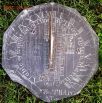 unusual ten sided, horizontal
slate dial currently in a private collection in Tipperary. unusual ten sided, horizontal
slate dial currently in a private collection in Tipperary.
It
has a simply perforated but sadly now rather corroded iron gnomon with
a noon gap on the plate to compensate for the gnomon thickness and
it measures 285mm across flats with one corner broken off and
missing, rendering the inscription at this part of the dial
un-decipherible. The ....T 52 could be LAT 52 which is the
lattitude for the N.Cork/S.Tipperary area
The Chapter Ring
originally showed the time from 4a.m. to 8p.m. in Roman Numerals
using IV for four. The fractional time rings outside the Chapter
Ring have 5,15 and 30 minute divisions.
Inside the Chapter Ring
is inscribed A table of Equation of Time by Tho's Quinn March 10th
1840. The centre of the dial is occupied by an Equation of Time
table with the dates for zero value marked with a small sun
symbol. Click on the image for
a larger version.
09.05.2022 |
Dom Ethelbert Horne
(1858-1952) was born in Surrey and educated at
 Reading
School. He converted to Catholicism in 1879 and was 'clothed' the
following year. Parish priest of Stratton-on-the-Fosse from 1891
to 1940, Horne was Custodian of the Relics at Downside and Prior
from 1929 to 1933. A noted archaeologist, antiquary and
folklorist, he was made an FSA in 1924 and published works on
subjects as diverse as holy wells, mistletoe and scratch dials.
For twelve years he was one of the Directors of Excavations at
Glastonbury Abbey. Later Horne was honoured with the titular
titles Cathedral Prior of Norwich in 1933 and then Abbot of
Glastonbury in 1939. Here from the image or from that below we
link to the famous text of his major work:
Primitive Sun Dials or Scratch Dials Containing a List of Those in
Somerset Reading
School. He converted to Catholicism in 1879 and was 'clothed' the
following year. Parish priest of Stratton-on-the-Fosse from 1891
to 1940, Horne was Custodian of the Relics at Downside and Prior
from 1929 to 1933. A noted archaeologist, antiquary and
folklorist, he was made an FSA in 1924 and published works on
subjects as diverse as holy wells, mistletoe and scratch dials.
For twelve years he was one of the Directors of Excavations at
Glastonbury Abbey. Later Horne was honoured with the titular
titles Cathedral Prior of Norwich in 1933 and then Abbot of
Glastonbury in 1939. Here from the image or from that below we
link to the famous text of his major work:
Primitive Sun Dials or Scratch Dials Containing a List of Those in
Somerset
22.04.22 |
|
Chevening's Great Decliner
Chevening House is a large country house in Kent.

 Built
between 1617 and 1630 to a design reputedly by Inigo Jones and
greatly extended after 171. It is a Grade I listed building.
Formerly the principal seat of the Earls Stanhope for 250 years,
the house and estate are owned and maintained at the expense of
the trust of the Chevening Estate, to serve as a furnished country
residence for a person nominated by the prime minister, so
qualified by being a member of the Cabinet or a descendant of King
George VI. Built
between 1617 and 1630 to a design reputedly by Inigo Jones and
greatly extended after 171. It is a Grade I listed building.
Formerly the principal seat of the Earls Stanhope for 250 years,
the house and estate are owned and maintained at the expense of
the trust of the Chevening Estate, to serve as a furnished country
residence for a person nominated by the prime minister, so
qualified by being a member of the Cabinet or a descendant of King
George VI.
Chevening House is not an official residence, but
has been traditionally used by the Foreign Secretary of the day.
It was once considered by Prince Charles before he purchased
Highgrove. The dial is a modern great decliner set at roof level
in one of the supporting buildings to the main house. Click on the
image or HERE for a
close up of this modern dial. It is a West declining dial,
declining 60degs West. Click HERE to see a calculated version of this well designed dial.
20.06.2022 Image
© Copyright M Thomson |
The Dial at Brumby Hall
Brumby Hall is a late 17th-century residence and a
Grade
II Listed building in Scunthorpe, North Lincolnshire. A sundial
dated to
 1637 is present onsite though its siting is perhaps not
its original one. The Hall was extended in the late 18th
century by George Pycock for Thomas Pindar, and further altered
and extended in the 19th and 20th centuries. In the early 17th
century, the Hall was home to Richard Bellingham (later Governor
of the Massachusetts Bay Colony), and latterly to Nathaniel
Fiennes. Click the thumnail image or
HERE or
HERE to see a
somewhat larger image. 1637 is present onsite though its siting is perhaps not
its original one. The Hall was extended in the late 18th
century by George Pycock for Thomas Pindar, and further altered
and extended in the 19th and 20th centuries. In the early 17th
century, the Hall was home to Richard Bellingham (later Governor
of the Massachusetts Bay Colony), and latterly to Nathaniel
Fiennes. Click the thumnail image or
HERE or
HERE to see a
somewhat larger image.
17.06.22 |
Christopher StJ H Daniel MBE
SunInfo was sad in mid May 2022 to have
to
 report the death of the
second BSS
President Christopher Daniel MBE. Christopher took over as
Chairman of the Society upon the untimely death of its first
Chairman, Dr Andrew Somerville and later, on his retirement from
that post, Christopher was appointed the President of the Society.
Arguably Christopher was the most prolific designer
ever of
sundials in the UK and certainly he is the UK diallist with the
most publications to his name. His funeral took place
at 2pm on Friday 17th June 2022 Read our obituary to a
most
remarkable man, Master Mariner and Sundiallist. He will
certainly be much missed. report the death of the
second BSS
President Christopher Daniel MBE. Christopher took over as
Chairman of the Society upon the untimely death of its first
Chairman, Dr Andrew Somerville and later, on his retirement from
that post, Christopher was appointed the President of the Society.
Arguably Christopher was the most prolific designer
ever of
sundials in the UK and certainly he is the UK diallist with the
most publications to his name. His funeral took place
at 2pm on Friday 17th June 2022 Read our obituary to a
most
remarkable man, Master Mariner and Sundiallist. He will
certainly be much missed.
Click the thumbnail image or
HERE to read Christopher's
Obituary. Click
HERE to read his own interesting summary of his life and
times.
21.05.2022
Image © Copyright CStJH Daniel MBE |
The Interesting Dial at RHS Rosemoor
Here's an interesting dial in the
 Shrub
Rose Garden at RHS Rosemoor. It is a tall triangular section pillar made
from Cornish slate and is 1820mm high. The slate comes from the
Delabole Slate Quarry which is thought to be the oldest working
slate quarry in the world. The dial shows British Summer Time,
that is solar time adlusted for the equation of time and for longitude.
Two of the faces contain pairs of declining dials one above the
other. The upper ones are drawn for December to June and the lower
ones for June to December. A motto is included around the circular
base which reads ‘But only in time can the moment in the rose-garden be
remembered’ (after T.S.Eliot). The dial was designed by the
Patron of BSS, Sir Mark Lennox-Boyd and made by Ben Jones. The third
face shows the dial's dedications. Click the image for a larger
version. Shrub
Rose Garden at RHS Rosemoor. It is a tall triangular section pillar made
from Cornish slate and is 1820mm high. The slate comes from the
Delabole Slate Quarry which is thought to be the oldest working
slate quarry in the world. The dial shows British Summer Time,
that is solar time adlusted for the equation of time and for longitude.
Two of the faces contain pairs of declining dials one above the
other. The upper ones are drawn for December to June and the lower
ones for June to December. A motto is included around the circular
base which reads ‘But only in time can the moment in the rose-garden be
remembered’ (after T.S.Eliot). The dial was designed by the
Patron of BSS, Sir Mark Lennox-Boyd and made by Ben Jones. The third
face shows the dial's dedications. Click the image for a larger
version.
06.06.2022 Images © M & V Thomson, 2022 |
The Puzzle of the Luxmoore Dial
Eton housemaster HE Luxmoore, created a
 lovely
garden on Tangier island in the Thames just beside the School Chapel.
Oddly its location is not on Google Maps or Earth. It's usually accessible only to
Masters and senior boys and as a
consequence it retains its mystery and seclusion. Fortunately for
mere mortals who are interested in gardens it is sometimes open
under the UK National Garden Scheme. lovely
garden on Tangier island in the Thames just beside the School Chapel.
Oddly its location is not on Google Maps or Earth. It's usually accessible only to
Masters and senior boys and as a
consequence it retains its mystery and seclusion. Fortunately for
mere mortals who are interested in gardens it is sometimes open
under the UK National Garden Scheme.
Luxmoore himself was
an Eton King's Scholar from 1852 to 1859, he then went on to
King's College Cambridge and returned to Eton in 1864 as an
assistant master. He was hugely influential, and he took a
particular interest in Eton's ancient buildings. The magnificent
garden he created after his retirement in 1908 was, after his
death, taken over by the College.
The garden contains a
lovely golden armillary sphere but visitors report that it does
not tell solar time. Indeed no shadow appears on the timescale.
Based only on photographs 'today's hypothesis' is that the dial
has been set up wholly out of alignment with the earth's axis -
surely Eton would not have missed that? What do you think?
Click the image or HERE
to see how the dial sits in the sunlight. Comments to the
webmaster
please,
02.06.2022 Images © M & V Thomson, 2022 |
Woolfardisworthy Worries!
Some years ago the Registrar of the National
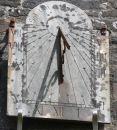 Database
of UK Fixed Sundials received a succession of notifications
concerning a dial in Devon. Database
of UK Fixed Sundials received a succession of notifications
concerning a dial in Devon.
These were alternately
saying that there was a dial and then that it had been lost.
Whatever was the problem?
Read
HERE (or click on the image)
to read about the struggle to properly record a lovely church
slate sundial.
30.05.2022 Images © M & V Thomson, 2022 |
The Housewives'
Trick (again)
Way back in 2017 (click HERE to see our entry)
 we
showed the sundial that is adjacent to the Orangery Greenhouse at
the NT property of Peckover House in Wisbech. The dial was, as
now, substantially misaligned, rather suggesting the possibility
that it had been turned to show summer or some other time.
This is not an uncommon practice and because of that it is
sometimes referred to as the Housewives' Trick. Today - as may be
seen by clicking on the image here - the dial is some 21 degrees
out of its correct true North alignment. In 2008 Simon
Wheaton-Smith published an interesting article on this phenomenon
entitled
'The Old Housewife's Trick' which is worth a read because
it shows how the validity of this so-called 'trick' varies with
latitude. The UK is (just!) inside the 'valid' latitudes. A
close-up of the dial as it is today may be seen
HERE. we
showed the sundial that is adjacent to the Orangery Greenhouse at
the NT property of Peckover House in Wisbech. The dial was, as
now, substantially misaligned, rather suggesting the possibility
that it had been turned to show summer or some other time.
This is not an uncommon practice and because of that it is
sometimes referred to as the Housewives' Trick. Today - as may be
seen by clicking on the image here - the dial is some 21 degrees
out of its correct true North alignment. In 2008 Simon
Wheaton-Smith published an interesting article on this phenomenon
entitled
'The Old Housewife's Trick' which is worth a read because
it shows how the validity of this so-called 'trick' varies with
latitude. The UK is (just!) inside the 'valid' latitudes. A
close-up of the dial as it is today may be seen
HERE.
11.03.22 Photo
© Copyright
VL Thomson |
Modern 3d Printed Dial at Berkeley Castle
Retired engineer Bob Hunt
 worked
with staff at Renishaw Group to create a new castle-themed sundial
for the Castle grounds. Designed 2016, installed 2017. worked
with staff at Renishaw Group to create a new castle-themed sundial
for the Castle grounds. Designed 2016, installed 2017.
It
was designed and commissioned by the Friends of Berkeley Castle
and was constructed as a metal 3D printed sundial by Renishaw
Group in 2016.
Bob Hunt, a retired mechanical engineer and
member of the Friends of Berkeley Castle, designed the dial.
Castle features figure in the design and they influenced the
finished result. See how many you can spot.
Printed from
stainless steel powder in an AM250 metal 3D printer, the sundial
was then mounted to a pedestal for display at the castle. Click on
the image or HERE
for a larger image
10.08.2022 Creative Commons licence
Renishaw attribution 4.0. 2017 |
Giant Analemmatic Dial in Leicestershire
Graeme Mitcheson's Giant Stone
 Sundial
has finally been installed in its location in a field on a
Woodland Trust owned site in North West Leicestershire. The stone
circle consists of 20 carved sandstone elements depicting, not
only an hour, but also a plant/flower belonging to a country and
also the distance to that country from where you are standing. The
stone sundial requires a person to stand on the central date scale
on a sunny day. The outside stones weigh approximately 300kgs each
and are roughly 800 x 600 x 300mm. They are carved in a variety of
sandstones including Peak Moor, Cove and St. Bees. Click on the
image (or
HERE) to see one view of the dial. Sundial
has finally been installed in its location in a field on a
Woodland Trust owned site in North West Leicestershire. The stone
circle consists of 20 carved sandstone elements depicting, not
only an hour, but also a plant/flower belonging to a country and
also the distance to that country from where you are standing. The
stone sundial requires a person to stand on the central date scale
on a sunny day. The outside stones weigh approximately 300kgs each
and are roughly 800 x 600 x 300mm. They are carved in a variety of
sandstones including Peak Moor, Cove and St. Bees. Click on the
image (or
HERE) to see one view of the dial.
07.08.2022
|
In a Garden in the SE of the UK!
An interesting early Dial by Pilkington and Gibbs seen here in a
private
 garden
in the SE of the UK. Nicely and accurately set up and aligned.
These dials date from the early 20thC (Gibbs' Patent dates to
1907) and they permit precise measurment of mean time if set up
carefully. The correction for the equation of time is effected via
a built in cam and the equatorial setting allows compensation for
longitude. About 1000 were made, many being still in use
today. The time is read after adjustment each time by the user to
ensure that the image of the sun falls on a defined line.
Click on the thumbnail image or
HERE to see two images of this dial. garden
in the SE of the UK. Nicely and accurately set up and aligned.
These dials date from the early 20thC (Gibbs' Patent dates to
1907) and they permit precise measurment of mean time if set up
carefully. The correction for the equation of time is effected via
a built in cam and the equatorial setting allows compensation for
longitude. About 1000 were made, many being still in use
today. The time is read after adjustment each time by the user to
ensure that the image of the sun falls on a defined line.
Click on the thumbnail image or
HERE to see two images of this dial.
02.08.2022 |
The Numberless Dial of Warwick Castle
The dial at Warwick Castle is
 recorded
as SRN 020 in the National Register. It is a vertical West
declining dial set on the inside of the entrance tower of the
Castle. In 2012, one of the wettest summers in more than 100 years
rain forced a repainting for the first time in 60 years. recorded
as SRN 020 in the National Register. It is a vertical West
declining dial set on the inside of the entrance tower of the
Castle. In 2012, one of the wettest summers in more than 100 years
rain forced a repainting for the first time in 60 years.
The
incessant rainfall had caused significant wear and tear on the
historic feature that was originally set up in the 1700s. No
droughts then.
A spokesman said at the time “Perhaps
renewing our dial will encourage the sun to come out a little more
so our customers can enjoy the rest of the summer at Warwick
Castle.” Well, we had some good weather in 2022 so maybe it did -
though not today! See our earlier entry on this dial
here
and how it looks today
here.
30.07.22 Image
© Copyright VL Thomson |
The Dial at Inverewe Garden
Using a hole gnomon (in a plate parallel to the dialplate to ensure
circularity of the image) this interesting dial shows
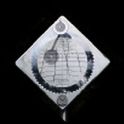 length-of-day
curves, solstice and equinox lines, and a noon analemma. Hour
lines show both GMT and BST. The English motto is Follow thy
fair sun’. length-of-day
curves, solstice and equinox lines, and a noon analemma. Hour
lines show both GMT and BST. The English motto is Follow thy
fair sun’.
A fascinatig modern sundial that is
well worth a visit. You can read more about it
HERE or by clicking on the thumbnail here.
13.07.2022 |
The Old and the New in Keswick Hope Park
For many years the original
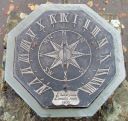 sundial
in Hope Park, Keswick was without its gnomon. Despite its sad
state, the 1805 dialplate had a certain elegance. A larger
image of the old dial may be seen by clicking on the image of it here. sundial
in Hope Park, Keswick was without its gnomon. Despite its sad
state, the 1805 dialplate had a certain elegance. A larger
image of the old dial may be seen by clicking on the image of it here.
In 2017 however, all things changed and a replacement dial
was commissioned after local resident Leonard Will
offered his time and money to acquire a new modern sundial from
Robert Foster Sundials, of Telford. See and even read about the
NEW sundial
Here.
06.07.2022 |
Another Look at the Weston Park Dial
Way back in 2017 we reported on
 the discovery
and restoration of the lost Coade stone pedestal at Weston Park
Shropshire. In 2017, Martin Gee, Weston Park's Head Gardener and
his team found an eighteenth century sundial pedestal amongst shoulder
high nettles. It proved to be an original - though damaged - Coade
stone pedestal. the discovery
and restoration of the lost Coade stone pedestal at Weston Park
Shropshire. In 2017, Martin Gee, Weston Park's Head Gardener and
his team found an eighteenth century sundial pedestal amongst shoulder
high nettles. It proved to be an original - though damaged - Coade
stone pedestal.
With the success of the subsequent
fundraising campaign, the plinth was sent for restoration to Phil
Thomasson, a Dorset-based conservator. To accompany the plinth a
new sundial was crafted to replace the missing original, by Robert
Foster from Jackfield. Our earlier announcement may be found in
our Archive2 files (search that page for 'Weston') but a recent
visitor has kindly sent SunInfo three excellent new
images. Enjoy them HERE
or by clicking on the thumbnail here.
05.07.2022
image © Copyright J Carragher |
The Buncrana Dial in Donegal.
In May 2014, the town council of Buncrana in County Donegal,
 Ireland,
decided to build a new sundial on the shorefront green of Lough
Swilly. Ireland,
decided to build a new sundial on the shorefront green of Lough
Swilly.
Piers Nicholson and Harriet James were asked to
design and delineate it. The sundial was constructed locally by Mr
George O’Hagan .It is three metres high in stainless steel.
This sundial is on a lovely site with Lough Swilly in the
background. Click on the thumbnail image for a better view.
04.07.2022
image
© Copyright, permission and information Michael J Harvey |
An Interesting Baluster Pedestal
Port Lympne, at Lympne, Kent is an early
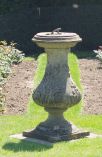 20th-century
country house built for Sir Philip Sassoon in the Cape Dutch
architecture style. It was completed after the First World War.
Originally named Belcaire, it was renamed Port Lympne after WW1,
echoing Portus Lemanis, a Roman port that was situated
nearby. Following Sassoon's death in 1939 it was bequeathed with
its contents to Hannah Gubbay, his cousin. It was abandoned after
WW2 after its appalling misuse by the military. In 1973, it was
purchased by John Aspinall as part of an expansion of his Port
Lympne Zoo. The house is a Grade II* listed building as of 29
December 1966. The dial in the sundial garden is a badly damaged
garden centre 'non-dial' of no interest whatsoever but the pedestal
is well worth a look. 20th-century
country house built for Sir Philip Sassoon in the Cape Dutch
architecture style. It was completed after the First World War.
Originally named Belcaire, it was renamed Port Lympne after WW1,
echoing Portus Lemanis, a Roman port that was situated
nearby. Following Sassoon's death in 1939 it was bequeathed with
its contents to Hannah Gubbay, his cousin. It was abandoned after
WW2 after its appalling misuse by the military. In 1973, it was
purchased by John Aspinall as part of an expansion of his Port
Lympne Zoo. The house is a Grade II* listed building as of 29
December 1966. The dial in the sundial garden is a badly damaged
garden centre 'non-dial' of no interest whatsoever but the pedestal
is well worth a look.
Click on the image or
HERE for a larger
version.
02.07.2022 Image
© Copyright M Thomson |
The Goodnestone Church Dial
At the end of one of the grassed garden paths
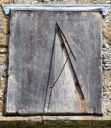 in
Goodnestone Park Gardens near Dover stands the Church of the Holy
Cross, Goodnestone. The tower includes both a sundial and a
clockface with the dial facing the gardens and the clock oddly
facing back over the Church Nave. The slate dial declines
some 23 degrees West delineated to show time from 6:15am to
6:15pm solar time in quarters. The Motto across the top is hard to
read but is thought to be 'Every Hour Shortens Life'. in
Goodnestone Park Gardens near Dover stands the Church of the Holy
Cross, Goodnestone. The tower includes both a sundial and a
clockface with the dial facing the gardens and the clock oddly
facing back over the Church Nave. The slate dial declines
some 23 degrees West delineated to show time from 6:15am to
6:15pm solar time in quarters. The Motto across the top is hard to
read but is thought to be 'Every Hour Shortens Life'.
Click on the image or
HERE to see a
larger image.
28.06.2022 Image
© Copyright M Thomson |
The Blickling "Non-Dial"
Blickling Hall has suffered several times from theft of
 its
dials. Way back in 2014, thieves attacked Blickling Hall's secret
garden and made off both with the sundial
and the Portland stone pedestal
there. The bronze sundial, itself a replacement for an
earlier stolen dial that dated from the late 18th or early 19th
century, had been made by “Brookbrae Ltd, London” - a quality
modern supplier . That theft is mentioned in our Stolen Dials
section on the right of this page. However, visitors today may
see from an NT map of the estate that there is marked on it the
location of another supposed 'sundial'in the Eastern part of the
Blickling Estate, quite some way from the House and those who may
finally get there will be disappointed to see that it is in fact
only a wooden post in the ground with several spaced trees in the
distance, possibly intended as hour markers. A non-dial if ever
there was one - hardly worth visiting. Click on the thumbnail here
or HERE
to see more of this. its
dials. Way back in 2014, thieves attacked Blickling Hall's secret
garden and made off both with the sundial
and the Portland stone pedestal
there. The bronze sundial, itself a replacement for an
earlier stolen dial that dated from the late 18th or early 19th
century, had been made by “Brookbrae Ltd, London” - a quality
modern supplier . That theft is mentioned in our Stolen Dials
section on the right of this page. However, visitors today may
see from an NT map of the estate that there is marked on it the
location of another supposed 'sundial'in the Eastern part of the
Blickling Estate, quite some way from the House and those who may
finally get there will be disappointed to see that it is in fact
only a wooden post in the ground with several spaced trees in the
distance, possibly intended as hour markers. A non-dial if ever
there was one - hardly worth visiting. Click on the thumbnail here
or HERE
to see more of this.
26.7.2022
image Courtesy and © Copyright Dr M Thomson |
 The
Sunshade that doesn't
!!
Los Angeles (USA) has The
Sunshade that doesn't
!!
Los Angeles (USA) has
 introduced
its NEW "Gender Equity Sunshade". You might
well be thinking 'What?'. Wags were quick to note that the thin,
perforated "La Sombrita" structure would do little to keep a single
person that would be able to stand underneath it out of the sun. Its
minimal benefits in terms of light and shade are outweighed by both
the pilot's costs of at least $7,500 per shelter and $200,000 for
the full program. In some streets it has even been placed so as to
shade a person only when the sun is in the North!. Read all about it
by clicking on the image here or
HERE. Is this the way the world is going? introduced
its NEW "Gender Equity Sunshade". You might
well be thinking 'What?'. Wags were quick to note that the thin,
perforated "La Sombrita" structure would do little to keep a single
person that would be able to stand underneath it out of the sun. Its
minimal benefits in terms of light and shade are outweighed by both
the pilot's costs of at least $7,500 per shelter and $200,000 for
the full program. In some streets it has even been placed so as to
shade a person only when the sun is in the North!. Read all about it
by clicking on the image here or
HERE. Is this the way the world is going?
23.05.2023 |
 BSS Accounts for
2020
The BSS accounts for the BSS Accounts for
2020
The BSS accounts for the
 financial
year 2020 showed a further annual loss of assets of £7,146 and
this despite a welcome legacy/donation of £2,538 making the
effective operating loss some £9,684 on the year. The Charity
Commission's own graph of the BSS economic history is
HERE. At the end of 2020
there were 288 members - 209 in the UK, 39 in the rest of Europe, 29
in the USA and 11 in the rest of the world. financial
year 2020 showed a further annual loss of assets of £7,146 and
this despite a welcome legacy/donation of £2,538 making the
effective operating loss some £9,684 on the year. The Charity
Commission's own graph of the BSS economic history is
HERE. At the end of 2020
there were 288 members - 209 in the UK, 39 in the rest of Europe, 29
in the USA and 11 in the rest of the world.
Updated 27.05.2022, 13.08.2022 |
 The Solar Eclipse of
10th June 2021
There was a The Solar Eclipse of
10th June 2021
There was a
 solar
eclipse on the 10th June 2021 which was only seen as a
very partial eclipse in Hertfordshire UK. See this lucky
shot taken directly using an iPhone 12 and using the phone up
against the eyes for protection with the shot taken as the
unbelievably cloudy sky lightened. solar
eclipse on the 10th June 2021 which was only seen as a
very partial eclipse in Hertfordshire UK. See this lucky
shot taken directly using an iPhone 12 and using the phone up
against the eyes for protection with the shot taken as the
unbelievably cloudy sky lightened.
Click the image or
HERE
to see a larger version.
19.10.21 |
The Rousham Sundial
again!
We last visited this dial in 2018 but it is always
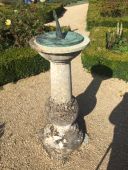 worth
another visit. This time with some close ups of the
dialplate and with the information (from the owner no less) that
it is currently quite badly misaligned after some boisterous
children had knocked it over a few years ago and, in the process
of properly securing it, it has simply been fixed upright again.
We have been told it will be looked at when time permits. worth
another visit. This time with some close ups of the
dialplate and with the information (from the owner no less) that
it is currently quite badly misaligned after some boisterous
children had knocked it over a few years ago and, in the process
of properly securing it, it has simply been fixed upright again.
We have been told it will be looked at when time permits.
Click on the image for more information about
this lovely dial by Dolland which despite a little wear can still
be read in all respects. Its many scales make this a true
scientific instrument set in the lovely gardens of Rousham -
particularly with its marvellous dahlia display this autumn.
09.10.20.
|
 The Sundials
of St Margaret's Church Westminster The Sundials
of St Margaret's Church Westminster
 St
Margaret's Church Westminster is located adjacent to Westminster
Abbey in London. For years it displayed an 18th Century clock on
its North face However, this failed and it was removed from the
tower in the 1970s. Sometime later Christopher Daniel MBE was
commissioned to install four giant sundials one on each face of
the square tower with the North facing dial taking the place of
the original clock. The sundials were the gift of Sir Geoffrey de
Freitas. A plaque in the North porch of the church records the
gift. Go to our special
page about St Margaret's Church sundials to see
more.. St
Margaret's Church Westminster is located adjacent to Westminster
Abbey in London. For years it displayed an 18th Century clock on
its North face However, this failed and it was removed from the
tower in the 1970s. Sometime later Christopher Daniel MBE was
commissioned to install four giant sundials one on each face of
the square tower with the North facing dial taking the place of
the original clock. The sundials were the gift of Sir Geoffrey de
Freitas. A plaque in the North porch of the church records the
gift. Go to our special
page about St Margaret's Church sundials to see
more..
08.01.22 |
Blickling's Analemmatic Dial
In the grounds of Blickling House in Norfolk can
 be
seen a modern analemmatic sundial set in one of the gravel paths.
At first glance it can be missed since the colour of the inset
stones nearly matches the gravel of the path. However it is
worth a closer look and the visitor should stand with their heels
at today's date on the date scale. The shadow thus cast will
then intersect the elliptical time scale at roughly the current
solar summer time. An adjacent table shows the necessary
correction to be made to compare the reading with today's mean
clock time. Click on the image or
HERE for four
images of the key dial details. These can be magnified by clicking
on the image. The dial was constructed in 2000 and is recorded in
the National Register as SRN 5839. The designer of the dial is not known
to SunInfo. be
seen a modern analemmatic sundial set in one of the gravel paths.
At first glance it can be missed since the colour of the inset
stones nearly matches the gravel of the path. However it is
worth a closer look and the visitor should stand with their heels
at today's date on the date scale. The shadow thus cast will
then intersect the elliptical time scale at roughly the current
solar summer time. An adjacent table shows the necessary
correction to be made to compare the reading with today's mean
clock time. Click on the image or
HERE for four
images of the key dial details. These can be magnified by clicking
on the image. The dial was constructed in 2000 and is recorded in
the National Register as SRN 5839. The designer of the dial is not known
to SunInfo.
22.07.2022 |
 Athens
is an octagonal Pentelic marble clocktower and early timepiece situated in
the Roman Agora. It still features a combination of sundials, a water
clock, and it probably held a weather vane too. Thought by some to have
been built by Andronicus of Cyrrhus around 50 BC but possibly by another
even as early as the 2nd century BC, the Athens Ephorate of Antiquities began
cleaning and conserving the structure in 2014 and this has just been
completed! The North American Sundial Society NASS has an excellent
article about this fascinating building. Read it
Here
Athens
is an octagonal Pentelic marble clocktower and early timepiece situated in
the Roman Agora. It still features a combination of sundials, a water
clock, and it probably held a weather vane too. Thought by some to have
been built by Andronicus of Cyrrhus around 50 BC but possibly by another
even as early as the 2nd century BC, the Athens Ephorate of Antiquities began
cleaning and conserving the structure in 2014 and this has just been
completed! The North American Sundial Society NASS has an excellent
article about this fascinating building. Read it
Here
 intriguing
question. In April 2009 a fragment of a sundial was displayed at the
Pointe-à-Callière museum in Montreal. Thought to date from the late
17thC and with a delineation that despite displaying lines above the horizon
shows it might have adorned a wall on a building on the estate of Montreal's
fifth appointed (rather than acting!) governor Louis-Hector de Callière, it
may even be the first sundial to be made in Montreal.
intriguing
question. In April 2009 a fragment of a sundial was displayed at the
Pointe-à-Callière museum in Montreal. Thought to date from the late
17thC and with a delineation that despite displaying lines above the horizon
shows it might have adorned a wall on a building on the estate of Montreal's
fifth appointed (rather than acting!) governor Louis-Hector de Callière, it
may even be the first sundial to be made in Montreal.


 civilian
pilot for BOAC and then British Airways and a long time horologist and
sundial enthusiast, died peacefully in North Woodchester on 25th January
2015, aged 94 years with son Christopher, daughter Elaine and his
beloved Vera by his side. Michael was the son of the late Rev Arthur
Frank Maltin, former vicar of Stroud and of Amberley, the much loved
husband of the late Christine Maltin and a cherished father, grandfather
and great-grandfather. A lovely, unassuming man and Spitfire
fanatic who will be much missed by those who had the privilege to know
him. Read
civilian
pilot for BOAC and then British Airways and a long time horologist and
sundial enthusiast, died peacefully in North Woodchester on 25th January
2015, aged 94 years with son Christopher, daughter Elaine and his
beloved Vera by his side. Michael was the son of the late Rev Arthur
Frank Maltin, former vicar of Stroud and of Amberley, the much loved
husband of the late Christine Maltin and a cherished father, grandfather
and great-grandfather. A lovely, unassuming man and Spitfire
fanatic who will be much missed by those who had the privilege to know
him. Read


 Courtesy
(and copyright) of Google Inc who on the day placed this excellent
Doodle on their website, we too would like to mark the life and more
importantly the determination of self-taught John Harrison, winner of
the 1714 Longitude Prize which had been put up to prevent naval
disasters. The Board of Longitude offered a reward of £20,000 to anyone
who could devise a navigational instrument that could be used to
determine a ship's longitude to within 30 miles even after a long sea
voyage.
Courtesy
(and copyright) of Google Inc who on the day placed this excellent
Doodle on their website, we too would like to mark the life and more
importantly the determination of self-taught John Harrison, winner of
the 1714 Longitude Prize which had been put up to prevent naval
disasters. The Board of Longitude offered a reward of £20,000 to anyone
who could devise a navigational instrument that could be used to
determine a ship's longitude to within 30 miles even after a long sea
voyage.
 Cumbria
on the shore of the Esk Estuary. Installed in 1830 in memory of the
Rev J Stanley, it is mounted on a pedestal five or so feet high, placed
there for horse riders!
Cumbria
on the shore of the Esk Estuary. Installed in 1830 in memory of the
Rev J Stanley, it is mounted on a pedestal five or so feet high, placed
there for horse riders!




 on
the construction of an Hemispherium.
on
the construction of an Hemispherium. 

 portable
sundial in the shape of an Italian ham has been copied and a 3D replica
generated in order to test its design. The dial is hung from a
string so that the sun falls on its left side, allowing the attached
'pig’s tail' gnomon to cast a shadow across the grid.
portable
sundial in the shape of an Italian ham has been copied and a 3D replica
generated in order to test its design. The dial is hung from a
string so that the sun falls on its left side, allowing the attached
'pig’s tail' gnomon to cast a shadow across the grid.





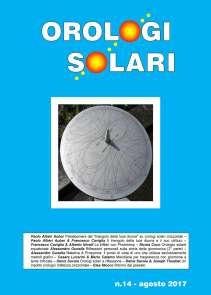




 attempts
to mark solar midday by an acoustic signal, as happened with the noon
cannons of the early 1600s - though using rather more modern
technology.
attempts
to mark solar midday by an acoustic signal, as happened with the noon
cannons of the early 1600s - though using rather more modern
technology. 













 doubt
that the very earliest civilisations made use of the shadows of objects
to gauge the time of the day and the season of the year. In 2008
Christopher Daniel published a page in Clocks Magazine about the Arabic
Origins of the Scientific Sundial.
doubt
that the very earliest civilisations made use of the shadows of objects
to gauge the time of the day and the season of the year. In 2008
Christopher Daniel published a page in Clocks Magazine about the Arabic
Origins of the Scientific Sundial. 




 27th
March 2019. Gianni's definitive contributions to dialling discussions raised
over many years on the Sundial Mail List have contributed much to the
education of diallists everywhere and have delighted them in equal measure. His
book about Islamic sundials has been acclaimed by many as a masterpiece but it
will surely serve as only one aspect of his amazing dialling legacy.
27th
March 2019. Gianni's definitive contributions to dialling discussions raised
over many years on the Sundial Mail List have contributed much to the
education of diallists everywhere and have delighted them in equal measure. His
book about Islamic sundials has been acclaimed by many as a masterpiece but it
will surely serve as only one aspect of his amazing dialling legacy. 




 Ridd
had his employment terminated as a professor of physics at James Cook University
in Townsville, Australia. Peter had spoken out against the accepted
orthodoxy that climate change was ‘killing’ the Great Barrier Reef. He was able
to crowd fund his chance to prosecute the University by raising $AUS 250,000 in
five days! Peter writes: "My lawyers have told me that the judge handed
down his decision and we seem to have won on all counts".
Ridd
had his employment terminated as a professor of physics at James Cook University
in Townsville, Australia. Peter had spoken out against the accepted
orthodoxy that climate change was ‘killing’ the Great Barrier Reef. He was able
to crowd fund his chance to prosecute the University by raising $AUS 250,000 in
five days! Peter writes: "My lawyers have told me that the judge handed
down his decision and we seem to have won on all counts". 




 In
2016 the BBC broadcast a programme describing how Britain introduced Summertime
(daylight saving time) 100+ years ago – a move that was quickly followed by
countries worldwide.
In
2016 the BBC broadcast a programme describing how Britain introduced Summertime
(daylight saving time) 100+ years ago – a move that was quickly followed by
countries worldwide.


 USA
dedicated a new sundial built by artist James Kitchen and commissioned by the
Edward Peck family in memory of Ruth Mahoney Peck who shared a great love for
the park. The dial is fabricated in steel using a skate blade as the
gnomon and a saw blade as a base. It was declared 'open' on June 21 2018.
USA
dedicated a new sundial built by artist James Kitchen and commissioned by the
Edward Peck family in memory of Ruth Mahoney Peck who shared a great love for
the park. The dial is fabricated in steel using a skate blade as the
gnomon and a saw blade as a base. It was declared 'open' on June 21 2018.


 today
it has a new look with new software, renewed graphics, a new faster server and
several new features.
today
it has a new look with new software, renewed graphics, a new faster server and
several new features. 




 strangely
placed sundial in the grounds of Buckingham Palace.. The dial, once placed
in a suitable place now rests in the shade of nearby trees.
strangely
placed sundial in the grounds of Buckingham Palace.. The dial, once placed
in a suitable place now rests in the shade of nearby trees.
 in
Uithuizen, Holland 53.4°N, 6.7°E. Information sent to
the Sundial Mail List courtesy of Frans Maes tells us that it is an elaborate
multiple dial, dating from 1722. The base is formed from two stacked
cubes, one rotated by 45° compared to the other. Each side of the cubes
has a vertical dial, though the gnomon of one has been wrongly aligned..
in
Uithuizen, Holland 53.4°N, 6.7°E. Information sent to
the Sundial Mail List courtesy of Frans Maes tells us that it is an elaborate
multiple dial, dating from 1722. The base is formed from two stacked
cubes, one rotated by 45° compared to the other. Each side of the cubes
has a vertical dial, though the gnomon of one has been wrongly aligned.. 

 from
SunInfo but they can be a useful reminder for a number of
interesting Sundial matters. New EU regulations mean that unless you have
explicitly given us permission to receive mailings from us, future newsletters
will not be sent to you. By sending us an email to
from
SunInfo but they can be a useful reminder for a number of
interesting Sundial matters. New EU regulations mean that unless you have
explicitly given us permission to receive mailings from us, future newsletters
will not be sent to you. By sending us an email to 


 It
was ten years ago in 2005 that the mystery of the holes that are pierced
in the remains of the vertical dial on Beccles Church in Suffolk was
unravelled. The BSS Registrar at that time was Patrick Powers and in an
earlier article in the BSS Bulletin he had posed the question. Quick as a
flash, two eminent BSS diallists explained it all. A second article in the
BSS Bulletin was clearly necessary!
It
was ten years ago in 2005 that the mystery of the holes that are pierced
in the remains of the vertical dial on Beccles Church in Suffolk was
unravelled. The BSS Registrar at that time was Patrick Powers and in an
earlier article in the BSS Bulletin he had posed the question. Quick as a
flash, two eminent BSS diallists explained it all. A second article in the
BSS Bulletin was clearly necessary! 
 recently
been issued to Members. The key contents are:
recently
been issued to Members. The key contents are:













 the
Henry Wynne sundial. Displaying a 32pt compass, the times of noon at twelve
cities and all set in a 'secured' dial plate of some 425mm diam which is mounted
on an octagonal plinth. The cities are marked as Mexico, Charlestown, New York,
Barbados, Tenerife, Dublin, Paris, Rome, Jerusalem, Babylon, Surrat and Bantom.
The dial shows 4am to 8pm with its numerals read from 'inside' the dial.
the
Henry Wynne sundial. Displaying a 32pt compass, the times of noon at twelve
cities and all set in a 'secured' dial plate of some 425mm diam which is mounted
on an octagonal plinth. The cities are marked as Mexico, Charlestown, New York,
Barbados, Tenerife, Dublin, Paris, Rome, Jerusalem, Babylon, Surrat and Bantom.
The dial shows 4am to 8pm with its numerals read from 'inside' the dial. 




 alerted the sundial community to the
'event' that occurs at (and near) the summer solstice in Florence's Duomo in
Italy. There is an aperture high up in the dome of the Cathedral which,
around the summer solstice lets a spot of light fall to the floor and pass over
a meridian line that was installed in 1756 - though the aperture might have been
installed as early as 1475!. It was designed partly so that "the measure
of the year and the date of Easter be more accurately determined", according to
the inscription still visible on the wall near the choir. If you cannot be
there, look at
alerted the sundial community to the
'event' that occurs at (and near) the summer solstice in Florence's Duomo in
Italy. There is an aperture high up in the dome of the Cathedral which,
around the summer solstice lets a spot of light fall to the floor and pass over
a meridian line that was installed in 1756 - though the aperture might have been
installed as early as 1475!. It was designed partly so that "the measure
of the year and the date of Easter be more accurately determined", according to
the inscription still visible on the wall near the choir. If you cannot be
there, look at 









 Solstice.
The Royal Museums of Greenwich recently released a
link to an article in their Discover and Explore
series for children and adults. This one relates
to the Equinoxes and it was released just before an
earlier summer solstice
Solstice.
The Royal Museums of Greenwich recently released a
link to an article in their Discover and Explore
series for children and adults. This one relates
to the Equinoxes and it was released just before an
earlier summer solstice 
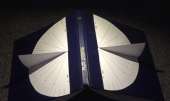






















 2018
Annual Conference from Thurs 16 Aug - Sun 19 Aug in Pittsburgh, Pennsylvania,
USA. The conference was held near the famed University of Pittsburgh campus with
its Cathedral of Learning at the Hilton Garden Inn, Pittsburgh University Place
3454 Forbes Avenue, in Pittsburgh.
2018
Annual Conference from Thurs 16 Aug - Sun 19 Aug in Pittsburgh, Pennsylvania,
USA. The conference was held near the famed University of Pittsburgh campus with
its Cathedral of Learning at the Hilton Garden Inn, Pittsburgh University Place
3454 Forbes Avenue, in Pittsburgh. 
 the
North Downs at Great Bookham, near Dorking, Surrey. Built by Thomas
Cubitt Ambrose Poynter it is a designated World Heritage site.
It has several dials the main one was stolen some years ago and a
rather poor replacement has been put in its place on the original
elegant cherubic pedestal.
the
North Downs at Great Bookham, near Dorking, Surrey. Built by Thomas
Cubitt Ambrose Poynter it is a designated World Heritage site.
It has several dials the main one was stolen some years ago and a
rather poor replacement has been put in its place on the original
elegant cherubic pedestal. 



 celebrated
its 59th Anniversary in August 2021 at a meeting in Birkenau
in the Odenwald - a small town which holds an international record
for the highest sundial density (8 sundials/square km) and a very
creditable 70 people attended..
celebrated
its 59th Anniversary in August 2021 at a meeting in Birkenau
in the Odenwald - a small town which holds an international record
for the highest sundial density (8 sundials/square km) and a very
creditable 70 people attended.. 
























 Trust property of Clumber
Park in Nottinghamshire recently suffered from a drought. The building that once
stood on here was Clumber House - a grand 18th-Century mansion which was
demolished in 1938 after a series of fires and the subsequent economic downturn.
Trust property of Clumber
Park in Nottinghamshire recently suffered from a drought. The building that once
stood on here was Clumber House - a grand 18th-Century mansion which was
demolished in 1938 after a series of fires and the subsequent economic downturn.










 Sakville-West
was an English authoress and garden designer.
Sakville-West
was an English authoress and garden designer.









































